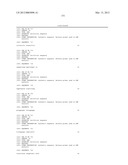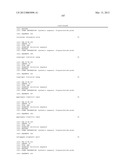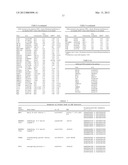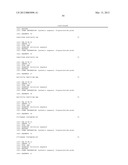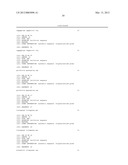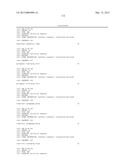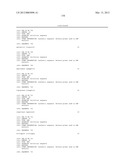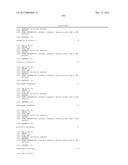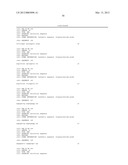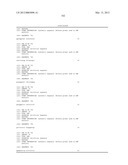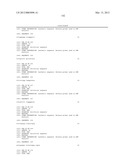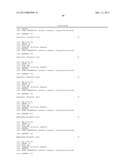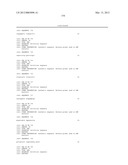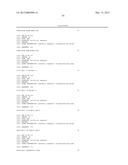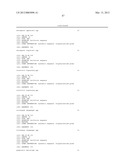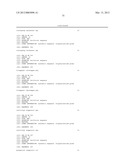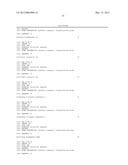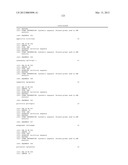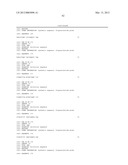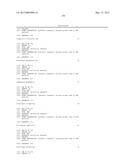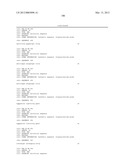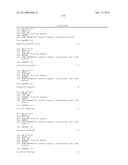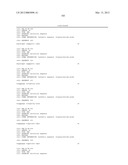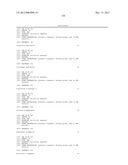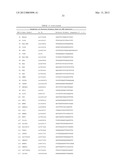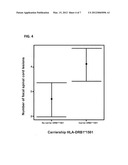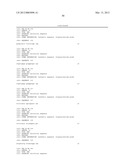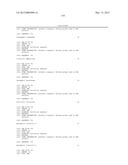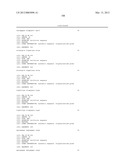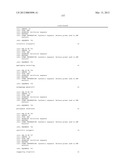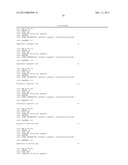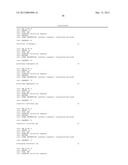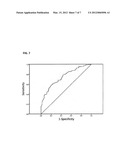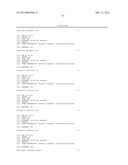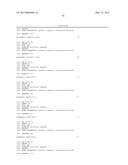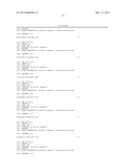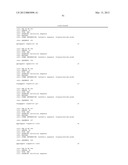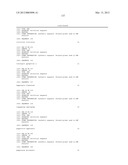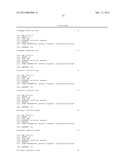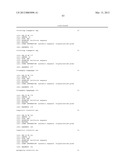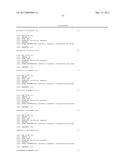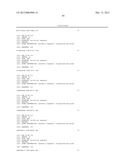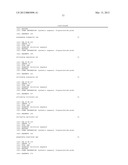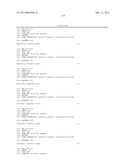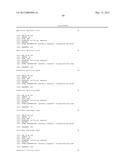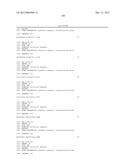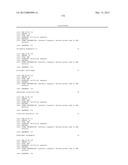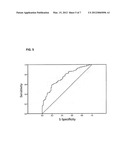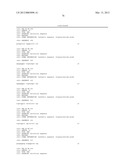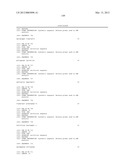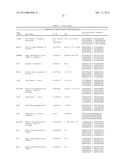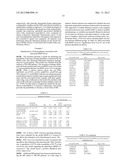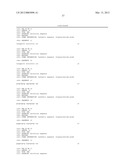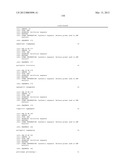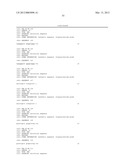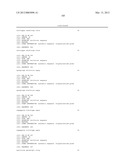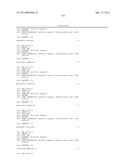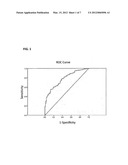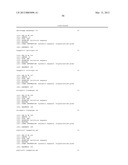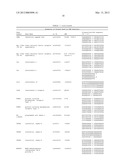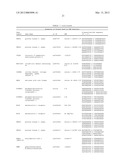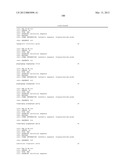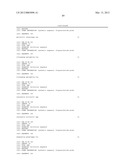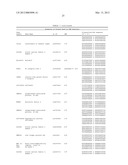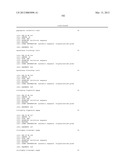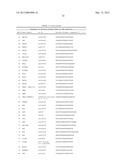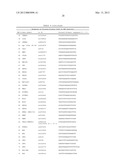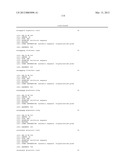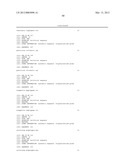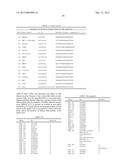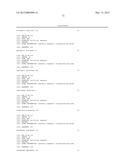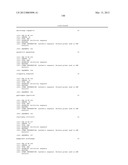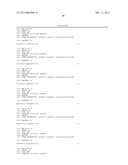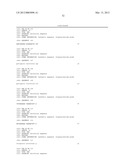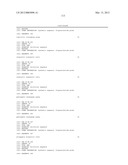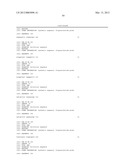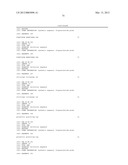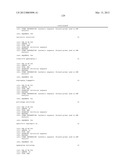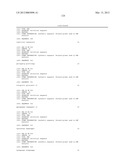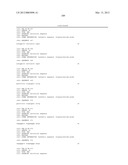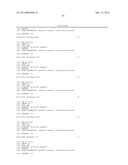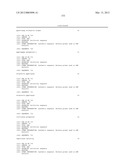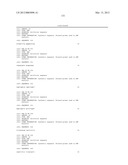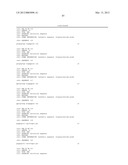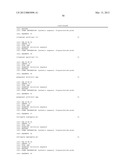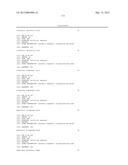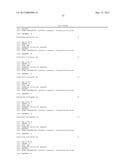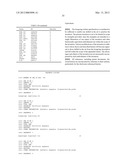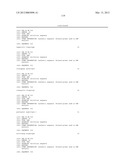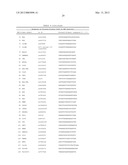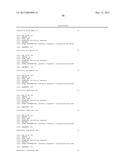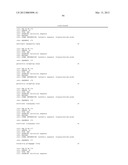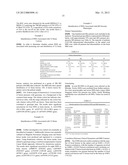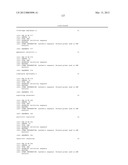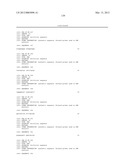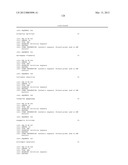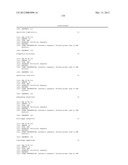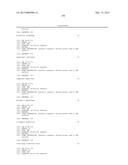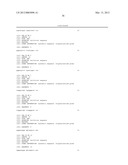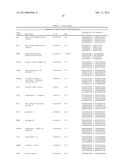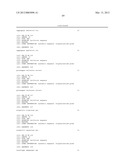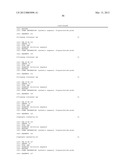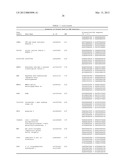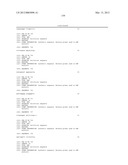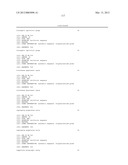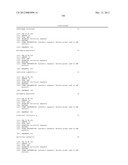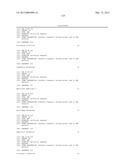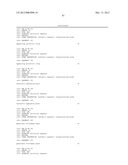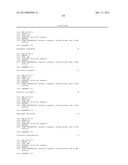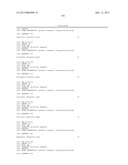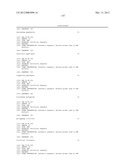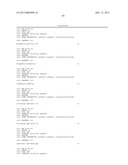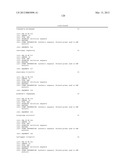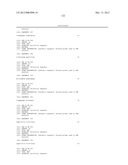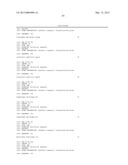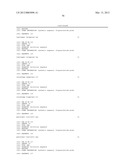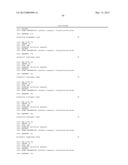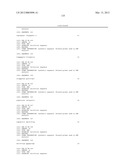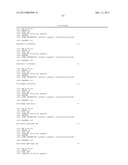Patent application title: GENOTYPING TOOL FOR IMPROVING THE PROGNOSTIC AND CLINICAL MANAGEMENT OF MS PATIENTS
Inventors:
David Arteta (Derio, ES)
Marta Artieda (Derio, ES)
Diego Tejedor (Derio, ES)
Diego Tejedor (Derio, ES)
Antonio Martinez (Derio, ES)
Antonio Martinez (Derio, ES)
Laureano Simon (Derio, ES)
Laureano Simon (Derio, ES)
Bart A. Crusius (Amsterdam, NL)
Salvador Pena (Amsterdam, NL)
Madeleine Sombekke (Amsterdam, NL)
Bernard Uitdehaag (Amsterdam, NL)
Chris Polman (Amsterdam, NL)
IPC8 Class: AC40B3004FI
USPC Class:
506 9
Class name: Combinatorial chemistry technology: method, library, apparatus method of screening a library by measuring the ability to specifically bind a target molecule (e.g., antibody-antigen binding, receptor-ligand binding, etc.)
Publication date: 2012-03-15
Patent application number: 20120065096
Abstract:
The invention relates to methods of evaluating MS severity based on
analysis of single nucleotide polymorphisms (SNPs) and to products and
kits for use in such methods. The methods include a method of assessing a
multiple sclerosis disease severity phenotype in a human subject having
multiple sclerosis, by determining the genotype of the subject at one or
more positions of single nucleotide polymorphism (SNP) selected from:
rs2107538, rs1137933, rs1318, rs2069763, rs423904, rs876493, rs10243024,
rs10259085, rs1042173, rs10492503, rs10492972, rs12047808, rs12202350,
rs12861247, rs13353224, rs1350666, rs1555322, rs1611115, rs17641078,
rs1805009, rs2028455, rs2032893, rs2049306, rs2066713, rs2074897,
rs2076530, rs2187668, rs2213584, rs2227139, rs2234978, rs2239802,
rs2395182, rs260461, rs28386840, rs3087456, rs3135388, rs3741981,
rs3756450, rs3781202, rs3787283, rs3808585, rs4128767, rs4404254,
rs4473631, rs4680534, rs6077690, rs6457594, rs6570426, rs659366,
rs6917747, rs7208257, rs7528684, rs7577925, rs762550, rs7956189,
rs7995215, rs8049651, rs8702, rs9808753 and rs987107, and/or a SNP in
linkage disequilibrium with any one of said SNPs.Claims:
1. A method of assessing a multiple sclerosis disease severity phenotype
in a human subject having multiple sclerosis, the method comprising
determining the genotype of the subject at at least 3 positions of single
nucleotide polymorphism (SNP) selected from: rs2107538, rs1137933,
rs1318, rs2069763, rs423904, rs876493, rs10243024, rs10259085, rs1042173,
rs10492503, rs10492972, rs12047808, rs12202350, rs12861247, rs13353224,
rs1350666, rs1555322, rs1611115, rs17641078, rs1805009, rs2028455,
rs2032893, rs2049306, rs2066713, rs2074897, rs2076530, rs2187668,
rs2213584, rs2227139, rs2234978, rs2239802, rs2395182, rs260461,
rs28386840, rs3087456, rs3135388, rs3741981, rs3756450, rs3781202,
rs3787283, rs3808585, rs4128767, rs4404254, rs4473631, rs4680534,
rs6077690, rs6457594, rs6570426, rs659366, rs6917747, rs7208257,
rs7528684, rs7577925, rs762550, rs7956189, rs7995215, rs8049651, rs8702,
rs9808753 and rs987107, and/or a SNP in linkage disequilibrium with any
one of said SNPs, wherein said SNPs are as disclosed in the NCBI dbSNP
build 131, Homo sapiens genome build 37.1, and wherein the presence of:
at least one T allele at rs2107538; at least one G allele at rs1137933;
at least one A allele at rs1318; at least one G allele at rs2069763; at
least one C allele at rs423904; at least one A allele at rs876493; at
least one G allele at rs10243024; at least one G allele at rs10259085; at
least one A allele at rs1042173; at least one T allele at rs10492503; at
least one G allele at rs10492972; at least one G allele at rs12047808; at
least one A allele at rs12202350; at least one G allele at rs12861247; at
least one A allele at rs13353224; at least one G allele at rs1350666; at
least one A allele at rs1555322; at least one A allele at rs1611115; at
least one G allele at rs17641078; at least one G allele at rs1805009; at
least one G allele at rs2028455; at least one A allele at rs2032893; at
least one A allele at rs2049306; at least one A allele at rs2066713; at
least one A allele at rs2074897; at least one G allele at rs2076530; at
least one A allele at rs2187668; at least one A allele at rs2213584; at
least one C allele at rs2227139; at least one T allele at rs2234978; at
least one G allele at rs2239802; at least one G allele at rs2395182; at
least one A allele at rs260461; at least one A allele at rs28386840; at
least one G allele at rs3087456; at least one A allele at rs3135388; at
least one A allele at rs3741981; at least one A allele at rs3756450; a C
allele and a T allele at rs3781202; at least one A allele at rs3787283;
at least one A allele at rs3808585; at least one G allele at rs4128767;
at least one G allele at rs4404254; at least one C allele at rs4473631;
at least one A allele at rs4680534; at least one T allele at rs6077690;
at least one A allele at rs6457594; at least one T allele at rs6570426;
at least one C allele at rs659366; at least one G allele at rs6917747; at
least one A allele at rs7208257; at least one G allele at rs7528684; at
least one A allele at rs7577925; at least one A allele at rs762550; at
least one G allele at rs7956189; at least one G allele at rs7995215; at
least one A allele at rs8049651; at least one G allele at rs8702; at
least one G allele at rs9808753; and/or at least one A allele at rs987107
is indicative of the subject having a more severe multiple sclerosis
disease phenotype.
2. A method according to claim 1, wherein the presence of: the TT genotype at rs2107538; the GG genotype at rs1137933; the AA genotype at rs1318; the GG genotype at rs2069763; the CC genotype at rs423904; the AA genotype at rs876493; the GG genotype at rs10243024; the GG genotype at rs10259085; the AA genotype at rs1042173; the TT genotype at rs10492503; the GG genotype at rs10492972; the GG genotype at rs12047808; the AA genotype at rs12202350; the GG genotype at rs12861247; the AA genotype at rs13353224; the GG genotype at rs1350666; the AA genotype at rs1555322; the AA genotype at rs1611115; the GG genotype at rs17641078; the GG genotype at rs1805009; the GG genotype at rs2028455; the AA genotype at rs2032893; the AA genotype at rs2049306; the AA genotype at rs2066713; the AA genotype at rs2074897; the GG genotype at rs2076530; the AA genotype at rs2187668; the AA genotype at rs2213584; the CC genotype at rs2227139; the TT genotype at rs2234978; the GG genotype at rs2239802; the GG genotype at rs2395182; the AA genotype at rs260461; the AA genotype at rs28386840; the GG genotype at rs3087456; the AA genotype at rs3135388; the AA genotype at rs3741981; the AA genotype at rs3756450; the CT genotype at rs3781202; the AA genotype at rs3787283; the AA genotype at rs3808585; the GG genotype at rs4128767; the GG genotype at rs4404254; the CC genotype at rs4473631; the AA genotype at rs4680534; the TT genotype at rs6077690; the AA genotype at rs6457594; the TT genotype at rs6570426; the CC genotype at rs659366; the GG genotype at rs6917747; the AA genotype at rs7208257; the GG genotype at rs7528684; the AA genotype at rs7577925; the AA genotype at rs762550; the GG genotype at rs7956189; the GG genotype at rs7995215; the AA genotype at rs8049651; the GG genotype at rs8702; the GG genotype at rs9808753; and/or the AA genotype at rs987107 is indicative of the subject having a more severe multiple sclerosis disease phenotype.
3. A method according to claim 1, wherein said more severe multiple sclerosis disease phenotype is selected from: a multiple sclerosis severity score (MSSS) of 2.5 or greater, an increase in size and/or distribution of T2 brain lesions, an increased number of focal lesions in the spinal cord, an increased T2 lesion load in the brain, and the presence of diffuse abnormalities in the spinal cord.
4. A method according to claim 1, wherein the method comprises determining the genotype of the subject at 4, 5, 6, 7, 8, 9, 10 or more of said positions of SNP.
5. A method according to claim 1, wherein the method further comprises the measurement of at least one clinical variable.
6. A method according to claim 5, wherein the at least one clinical variable is selected from: age of the subject at onset of multiple sclerosis, gender of the subject and type of multiple sclerosis at onset of multiple sclerosis.
7. A method according to claim 1, wherein the method comprises determining the genotype of the subject at at least rs2107538, rs1137933 and rs1318.
8. A method according to claim 7, wherein the method comprises determining the genotype of the subject at least rs2107538, rs1137933, rs1318, rs2069763, rs423904 and rs876493.
9. A method according to claim 1, wherein said more severe multiple sclerosis disease phenotype comprises a multiple sclerosis severity score (MSSS) of 2.5 or greater, and wherein the method comprises determining the genotype of the subject at at least 3 of the following positions of SNP: rs423904, rs876493, rs1137933, rs1318, rs2069763, rs2107538, rs3756450, rs12047808, rs10259085, rs1042173, rs6077690, rs1611115, rs4473631, rs2032893, rs2066713, rs260461, rs3787283, rs6917747, rs2049306, rs12861247, rs4404254, rs4680534, rs17641078, rs2187668, rs7528684, rs7577925, rs1805009, rs3741981, rs12202350, rs28386840, rs2028455, rs10492503, rs8049651, rs13353224, rs1555322, rs10243024 and rs6570426.
10. A method according to claim 9, wherein the method comprises determining the genotype of the subject at least the following positions of SNP: rs2107538, rs1137933, rs1318, rs2069763, rs423904 and rs876493.
11. A method according to claim 10, wherein the method further comprises determining at least 1, 2 or 3 clinical variables selected from: age of the subject at onset of multiple sclerosis, gender of the subject and type of multiple sclerosis at onset of multiple sclerosis.
12. A method according to claim 1, wherein said more severe multiple sclerosis disease phenotype comprises increased size and/or distribution of T2 brain lesions, and wherein the method comprises determining the genotype of the subject at at least 3 or 4 of the following positions of SNP: rs2213584, rs2227139, rs2076530 rs876493, rs9808753, rs2074897, rs762550, rs2234978, rs3781202,
13. A method according to claim 1, wherein said more severe multiple sclerosis disease phenotype comprises increased T2 lesion load in the brain, and wherein the method comprises determining the genotype of the subject at least 3 or 4 of the following positions of SNP: rs2107538, rs12861247, rs2074897 and rs7995215.
14. A method according to claim 13, wherein the method comprises determining the genotype of the subject at least the following positions of SNP: rs12861247, rs2074897 and rs7995215.
15. A method according to claim 1, wherein said more severe multiple sclerosis disease phenotype comprises an increased number of focal lesions in the spinal cord, and wherein the method comprises determining the genotype of the subject at at least 3 or 1 of the following positions of SNP: rs3135388, rs2395182, rs2239802, rs2227139, rs2213584, rs3087456, rs10492972, rs12202350, rs8049651, rs8702 and rs987107.
16. A method according to claim 15, wherein the method comprises determining the genotype of the subject at least the following positions of SNP: rs3135388, rs3087456 and rs2227139.
17. A method according to claim 1, wherein said more severe multiple sclerosis disease phenotype comprises the presence of diffuse abnormalities in the spinal cord, and wherein the method comprises determining the genotype of the subject at at least 3 or 4 of the following positions of SNP: rs1350666, rs3808585, rs4128767, rs6457594, rs7208257 and rs7956189.
18. A method according to claim 1, wherein the method is carried out in vitro using a nucleic acid-containing sample that has been obtained from the subject.
19. A method according to claim 1, wherein the genotype of the subject at said positions of SNP is determined indirectly by determining the genotype of the subject at a position of SNP that is in linkage disequilibrium with said positions of SNP.
20. A method according to claim 1, wherein determining the genotype of the subject at said positions of SNP comprises: (i) extracting and/or amplifying DNA from a sample that has been obtained from the subject; (ii) contacting the DNA with an array comprising a plurality of probes suitable for determining the identity of at least one allele at a position of SNP as defined in claim 1.
21. A method according to claim 20, wherein the array is a DNA array, a DNA microarray or a bead array.
22. A method according to claim 20, wherein said plurality of probes are selected from the probes listed in Table 7.
23. A method according to claim 1, wherein the method comprises amplifying DNA from a sample that has been obtained from the subject, and wherein said amplifying comprises contacting the DNA with at least one forward primer as listed in Table 8.
24. A method according to claim 1, wherein the method comprises amplifying DNA from a sample that has been obtained from the subject, and wherein said amplifying comprises contacting the DNA with at least one reverse primer as listed in Table 9.
25. An array of probes for use in a method according to claim 1, wherein the array comprises: at least 5, 10, 15, 20, 50 or more nucleic acid probes suitable for determining the identity of at least one allele at a position of SNP as defined in claim 1; and a solid support on which said probes are immobilised, wherein said probes comprise at least 50% of the total number of nucleic acid probes in the array.
26. An array according to claim 25, wherein said probes are selected from the probes listed in Table 7.
27-66. (canceled)
Description:
FIELD OF THE INVENTION
[0001] The invention relates to methods and products, in particular microarrays, for in vitro genotyping of multiple sclerosis (MS) associated genetic variations and to methods for assessment of MS disease severity.
BACKGROUND OF THE INVENTION
[0002] Multiple Sclerosis is an autoimmune chronic inflammatory disease, characterized by a progressive demyelination of the central nervous system. While its origin still remains unknown, its multifactorial etiology is well known, consisting of a clear genetic component regulated by several environmental factors.
[0003] Clinical evolution of MS is very heterogeneous, and there are different phenotypes present. These range from a very severe form where patients worsen rapidly (known as primary progressive MS), to a more benign form, where the patient practically recovers completely after each disease relapse (known as relapsing remitting MS). Nowadays, disease diagnostics is clinically based, relying on three main points: clinical history, neurologic exploration and use of several techniques (Magnetic Resonance Imaging, analysis of cerebrospinal fluid and evoked potentials).
[0004] Currently there is no treatment that will cure MS. MS therapies aim at controlling symptoms and maintaining patient's quality of life. With such treatments, the number of relapses is controlled to a certain level, allowing partial prevention of consequences that may cause such relapses. The primary aims of therapy are returning function after an attack, preventing new attacks, and preventing disability. As with any medical treatment, medications used in the management of MS have several adverse effects. Disease-modifying treatments reduce the progression rate of the disease, but do not stop it. As multiple sclerosis progresses, the symptomatology tends to increase. The disease is associated with a variety of symptoms and functional deficits that result in a range of progressive impairments and disability.
[0005] Management of these deficits is therefore very important. Both drug therapy and neurorehabilitation have shown to ease the burden of some symptoms, though neither influences disease progression. As for any patient with neurologic deficits, a multidisciplinary approach is key to limiting and overcoming disability; however, there are particular difficulties in specifying a `core team` because people with MS may need help from almost any health profession or service at some point. Similarly, for each symptom there are different treatment options. Treatments should therefore be individualized depending both on the patient and the physician.
SUMMARY OF THE INVENTION
[0006] Aspects of the invention relate to methods of analyzing a patient's genotype, for example through analysis of SNPs, optionally combined with clinical-environmental data, for prognosis and treatment management of MS patients, leading to personalized medicine.
[0007] Accordingly, in a first aspect the present invention provides a method of assessing a MS disease severity phenotype in a human subject having or suspected of having MS, the method comprising determining the genotype of the subject at one or more positions of single nucleotide polymorphism (SNP) selected from those listed in Table 10 and/or a SNP in linkage disequilibrium with any one of said SNPs. The SNPs may be as disclosed in the NCBI dbSNP build 131, Homo sapiens genome build 37.1 and/or NCBI dbSNP build 129, Homo sapiens build 36.3. The presence of one or more "risk alleles" as identified in Table 10 at one or more of the SNPs indicates that the subject has a higher probability of having a greater severity of MS. In some cases, the method of this and other aspects of the invention comprises determining that the subject does have at least one risk allele at at least one of said
[0008] SNPs. In other cases, the subject may be determined to be free from said risk alleles at at least one of said SNPs. In some cases, the method of this and other aspects of the invention, the presence of: [0009] the TT genotype at rs2107538; [0010] the GG genotype at rs1137933; [0011] the AA genotype at rs1318; [0012] the GG genotype at rs2069763; [0013] the CC genotype at rs423904; [0014] the AA genotype at rs876493; [0015] the GG genotype at rs10243024; [0016] the GG genotype at rs10259085; [0017] the AA genotype at rs1042173; [0018] the TT genotype at rs10492503; [0019] the GG genotype at rs10492972; [0020] the GG genotype at rs12047808; [0021] the AA genotype at rs12202350; [0022] the GG genotype at rs12861247; [0023] the AA genotype at rs13353224; [0024] the GG genotype at rs1350666; [0025] the AA genotype at rs1555322; [0026] the AA genotype at rs1611115; [0027] the GG genotype at rs17641078; [0028] the GG genotype at rs1805009; [0029] the GG genotype at rs2028455; [0030] the AA genotype at rs2032893; [0031] the AA genotype at rs2049306; [0032] the AA genotype at rs2066713; [0033] the AA genotype at rs2074897; [0034] the GG genotype at rs2076530; [0035] the AA genotype at rs2187668; [0036] the AA genotype at rs2213584; [0037] the CC genotype at rs2227139; [0038] the TT genotype at rs2234978; [0039] the GG genotype at rs2239802; [0040] the GG genotype at rs2395182; [0041] the AA genotype at rs260461; [0042] the AA genotype at rs28386840; [0043] the GG genotype at rs3087456; [0044] the AA genotype at rs3135388; [0045] the AA genotype at rs3741981; [0046] the AA genotype at rs3756450; [0047] the CT genotype at rs3781202; [0048] the AA genotype at rs3787283; [0049] the AA genotype at rs3808585; [0050] the GG genotype at rs4128767; [0051] the GG genotype at rs4404254; [0052] the CC genotype at rs4473631; [0053] the AA genotype at rs4680534; [0054] the TT genotype at rs6077690; [0055] the AA genotype at rs6457594; [0056] the TT genotype at rs6570426; [0057] the CC genotype at rs659366; [0058] the GG genotype at rs6917747; [0059] the AA genotype at rs7208257; [0060] the GG genotype at rs7528684; [0061] the AA genotype at rs7577925; [0062] the AA genotype at rs762550; [0063] the GG genotype at rs7956189; [0064] the GG genotype at rs7995215; [0065] the AA genotype at rs8049651; [0066] the GG genotype at rs8702; [0067] the GG genotype at rs9808753; and/or [0068] the AA genotype at rs987107 is indicative of the subject having, or having a high probability of having, a more severe multiple sclerosis disease phenotype.
[0069] In some cases, a more severe multiple sclerosis disease phenotype may be a phenotype selected from: a multiple sclerosis severity score (MSSS) of 2.5 or greater; an increase in size and/or distribution of T2 brain lesions; an increased number of focal lesions in the spinal cord; an increased T2 lesion load in the brain; and the presence of diffuse abnormalities in the spinal cord. Optionally, the method of this and other aspects of the invention may comprise determining the genotype of the subject at 2, 3, 4, 5, 6, 7, 8, 9, 10, 11, 12, 13, 14, 15, 16, 17, 18, 19, 20, 21, 22, 23, 24, 25, 26, 27, 28, 29, 30, 35, 40, 45, 50, 55 or more of said SNPs. Optionally, the method of the invention further comprises the measurement of at least one clinical variable, such as a clinical variable is selected from: age of the subject at onset of multiple sclerosis, gender of the subject and type of multiple sclerosis at onset of multiple sclerosis. The method of the invention may, in some cases, comprise determining the genotype of the subject at a specific combination or sub-set of SNPs selected from those listed in Table 10, such as the first 2, first 3, first 4, first 5 or first 6. Accordingly, in some cases, the method of the invention comprises determining the genotype of the subject at: at least rs2107538, rs1137933 and rs1318; at least rs2107538, rs1137933, rs1318, rs2069763, rs423904 and rs876493. In some cases, the method of the invention comprises determining the genotype of the subject at substantially all of the SNPs listed in Table 10. In some cases, the method of the invention comprises determining the genotype of the subject at only the SNPs listed in Table 10 and/or only SNPs in linkage disequilibrium with one or more of the SNPs listed in Table 10.
[0070] In certain cases, the method of the invention comprises determining the genotype of the subject at a sub-set of SNPs of those listed in Table 10, which sub-set is indicative of a particular MS disease severity phenotype. Methods for assessing particular MS disease severity phenotypes, such as a multiple sclerosis severity score (MSSS) of 2.5 or greater; an increase in size and/or distribution of T2 brain lesions; an increased number of focal lesions in the spinal cord; an increased T2 lesion load in the brain; and the presence of diffuse abnormalities in the spinal cord, may be combined to yield assessment of multiple specific MS disease severity phenotypes or performed independently.
[0071] In particular, the method of the invention may be for assessing multiple sclerosis severity score (MSSS), such as whether or not the subject has an MSSS score of 2.5 or greater, wherein the method comprises determining the genotype of the subject at at least 2 of the following positions of SNP: rs423904, rs876493, rs1137933, rs1318, rs2069763, rs2107538, rs3756450, rs12047808, rs10259085, rs1042173, rs6077690, rs1611115, rs4473631, rs2032893, rs2066713, rs260461, rs3787283, rs6917747, rs2049306, rs12861247, rs4404254, rs4680534, rs17641078, rs2187668, rs7528684, rs7577925, rs1805009, rs3741981, rs12202350, rs28386840, rs2028455, rs10492503, rs8049651, rs13353224, rs1555322, rs10243024 and rs6570426, wherein the presence of one or more of the risk alleles shown in Table 10 at one or more of said SNPs is indicative of having an MSSS score of 2.5 or greater. For example, the method may comprise determining the genotype of the subject at at least the following positions of SNP: rs2107538, rs1137933, rs1318, rs2069763, rs423904 and rs876493. Methods for assessing multiple sclerosis severity score (MSSS) of a subject may advantageously combine genotyping SNPs as specified above with determining at least 1, 2 or 3 clinical variables selected from: age of the subject at onset of multiple sclerosis, gender of the subject and type of multiple sclerosis at onset of multiple sclerosis. Thus, the method of the invention may comprise assessment of MSSS score utilising a model which combines the SNPs and clinical variables shown in Table 3, Table 3B and/or Table 3C, optionally employing the respective coefficient for each SNP and/or clinical variable shown in column "B" of said table or tables
[0072] In certain cases, the method of this and other aspects of the invention may be for assessing the probability of increased size and/or distribution of T2 brain lesions in the subject, wherein the method comprises determining the genotype of the subject at at least 2, 3 or 4 of the following positions of SNP: rs2213584, rs2227139, rs2076530 rs876493, rs9808753, rs2074897, rs762550, rs2234978, rs3781202.
[0073] In certain cases, the method of this and other aspects of the invention may be for assessing the probability of increased T2 lesion load in the brain, wherein the method comprises determining the genotype of the subject at at least 1, 2, 3 or 4 of the following positions of SNP: rs2107538, rs12861247, rs2074897 and rs7995215, such as determining the genotype of the subject at: rs12861247, rs2074897 and rs7995215.
[0074] In certain cases, the method of this and other aspects of the invention may be for assessing an increased number of focal lesions in the spinal cord, wherein the method comprises determining the genotype of the subject at at least 1, 2, 3 or 4 of the following positions of SNP: rs3135388, rs2395182, rs2239802, rs2227139, rs2213584, rs3087456, rs10492972, rs12202350, rs8049651, rs8702 and rs987107, such as determining the genotype of the subject at: rs3135388, rs3087456 and rs2227139.
[0075] In certain cases, the method of this and other aspects of the invention may be for assessing the presence of diffuse abnormalities in the spinal cord, wherein the method comprises determining the genotype of the subject at at least 1, 2, 3 or 4 of the following positions of SNP: rs1350666, rs3808585, rs4128767, rs6457594, rs7208257 and rs7956189.
[0076] The method in accordance with this and other aspects of the invention may, in some cases, be carried out in vitro using a nucleic acid-containing sample that has been obtained from the subject. In some cases the genotype of the subject at said one or more positions of SNP may be determined indirectly by determining the genotype of the subject at a position of SNP that is in linkage disequilibrium with said one or more positions of SNP, while in some cases the genotype of the subject at said one or more positions of SNP may be determined directly by identifying one or both alleles at said one or more positions of SNP.
[0077] In accordance with the method of this and other aspects of the invention, determining the genotype of the subject at said one or more positions of SNP may comprise: [0078] (i) extracting and/or amplifying DNA from a sample that has been obtained from the subject; [0079] (ii) contacting the DNA with an array comprising a plurality of probes suitable for determining the identity of at least one allele at a position of SNP as listed in Table 10, for example using one or more probes selected from those listed in Table 7. In some cases, the array may be a DNA array, a DNA microarray or a bead array.
[0080] In accordance with the method of this and other aspects of the invention the method may comprise amplifying DNA from a sample that has been obtained from the subject, wherein said amplifying comprises contacting the DNA with at least one forward primer as listed in Table 8 and at least one reverse primer as listed in Table 9.
[0081] In a further aspect, the present invention provides an array of probes for use in a method according to the invention, wherein the array comprises: [0082] at least 5, 10, 15, 20, 50 or more nucleic acid probes suitable for determining the identity of at least one allele at a position of SNP as listed in Table 10; and [0083] a solid support on which said probes are immobilised, wherein said probes comprise at least 50%, at least 60%, at least 70%, at least 80%, at least 90%, at least 95%, at least 99% of the total number of nucleic acid probes in the array, or essentially all of the nucleic acid probes in the array. The probes suitable for determining the identity of at least one allele at a position of SNP may be selected from the probes listed in Table 7.
[0084] In a further aspect, the present invention provides methods of evaluating disease severity in a patient having multiple sclerosis, including obtaining a DNA sample from the patient, and determining the presence or absence of two or more single nucleotide polymorphisms (SNPs) associated with severity of the disease, wherein the presence of two or more SNPs associated with severity of the disease indicates a likelihood of increased disease severity. In some embodiments the two or more SNPs associated with the disease comprise SNPs in PNMT, IL1R, CCL5, IL2, PITPNC1 or NOS2A. In certain embodiments the two or more SNPs are selected from those listed in Table 10. In certain embodiments, the two or more SNPs associated with the disease are selected from the group consisting of 2073 Intron2 C/T (rs423904), rs876493, rs1137933, rs1318, rs2069763 and rs2107538. In certain embodiments the two or more SNPs associated with the disease are selected from the group consisting of rs3135388, rs2395182, rs2239802, rs2227139, rs2213584, rs3087456 and rs2107538.
[0085] The presence or absence of two or more SNPs associated with severity of the disease can be determined by any method known in the art such as a gene chip, bead array, RFLP analysis, and/or sequencing. In some embodiments the two or more SNPs associated with the disease comprise SNPs in PNMT, IL1R, CCL5, IL2, PITPNC1 or NOS2A. In certain embodiments the two or more SNPs associated with the disease are selected from the group consisting of, rs876493, rs1137933, rs1318, rs2069763 and rs2107538. In certain embodiments the two or more SNPs associated with the disease are selected from the group consisting of rs1137933, rs1318, rs2069764 and rs2107538.
[0086] Aspects of the invention relate to SNPs associated with increased T2 lesion load in the brain. In some embodiments the SNP is associated with an increased number of focal spinal cord abnormalities. In some embodiments the two or more SNPs are in linkage disequilibrium. In certain embodiments the two or more SNPs are in linkage disequilibrium with SNPs selected from the group consisting of rs2239802, rs2213584, rs3135388, 2213584 rs2227139, rs1137933, rs1318, rs2069764 and rs2107538.
[0087] In some embodiments methods described herein further include the measurement of one or more clinical variables such as age of onset, gender, and/or type of onset of disease.
[0088] In some embodiments disease severity is based on an MS severity scale such as the Multiple Sclerosis Severity Score (MSSS) test, the Kurtzke Expanded Disability Status Scale (EDSS), or the Multiple Sclerosis Functional Composite (MSFC) measure.
[0089] In some embodiments the presence or absence of at least 6 SNPs is determined. In certain embodiments the two or more SNPs are selected from the group consisting of 2073 Intron2 C/T (rs423904), rs876493, rs1137933, rs1318, rs2069763, rs2107538, rs3135388, rs2395182, rs2239802, rs2227139, rs2213584 and rs3087456. In certain embodiments at least one of the SNPs is in linkage disequilibrium with a SNP selected from the group consisting of 2073 Intron2 C/T (rs423904), rs876493, rs1137933, rs1318, rs2069763, rs2107538, rs3135388, rs2395182, rs2239802, rs2227139, rs2213584 and rs3087456. In some embodiments methods described herein include use of one or more probe sets listed in Table 7. In some embodiments methods described herein include at least one forward primer from Table 8 and one reverse primer from Table 9.
[0090] Aspects of the invention relate to methods of designing a treatment regimen for a patient having multiple sclerosis, including obtaining a DNA sample from the patient, determining the presence or absence of two or more single nucleotide polymorphisms (SNPs) associated with severity of the disease, wherein the presence of two or more SNPs associated with severity of the disease indicates a likelihood of increased disease severity, and designing the treatment regimen based on the presence or absence of the SNPs associated with the disease. In some embodiments the treatment regimen comprises early or elevated doses of glatiramer acetate, vitamin D, interferon beta-la or -lb, natalizumab, mitoxantrone, and/or corticosteroids.
[0091] Aspects of the invention relate to methods of treating a patient having a prognosis of increased disease severity, comprising early or elevated doses of glatiramer acetate, vitamin D, interferon beta-1 a or -1 b, natalizumab, mitoxantrone, and/or corticosteroids.
[0092] Aspects of the invention relate to methods of identifying SNPs associated with severity of symptoms in multiple sclerosis, including obtaining a DNA sample from a patient having multiple sclerosis, identifying SNPs in the DNA, wherein the SNPs comprise two or more of the SNPs listed in Table 1, performing an MRI on the patient to determine spatial distribution of T2 brain lesions, T2 lesion load, presence of diffuse abnormalities and/or number of spinal cord lesions, comparing identified SNPs with the spatial distribution of T2 brain lesions, T2 lesion load, presence of diffuse abnormalities and/or number of spinal cord lesions, and identifying the SNPs that correlate with spatial distribution of T2 brain lesion, T2 lesion load, presence of diffuse abnormalities and/or number of spinal cord lesions, wherein the SNPs that correlate with spatial distribution of T2 brain lesions, T2 lesion load, presence of diffuse abnormalities and/or number of spinal cord lesions, are SNPs associated with severity of symptoms in multiple sclerosis. In some embodiments at least one of the SNPs is in linkage disequilibrium with a SNP listed in Table 1. In some embodiments identifying SNPs associated with severity of symptoms in multiple sclerosis further comprises consideration of clinical data.
[0093] Aspects of the invention relate to methods of evaluating disease severity, as measured using the Multiple Sclerosis Severity Score (MSSS) test, the Kurtzke Expanded Disability Status Scale (EDSS), and/or the Multiple Sclerosis Functional Composite measure (MSFC), in a patient having multiple sclerosis, the method including obtaining a DNA sample from the patient, and determining the presence or absence of two or more single nucleotide polymorphisms (SNPs), wherein said SNPs comprise two or more of the SNPs listed in Table 1, and wherein the presence of said two or more SNPs indicates a likelihood of increased disease severity. In some embodiments evaluating disease severity further comprises consideration of clinical data. In some embodiments at least one of the SNPs is in linkage disequilibrium with a SNP listed in Table 1.
[0094] Aspects of the invention relate to methods of evaluating the severity of spinal cord lesions in a patient having multiple sclerosis, the method including obtaining a DNA sample from the patient, and determining the presence or absence of two or more single nucleotide polymorphisms (SNPs) associated with spinal cord lesions, wherein the presence of two or more SNPs associated with spinal cord lesions indicates a likelihood of increased disease severity. In some embodiments the two or more SNPs are selected from the group consisting of rs3135388, rs2395182, rs2239802, rs2227139, rs2213584 and rs3087456. In certain embodiments one of the SNPs is rs3135388. In some embodiments the two or more SNPs are selected from the group consisting of 2073 Intron2 C/T (rs423904), rs876493, rs1137933, rs1318, rs2069763, rs2107538, rs3135388, rs2395182, rs2239802, rs2227139, rs2213584 and rs3087456. In certain embodiments at least one of the SNPs is in linkage disequilibrium with a SNP selected from the group consisting of 2073 Intron2 C/T (rs423904), rs876493, rs1137933, rs1318, rs2069763, rs2107538, rs3135388, rs2395182, rs2239802, rs2227139, rs2213584 and rs3087456.
[0095] Aspects of the invention relate to method of prognosing the likelihood of T2 lesions and/or T2 lesion load in a patient having multiple sclerosis, the method including obtaining a DNA sample from the patient, and determining the presence or absence of SNP rs2107538, wherein the presence of SNP rs2107538 indicates a likelihood of T2 lesions and/or T2 lesion load in the patient.
[0096] Aspects of the invention relate to methods where determining the presence or absence of SNPs includes (a) providing, for each genetic variation to be genotyped, at least 2 oligonucleotide probe pairs, wherein: (i) one pair consists of probes 1 and 2, and the other pair consists of probes 3 and 4; (ii) one probe in each pair is capable of hybridising to genetic variation A and the other probe in each pair is capable of hybridising to genetic variation B; (iii) each probe is provided in replicates; and (iv) the probe replicates are each coupled to a solid support; (c) amplifying and detectably labelling the target DNA; (d) contacting the target DNA with the probes under conditions which allow hybridisation to occur, thereby forming detectably labeled nucleic acid-probe hybridisation complexes, (e) determining the intensity of detectable label at each probe replica position, thereby obtaining a raw intensity value; (f) optionally amending the raw intensity value to take account of background noise, thereby obtaining a clean intensity value for each replica; and (g) applying a suitable algorithm to the intensity data from (e) or (f), thereby determining the genotype with respect to each genetic variation, wherein application of the algorithm comprises calculating an average intensity value from the intensity values for each of the replicas of each probe and wherein the algorithm uses three Fisher linear functions that characterize each of the three possible genotypes AA, AB or BB for the genetic variation.
[0097] Aspects of the invention relate to kits for evaluating severity of disease in a subject having multiple sclerosis, the kit including: (i) at least one set of probes listed in table 7; optionally (ii) instruction for genotyping analysis as described in claim H1; and optionally (iii) instructions for determining the severity MS phenotype from the outcomes. Aspects of the invention relate to PCR amplification kits comprising at least one pair of PCR primers from tables 8 and 9, a thermostable polymerase, dNTPs, a suitable buffer, and optionally instructions for use.
[0098] Further aspects of the invention relate to a computational method of deriving a probability function for use in determining an MS severity phenotype in a subject, including applying a probability function such as stepwise multiple logistic regression analysis to outcome data and phenotype data obtained from a suitable study population of individuals, wherein each individual is of known clinically determined phenotype with respect to the Multiple Sclerosis severity phenotype, thereby deriving a probability function which produces a statistically significant separation between individuals of different phenotype in the population; wherein: (i) the phenotype data comprises the known clinically determined phenotype of each individual; (ii) the outcomes data for each individual comprises the genotype of the individual at each SNP in a set of SNPs; and wherein: (a) the probability function is for distinguishing or differentially diagnosing MS severity phenotype, and the set of SNPs is selected from the set of MS severity phenotype discriminating SNPs in Table 3; (b) the probability function is for prognosing MS disease severity phenotype and the set of SNPs is selected from the set of MS disease severity discriminating SNPs in Table 3; and/or (c) the probability function is for prognosing MS disease severity phenotype and the set of SNPs is selected from the set of MS disease severity discriminating SNPs in Table 10.
[0099] The present invention includes the combination of the aspects and preferred features described except where such a combination is clearly impermissible or is stated to be expressly avoided. These and further aspects and embodiments of the invention are described in further detail below and with reference to the accompanying examples and figures.
BRIEF DESCRIPTION OF THE DRAWINGS
[0100] FIG. 1 is a graph showing a ROC (receiver operating characteristic) curve obtained for the model MSSS<2.5 versus≧2.5, showing the relationship between sensitivity (y-axis) and percentage (x-axis).
[0101] FIG. 2 depicts MRI data maps showing mean lesion frequency map of the patient sample (n=208). Lesion frequency across the patient sample is shown for every voxel on axial and sagittal slices. The colour bar indicates lesion frequency; voxels with a lesion frequency <1% are not shown; peak frequency was 32%.
[0102] FIG. 3 depicts MRI data maps showing clusterwise (t=2) associations of lesion presence with genotype, on a background of the common brain image. The cluster colour bar indicates clusterwise p-value, with the range indicated by the colour bar; only clusters with p<0.05 are shown. A: rs2213584 (HLA-DRA gene); B: rs2227139 (HLA-DRA gene); C: rs2076530 (BTNL2 gene); D: rs876493 (PNMT gene).
[0103] FIG. 4 is a graph showing the mean number of focal spinal cord lesions in patients who carry HLA-DRB1*1501 (measured as presence of A-allele of rs3135388). Difference between carriers and non-carriers p<0.001, Maim Whitney U test. Error bars show 95% confidence interval of mean.
[0104] FIG. 5 is a graph showing a ROC (receiver operating characteristic) curve obtained for the model MSSS<2.5 versus≧2.5, showing the relationship between sensitivity (y-axis) and percentage (x-axis), as further described in Table 3B.
[0105] FIG. 6 is a graph showing a ROC (receiver operating characteristic) curve obtained for the model MSSS<2.5 versus≧2.5, showing the relationship between sensitivity (y-axis) and percentage (x-axis), as further described in Table 3B.
[0106] FIG. 7 is a graph showing a ROC (receiver operating characteristic) curve obtained for the model MSSS<2.5 versus≧2.5, showing the relationship between sensitivity (y-axis) and percentage (x-axis), as further described in Table 3C.
DETAILED DESCRIPTION
[0107] Multiple Sclerosis (MS) is a multifocal inflammatory demyelinating disease of the central nervous system (CNS), characterized by inflammation, demyelination and axonal loss resulting in a highly variable clinical presentation. Most patients suffer from relapsing-remitting (RR) MS, experiencing waves of inflammation leading to alternating periods of disability (relapses) and stable disease (remissions). The RRMS phase usually leads to progressive and irreversible disability (the secondary progressive [SP] phase). For a subset of patients, the disease is progressive from onset (primary progressive [PP] MS). Treatment decisions are based on the occurrence of relapses, and the development of white matter lesions visible on MRI. Brain lesion volume and distribution however are highly variable among MS patients, and correlate only moderately with disability. As treatment guidelines would strongly benefit from a better understanding of this variability, the present invention is drawn to methods of genetic screening and predicting severity of disease using genetic information that correlates with increased numbers of lesions in the brain, optic nerve, or spinal cord.
[0108] Aspects of the invention relate at least in part to the surprising discovery that MS severity can be associated (e.g., statistically) with one or more genetic markers. As used herein, a genetic marker refers to a DNA sequence that has a known location on a chromosome. Several non-limiting examples of classes of genetic markers include RFLP (restriction fragment length polymorphism), AFLP (amplified fragment length polymorphism), RAPD (random amplification of polymorphic DNA), VNTR (variable number tandem repeat), microsatellite polymorphism, SNP (single nucleotide polymorphism), STR (short tandem repeat), and SFP (single feature polymorphism).
[0109] In some embodiments, genetic markers associated with the invention are SNPs. As used herein a SNP or "single nucleotide polymorphism" refers to a specific site in the genome where there is a difference in DNA base between individuals. In some embodiments the SNP is located in a coding region of a gene. In other embodiments the SNP is located in a noncoding region of a gene. In still other embodiments the SNP is located in an intergenic region. It should be appreciated that SNPs exhibit variability in different populations. In some embodiments, a SNP associated with the invention may occur at higher frequencies in some ethnic populations than in others. In some embodiments, SNPs associated with the invention are SNPs that are linked to MS. In certain embodiments a SNP associated with the invention is a SNP associated with a gene that is linked to MS. A SNP that is linked to MS may be identified experimentally. In other embodiments a SNP that is linked to MS may be identified through accessing a database containing information regarding SNPs. Several non-limiting examples of databases from which information on SNPs or genes that are associated with human disease can be retrieved include: NCBI resources, The SNP Consortium LTD, NCBI dbSNP database, International HapMap Project, 1000 Genomes Project, Glovar Variation Browser, SNPStats, PharmGKB, GEN-SniP, and SNPedia. In some embodiments, SNPs associated with the invention comprise two or more of the SNPs listed in Table 1 and/or Table 10. In some embodiments 1, 2, 3, 4, 5, 6, 7, 8, 9, 10, 11, 12, 13, 14, 15, 16, 17, 18, 19, 20, 21, 22, 23, 24, 25, 26, 27, 28, 29, 30 or more than 30 SNPs are evaluated in a patient sample. In some embodiments, multiple SNPs are evaluated simultaneously while in other embodiments SNPS are evaluated separately.
[0110] SNPs are identified herein using the rs identifier numbers in accordance with the
[0111] NCBI dbSNP database, which is publically available at: http://www.ncbi.nlm.nih.gov/projects/SNP/. As used herein, rs numbers refer to the dbSNP build 129, Homo sapiens build 36.3 available from 14 Apr. 2008 and/or dbSNP build 131, Homo sapiens build 37.1 available from 2 February 2010. Except where indicated otherwise, the rs identifiers are identical for dbSNP build 129, Homo sapiens build 36.3 and dbSNP build 131, Homo sapiens build 37.1.
[0112] In some embodiments, SNPs in linkage disequilibrium with the SNPs associated with the invention are useful for obtaining similar results. As used herein, linkage disequilibrium refers to the non-random association of SNPs at two or more loci. Techniques for the measurement of linkage disequilibrium are known in the art. As two SNPs are in linkage disequilibrium if they are inherited together, the information they provide is correlated to a certain extent. SNPs in linkage disequilibrium with the SNPs included in the models can be obtained from databases such as HapMap or other related databases, from experimental setups run in laboratories or from computer-aided in-silico experiments. Determining the genotype of a subject at a position of SNP as specified herein, e.g. as specified by NCBI dbSNP rs identifier, may comprise directly genotyping, e.g. by determining the identity of the nucleotide of each allele at the locus of SNP, and/or indirectly genotyping, e.g. by determining the identity of each allele at one or more loci that are in linkage disequilibrium with the SNP in question and which allow one to infer the identity of each allele at the locus of SNP in question with a substantial degree of confidence. In some cases, indirect genotyping may comprise determining the identity of each allele at one or more loci that are in sufficiently high linkage disequilibrium with the SNP in question so as to allow one to infer the identity of each allele at the locus of SNP in question with a probability of at least 90%, at least 95% or at least 99% certainty.
[0113] As used herein MS or multiple sclerosis refers to a progressive neurodegenerative disease involving demyelination of nerve cells. Several non-limiting classifications of MS include: relapsing-remitting (RRMS) (typically characterized by partial or total recovery after attacks (also called exacerbations, relapses, or flares)), secondary progressive MS (SPMS) (generally characterized by fewer relapses, with an increase in disability and symptoms), and primary progressive MS (PPMS) (generally characterized by progression of symptoms and disability without remission).
[0114] Some non-limiting examples of symptoms of MS include: fatigue (also referred to as MS lassitude), muscle fatigue, paresthesias, difficulty in walking and/or balance problems, abnormal sensations such as numbness, prickling, or "pins and needles", pain, bladder dysfunction, bowel dysfunction, changes in cognitive function (including problems with memory, attention, concentration, judgment, and problem-solving), dizziness and vertigo, emotional problems (e.g., depression), sexual dysfunction, and vision problems. In some embodiments, symptoms of MS can include partial or complete paralysis (such as blurred or double vision, red-green color distortion, or blindness in one eye), headache, hearing loss, itching, seizures, spasticity, speech and swallowing disorders, and tremors. In some embodiments, clinical symptoms of MS can include increased CD4:CD8 cell ratio compared to normal, decreased number of CD 14+ cells compared to normal, increased expression of HLA-DR on CD14+ cells compared to normal CD14+ cells, increased levels of activated monocytes or macrophages compared to normal, the presence of proliferating macrophages, and decreased serum IgG and/or IgM compared to normal, where "normal" as used in this context refers to a subject who does not have MS.
[0115] Previous studies have explored patterns of spatial lesion distribution in MS patients. Without wishing to be bound by any theory, one potential factor underlying differences in lesion burden and spatial lesion distribution among MS patients may be found in pathological and immunological heterogeneity: studies on spatial lesion distribution throughout the brain demonstrated differences in lesion distribution across disease types and across lesion types. These findings of distinct lesion distributions across patient subgroups and lesion types suggest that different subtypes of pathology exist in MS based at least in part on different immunological mechanisms. For example, periventricular predilection of MS lesions may be caused at least in part by differences in the vasculature compared to other regions, making this location vulnerable to pathological changes. Without wishing to be bound by any theory, enhanced lesions in peripheral as opposed to central brain regions may be caused, at least in part, by central lesions developing from progressive gliosis and peripheral lesions being more inflammatory. As lesions in different locations may have different immunological backgrounds, they may warrant different treatment mechanisms. Results described herein suggest that differences in immunological backgrounds of lesion formation among MS patients may be driven by genetic predisposition.
[0116] Aspects of the invention relate to a large-scale study investigating the genetic influences on different phenotypes of MS (disease severity, subtype, MRI characteristics, response to treatment). Described herein is an investigation into the correlation between genetic background and spatial lesion distribution in a large cohort of MS patients using a variety of SNPs.
[0117] Aspects of the invention relate to evaluating the severity of MS in a patient. One symptom associated with MS is the presence of demyelination (lesions or plaques) in the brain and/or spinal cord of a patient. It should be appreciated that regions of demyelination may be detected through any means known to one of ordinary skill in the art. In some embodiments, lesions are detected through MRI. In some embodiments treatment decisions regarding a patient with MS, are based on the occurrence of relapses and the development of white matter lesions visible on MRI. Brain lesion volume and distribution, however, are highly variable among MS patients and correlate only moderately with disability. Treatment guidelines would benefit from a better understanding of this variability. Differences in genetic background may lead to different lesion distribution, which in turn may lead to a different clinical expression of the disease. Thus, the correlations revealed herein, between the presence of specific genetic markers and the presence of lesions offer important applications for screening of patients who have or are at risk of MS, diagnostic and prognostics for MS patients, as well as development of appropriate therapeutic approaches. As used herein, the term disease severity refers to the evaluation of a patient's disability using the tests listed above or other similar tests known in the art. An assessment of disease severity in some embodiments includes determining rapidity of development of disability, disease duration, rate of progression or relapse of symptoms, and symptoms such as changes in sensation, fatigue, pain, muscle weakness and/or spasm, problems in speech, visual problems, difficulty in moving, difficulties with coordination and balance, bladder and bowel difficulties and cognitive impairment.
[0118] Several methods have been established for assessing the severity of MS based on analysis of clinical factors such as those in Table 2, below. Non-limiting examples of tests used to assess the severity of MS include the Kurtzke Expanded Disability Status Scale (EDSS), the Multiple Sclerosis Functional Composite measure (MSFC), and the Multiple Sclerosis Severity Score (MSSS). The MSSS test relates scores on the Expanded Disability Status Scale (EDSS) to the distribution of disability in patients with comparable disease durations. Effectively the MSSS assigns to each EDSS its median decile score within this distribution. For example, an MSSS of 5.0 indicates the disease is progressing at the median rate. A patient whose MSSS is 9.0 is a fast progressor, progressing faster than 90% of patients. A patient whose MSSS is 1.0 is a slow progressor, progressing faster than just 10% of patients. In some embodiments, based on the MSSS test a patient may be assigned a median docile score of 1, 2, 3, 4, 5, 6, 7, 8, 9, or 9.5, including any intermediate values. In some embodiments, based on a test such as the MSSS test, MS patients are allocated into severe and benign subgroups. In some embodiments, MS patients are classified into different categories of severity based on a test such as MSSS. In some embodiments MS patient may be classified as relapsing-remitting (RRMS), secondary progressive MS (SPMS), and primary progressive MS (PPMS).
[0119] The invention in one aspect presents a model for assessing the strength of the disability, or the severity of the form of MS, according to the MSSS scale, using SNP analysis, thus allowing differential treatment management for a given patient. Results described herein generate a model from the analysis of 605 MS patients and 700 MS patients (see Example section). In some aspects, the invention evaluates differences between patients that have an MSSS score of less than 2.5 versus patients that have an MSSS score 2.5 or greater. Aspects of the invention relate to using genetic markers that are correlated to certain degrees of MS severity as predictive of MS severity and as indicators of recommended therapeutic approaches. In some embodiments, methods described herein relate to screening a patient for one or more risk factors associated with MS. In some embodiments the presence of two or more of the SNPs described herein indicate a more severe form of MS.
[0120] The invention in one aspect relates to correlating specific SNPs or combinations of SNPs with the presence and/or severity of lesions in the brain and/or spinal cord. The SNPs or combinations of SNPs that are correlated to the presence and/or severity of lesions in the brain and/or spinal cord can be used as predictive, diagnostic or prognostic indicators of the presence and/or severity of lesions in the brain and/or spinal cord. The detection of such SNPs, indicating the presence of lesions in the brain and/or spinal cord may in some embodiments be used as an indicator of the severity of MS.
[0121] Aspects of the invention relate to determining the presence of SNPs through obtaining a patient DNA sample and evaluating the patient sample for the presence of two or more SNPs. It should be appreciated that a patient DNA sample can be extracted, and a SNP can be detected in the sample, through any means known to one of ordinary skill in art. Some non-limiting examples of known techniques include detection via restriction fragment length polymorphism (RFLP) analysis, planar microarrays, bead arrays, sequencing, single strand conformation polymorphism analysis (SSCP), chemical cleavage of mismatch (CCM), and denaturing high performance liquid chromatography (DHPLC).
[0122] In some embodiments, a SNP is detected through PCR amplification and sequencing of the DNA region comprising the SNP. In some embodiments SNPs are detected using microarrays. Microarrays for detection of genetic polymorphisms, changes or mutations (in general, genetic variations) such as a SNP in a DNA sequence, comprise a solid surface, typically glass, on which a high number of genetic sequences are deposited (the probes), complementary to the genetic variations to be studied. Using standard robotic printers to apply probes to the array a high density of individual probe features can be obtained, for example probe densities of 600 features per cm2 or more can be typically achieved. The positioning of probes on an array is precisely controlled by the printing device (robot, inkjet printer, photolithographic mask etc) and probes are aligned in a grid. The organisation of probes on the array facilitates the subsequent identification of specific probe-target interactions. Additionally it is common, but not necessary, to divide the array features into smaller sectors, also grid-shaped, that are subsequently referred to as sub-arrays. Sub-arrays typically comprise 32 individual probe features although lower (e.g. 16) or higher (e.g. 64 or more) features can comprise each subarray.
[0123] In some embodiments, detection of genetic variation such as the presence of a SNP involves hybridization to sequences which specifically recognize the normal and the mutant allele in a fragment of DNA derived from a test sample. Typically, the fragment has been amplified, e.g. by using the polymerase chain reaction (PCR), and labelled e.g. with a fluorescent molecule. A laser can be used to detect bound labelled fragments on the chip and thus an individual who is homozygous for the normal allele can be specifically distinguished from heterozygous individuals (in the case of autosomal dominant conditions then these individuals are referred to as carriers) or those who are homozygous for the mutant allele. In some embodiments, the amplification reaction and/or extension reaction is carried out on the microarray or bead itself.
[0124] In some embodiments, methods described herein may involve hybridization. For differential hybridization based methods there are a number of methods for analysing hybridization data for genotyping:
[0125] Increase in hybridization level: The hybridization levels of probes complementary to the normal and mutant alleles are compared.
[0126] Decrease in hybridization level: Differences in the sequence between a control sample and a test sample can be identified by a decrease in the hybridization level of the totally complementary oligonucleotides with a reference sequence. A loss approximating 100% is produced in mutant homozygous individuals while there is only an approximately 50% loss in heterozygotes. In Microarrays for examining all the bases of a sequence of "n" nucleotides ("oligonucleotide") of length in both strands, a minimum of "2n" oligonucleotides that overlap with the previous oligonucleotide in all the sequence except in the nucleotide are necessary. Typically the size of the oligonucleotides is about 25 nucleotides. However it should be appreciated that the oligonucleotide can be any length that is appropriate as would be understood by one of ordinary skill in the art. The increased number of oligonucleotides used to reconstruct the sequence reduces errors derived from fluctuation of the hybridization level. However, the exact change in sequence cannot be identified with this method; in some embodiments this method is combined with sequencing to identify the mutation.
[0127] Where amplification or extension is carried out on the microarray or bead itself, three methods are presented by way of example:
[0128] In the Minisequencing strategy, a mutation specific primer is fixed on the slide and after an extension reaction with fluorescent dideoxynucleotides, the image of the Microarray is captured with a scanner.
[0129] In the Primer extension strategy, two oligonucleotides are designed for detection of the wild type and mutant sequences respectively. The extension reaction is subsequently carried out with one fluorescently labelled nucleotide and the remaining nucleotides unlabelled. In either case the starting material can be either an RNA sample or a DNA product amplified by PCR.
[0130] In the Tag arrays strategy, an extension reaction is carried out in solution with specific primers, which carry a determined 5' sequence or "tag". The use of Microarrays with oligonucleotides complementary to these sequences or "tags" allows the capture of the resultant products of the extension. Examples of this include the high density Microarray "Flex-flex" (Affymetrix).
[0131] For cost-effective genetic diagnosis, in some embodiments, the need for amplification and purification reactions presents disadvantages for the on-chip or on-bead extension/amplification methods compared to the differential hybridization based methods. However the techniques may still be used to detect and diagnose conditions according to the invention.
[0132] Typically, Microarray or bead analysis is carried out using differential hybridization techniques. However, differential hybridization does not produce as high specificity or sensitivity as methods associated with amplification on glass slides. For this reason the development of mathematical algorithms, which increase specificity and sensitivity of the hybridization methodology, are needed (Cutler D J, Zwick M E, Carrasquillo M N, Yohn C T, Tobi K P, Kashuk C, Mathews D J, Shah N, Eichler E E, Warrington J A, Chakravarti A. Genome Research; 11 :1913-1925 (2001). Methods of genotyping using microarrays and beads are known in the art.
[0133] Some non-limiting examples of genotyping and data analysis can be found in co-pending patent application U.S. Ser. No. 11/813,646 (WO 2006/075254), which is hereby incorporated by reference. In some embodiments the genotypes are determined as follows: The signal from the probes which detect the different genetic variations is determined with a scanner. The scanner software executes a function to subtract the local background noise from the absolute signal intensity value obtained for each probe. Next, the replicates for each of the 4 probes that are used to characterize each genetic variation are grouped. The average intensity value for each of 4 probes is calculated using the average collated from the replicates in order to identify abnormal values (outliers) that can be excluded from further consideration. Once the average intensity value for each of the probes is known then two ratios are calculated (ratio 1 and ratio 2):
Ratio 1 = Average intensity for probe 1 Average intensity for probe 1 + Average intensity for probe 2 ##EQU00001## Ratio 2 = Average intensity for probe 3 Average intensity for probe 3 + Average intensity for probe 4 ##EQU00001.2##
wherein probe 1 detects (is capable of specifically hybridising to) genetic variation A (e.g. a normal allele), probe 2 detects (is capable of specifically hybridising to) genetic variation B (e.g. a mutant allele), probe 3 detects (is capable of specifically hybridising to) genetic variation A (e.g. a normal allele) and probe 4 detects (is capable of specifically hybridising to) genetic variation B (e.g. a mutant allele).
[0134] These ratios are substituted in three Fisher linear functions which characterize each one of the three possible genotypes:
TABLE-US-00001 AA Function 1 AB Function 2 BB Function 3
[0135] The function which presents the highest absolute value determines the genotype of the patient.
[0136] The Fisher linear functions are obtained by analyzing 3 subjects for each of the three possible genotypes of the genetic variation (AA, AB, BB). With the results, ratios 1 and 2 are calculated for the SNPs analyzed and for the 3 subjects. These ratios are classification variables for the three groups to create the linear functions, with which the discriminatory capacity of the two pairs of designed probes is evaluated. If the discriminatory capacity is not 100%, the probes are redesigned. New subjects characterized for each of the three genotypes make up new ratios 1 and 2 to perfect the linear functions and in short, to improve the discriminatory capacity of the algorithm based on these three functions.
[0137] When using a fluorescent laser, to obtain reliable results it is preferable that ratios 1 and 2 are within the range of the ratios used to build the groups.
[0138] Again when a fluorescent scanner is used in the experiment, for a complete hybridization to be considered reliable preferably the ratio of probe fluorescence intensity to background noise of all the beads DNA array probes is above 15. Likewise, the average of all the ratios is preferably above 0.6 and the negative control is preferably less than or equal to 3 times the background noise.
[0139] In summary, four probes are presented in the hybridization analysis for detection of each mutation. Two of the probes detect one genetic variation (A) and the other two the other genetic variation (B). The examined base is located in the central position of the probes.
[0140] A subject homozygous for the genetic variation A will not show genetic variation B. Consequently, the probes which detect genetic variation B will show a hybridization signal significantly less than that shown by variation A and vice versa. In this case the ratios 1 and 2 will show 1 and the subjects will be assigned as homozygous AA by the software analysis.
[0141] On the other hand, a heterozygous subject for the determined genetic variation shows both the genetic variations. Therefore, the probes which detect them show an equivalent hybridization signal. The ratios 1 and 2 will show 0.5 and the subject will be assigned as heterozygous AB the software analysis as described.
[0142] In one aspect of the invention, DNA polymorphisms are selected based on their association with the etiology of MS, such as those shown in Table 1 below:
TABLE-US-00002 TABLE 1 Gene RefSNP accession I.D. ACCN1 rs28936 ACE rs4343 ADAMTS14 rs4747075 ADAMTS14 rs7081273 ADAMTS14 rs4746060 ALK rs7577363 ANKRD15 rs10975200 Apo I/Fas rs1800682 Apo I/Fas rs3781202 Apo I/Fas rs2234978 BDNF rs6265 BTNL2 rs2076530 C10orf27 rs2254174 C10orf27 rs12221473 C10orf27 rs12221474 C10orf27 rs2791196 CACNG4 rs4790896 CBLB rs12487066 CCL11 rs17735961 CCL14 rs854682 CCL17 rs223828 CCL2 rs1024610 CCL22 rs4359426 CCL23 rs1003645 CCL23 rs854655 CCL5 rs2107538 CCL5 rs2280788 CCR5 rs333 CD14 rs2569190 CD226 rs763361 CD24 rs8734 CD58 rs12044852 CNTF rs1800169 CRYAB rs14133 CRYAB rs762550 CRYAB rs2234702 CTLA4 rs231775 CTLA4 rs5742909 CTSS rs1136774 CTSS rs3754212 CXLCL10 rs3921 CXLCL10 rs8878 DBC1 rs10984447 DRB1 rs3135388 EBF rs1368297 EVI5 rs10735781 EVI5 rs6680578 FAM69A rs11164838 FAM69A rs7536563 GABBRA1 rs1805057 GLO1 rs2736654 GR rs6189 GR rs6190 HELZ rs2363846 HFE rs1800562 HLA rs2395166 HLA rs2213584 HLA rs2227139 HLA rs3135388 HLA rs9268458 HLA rs6457594 HLA-DRA rs2395182 HLA-DRA rs2239802 ICOS rs4404254 ICOS rs10932036 ICOS rs4675379 IFI30 rs11554159 IFNAR rs1012334 IFNAR1 rs2257167 IFNG rs1861494 IFNG rs2069727 IFNG rs2430561 IFNG rs3181034 IFNG rs7954499 IFNGR2 rs9808753 IKBL rs3130062 IL10 rs1800871 IL10 rs1800872 IL10 rs1800896 IL1A rs1800587 IL1B rs1799916 IL1B rs1143627 IL1B rs1143634 IL1RN 2073 Intron2 C/T (rs423904) IL1RN rs419598 IL2 rs2069763 IL2 rs2069762 IL23R rs7517847 IL23R rs11209026 IL2RA rs12722489 IL2RA rs2104282 IL4R rs1801275 IL5RA rs2290608 IL7R rs11567685 IL7R rs7718919 IL7R rs11567686 IL7R rs6897932 IL7R rs3194051 IL7R rs987106 IL7R rs987107 IL7R rs11567685 IL7R rs7718919 IL7R rs11567686 IL8 rs4073 IRF1 rs2070721 IRF5 rs3807306 IRF5 rs4728142 IRF5 5 bp insertion-deletion polymorphism located in the promoter and first intron of the IRF5 gene IRF-5 rs10954213 IRF-5 rs2004640 IRF-5 rs2280714 IRF-5 rs3757385 ITGA4 rs1449263 KCNH7 rs2068330 KIAA0350 rs6498169 KLC1 rs8702 KLRB1 rs4763655 LAG3 rs1922452 LAG3 rs870849 LAG3 rs951818 LAG3 rs19922452 LMP7 rs2071543 MBP rs470929 MC1R rs1805009 MC1R rs1805006 MEFV rs28940577 MGC33887 rs987931 MHC2TA rs4774 MHC2TA rs3087456 MOG rs2857766 MOG rs3130250 MOG rs3130253 MxA rs2071430 NDUFA7 rs2288414 NDUFA7 rs561 NDUFS5 rs2889683 NDUFS5 rs6981 NDUFS7 rs2074897 NOS2A rs1137933 NOS2A rs2779248 NOTCH4 rs367398 NR4A2 rs1405735 OAS1 rs10774071 OAS1 rs3741981 (rs1131454 in version. 37.1) PD-1 rs11568821 PDE4B rs1321172 PITPNC1 rs1318 PITPNC1 rs2365403 PNMT rs876493 PON rs854560 PPARG rs1801282 PRKCA rs7220007 PRKCA rs887797 PRKCA rs2078153 PRKCA rs3890137 PTPN22 rs2476601 PTPRC rs17612648 PTPRC rs4915154 PVRL2 rs394221 RPL5 rs6604026 SELE rs1805193 SELE rs5361 SPARCL1 rs1049544 Spp1 rs1126616 Spp1 rs1126772 Spp1 rs2853744 Spp1 rs9138 Spp1 rs4754 STAT1 rs1547550 STAT1 rs2066802 TAC1 rs2072100 TAC1 rs7793277 TGFB1 rs1800469 TGFB1 rs1800470 TGFB1 rs1800471 TGFB1 rs1982073 TNF-alpha rs1800629 TRAIL rs1131568 TRIF (TICAM1) rs1046673 TRIF (TICAM1) rs2292151 UCP2 rs659366 VDR rs10735810 VDR rs1544410 VDR rs731236
[0143] Each individual in the study population is tested to determine an outcome for each of the discriminating variables for the particular phenotype. This provides a number of outcomes for each individual. Testing, e.g. genotyping, may be carried out by any of the methods described herein, e.g. by microarray analysis as described herein. Testing is typically ex vivo, carried out on a suitable sample obtained from an individual.
[0144] Multiple genotype-phenotype associations may then be analysed using stepwise multivariate logistic regression analysis, using as the dependent variable the clinically determined MS phenotype and as independent variables the outcomes of the informative variables. The goodness of fit of the models obtained may be evaluated using Hosmer-Lemeshow statistics and their accuracy assessed by calculating the area under the curve (AUC) of the Receiver Operating Characteristic curve (ROC) with 95% confidence intervals (see, e.g. (Janssens A C J W et al., 2006)).
[0145] Mean probability function values for each of the alternative phenotypes in the population can be compared using a t test. In general the probability functions are able to distinguish between the different phenotypes in the study population in a statistically significant way, for example, at p≦0.05 in a t-test. Thus the probability functions produce a statistically significant separation between individuals of different phenotype in the population.
[0146] In some embodiments, the presence of two or more genetic markers in a sample from an MS patient is compared to the presence of two or more genetic markers in a control sample. In some embodiments a control sample is a sample from an individual who does not have MS. In other embodiments a control sample is a sample from an individual who has MS. In certain embodiments, a control sample is a sample from an individual who has MS of a specified classification or degree of severity. It will be understood that the interpretation of a comparison between a test sample and a control sample will depend on the nature of both samples. One possible measurement of the level of expression of genetic markers in a sample is the absolute number of genetic markers identified in a sample. Another measurement of the level of expression of genetic markers in a sample is a measurement of the specific combination of genetic markers in a sample.
[0147] In some embodiments, a control value may be a predetermined value, which can take a variety of forms. It can be a single cut-off value, such as a median or mean. It can be established based upon comparative groups, such as in groups not having MS, or groups have specified classifications or levels of severity of MS. For example, in some embodiments, a control sample that is taken from an individual who does not have MS, may be considered to exhibit control or normal patterns of expression of genetic markers for MS. In some embodiments where severity of MS is being assessed, a control sample that is taken from an individual that has a specified classification or level of severity of MS, such as a mild form of MS, may be considered to exhibit a normal or control pattern of expression of markers for MS. In some embodiments a control sample will be from an individual who is of the same ethnic background, gender, age, MS classification and/or MS disease duration as the individual who is being screened and/or diagnosed.
[0148] Based at least in part on results of correlations and methods discussed herein, predetermined values can be arranged. For example, test samples and subjects from which the samples were extracted can be divided into groups such as low-severity, medium-severity, and high-severity groups based on the presence of two or more genetic markers that are correlated to MS severity. In some embodiments the classification of a sample and subject into a group can be used to aid or assist in screening, diagnosis, prognosis or development of a treatment strategy for a given subject.
[0149] Described herein are correlations between the presence of specific genetic markers and the severity of symptoms of MS in a patient. Such correlations and methods for detecting such correlations have widespread applications for MS patients. In some embodiments methods described herein are used to screen patients who have or are at risk of having MS. In some embodiments, evaluation of the presence of two or more SNPs in a patient will be used to assist in the diagnosis or to indicate or evaluate the severity of MS in the patient. In some embodiments, genetic information obtained from methods described herein will be combined with other clinical data to assess the severity of MS in a given patient.
[0150] In some embodiments, the identification of two or more SNPs in a DNA sample from an MS patient will be used to initiate or change a treatment regimen for the patient. For example, in some embodiments, detection of two or more SNPs that are associated with increased severity of MS may cause a physician to change the treatment strategy of an MS patient in order to target a more severe form of the disease, or advise a patient that they may benefit from a change in treatment strategy. In some embodiments, detection of two or more SNPs that are associated with increased severity of MS may cause a physician to monitor an MS patient more closely or rigorously. In some embodiments, detection of two or more SNPs that are associated with increased severity of MS may cause a physician to recommend or advise that a patient undergo genetic counselling.
[0151] In some aspects of the invention measurement of clinical variables comprises part of the severity prediction model along with the genetic variables in Table 1, above. Some non-limiting examples are age at onset, gender of patient studied, and type of onset of the disease (e.g. progressive or relapsing) (see Table 2). Age at onset refers to the age in years at which the patient was diagnosed with MS. In the present models this measure has been treated as a continuous variable, which is included in the logistic regression function of the models. Thus an outcome for this variable is age of patient when diagnosed for MS.
[0152] Gender refers to the gender of the patient diagnosed with MS. In the present models this measure has been treated as a categorical variable, with levels "male" and "female", which is included in the logistic regression function of the models. Thus an outcome for this variable is gender of patient diagnosed with MS. If the gender is male, this is coded as (1), and if the gender is female, this is coded as (0).
[0153] Type of onset refers to the type of onset of disease, progressive or relapsing, for the studied patient diagnosed with MS. In the present models this measure has been treated as a categorical variable, which is included in the logistic regression function of the models. Thus an outcome for this variable is age of patient when diagnosed for MS. If the type of onset is progressive, this is coded as (1), and if the type of onset is relapsing, this is coded as (0).
TABLE-US-00003 TABLE 2 Clinical Variables Variable Variable Type Age at onset (Age_at_onset) Continuous variable Gender Categorical variable Onset type (Onsettype_cod) Categorical variable
[0154] In embodiments comprising methods of evaluation of MS severity in a patient, the method typically comprises determining or obtaining for the subject, an outcome for each of the variables listed in Table 2. In some embodiments, use of the results of the measurements of these variables, along with the variables in Table 1, allows prognosis of MS severity phenotype in a Dutch population with an LR+ of 8.4. Details for the calculation of a probability function using these variables are given in Table 3.
[0155] Preferably the number and combination of variables such as SNPs used to construct a model for predicting a phenotype according to the invention, is such that the model allows prediction to be made with an LR+ value of at least 1.5, such as at least 2, 3, 4, 5, 6, 7, 8, 9, or 10. Calculation of LR+ values is described herein.
[0156] Once an outcome is determined for each of the variables for prediction of a given phenotype, these outcomes are used in or inserted in a suitable probability function (for prediction of that phenotype), as described herein and a probability function value is calculated. Outcomes may be codified for use in the probability function and calculation of the probability function value. The probability function value is then compared with probability function values obtained for a population of individuals of known (clinically determined) phenotype. The risk of the subject having or developing the particular phenotype is thereby determined.
[0157] The sensitivity, specificity, and positive likelihood ratio (LR+=sensitivity/(1-specificity)) may be computed by means of ROC curves. Preferably the model has an LR+ value of at least 1.5, for example, at least 2, 3, 4, 5, 6, 7, 8, 9 or 10.
[0158] Also within the scope of the invention are kits and instructions for their use. In some embodiments kits associated with the invention are kits for identifying two or more SNPs within a patient sample. In some embodiments a kit may contain primers for amplifying a specific genetic locus. In some embodiments, a kit may contain a probe for hybridizing to a specific SNP. A kit of the invention can include a description of use of the contents of the kit for participation in any biological or chemical mechanism disclosed herein. A kit can include instructions for use of the kit components alone or in combination with other methods or compositions for assisting in screening or diagnosing a sample and/or determining a treatment strategy for MS.
[0159] The kits described herein may also contain one or more containers, which may contain a composition and other ingredients as previously described. The kits also may contain instructions for mixing, diluting, and/or administering or applying the compositions of the invention in some cases. The kits also can include other containers with one or more solvents, surfactants, preservative and/or diluents (e.g., normal saline (0.9% NaCl), or 5% dextrose) as well as containers for mixing, diluting or administering the components in a sample or to a subject in need of such treatment.
[0160] The compositions of the kit may be provided as any suitable form, for example, as liquid solutions or as dried powders. When the composition (e.g., a primer) provided is a dry powder, the composition may be reconstituted by the addition of a suitable solvent, which may also be provided. In embodiments where liquid forms of the composition are used, the liquid form may be concentrated or ready to use. The solvent will depend on the composition and the mode of use or administration. Suitable solvents for drug compositions are well known, for example as previously described, and are available in the literature. The solvent will depend on the composition and the mode of use or administration.
[0161] As used herein, the term "subject" refers to a human or non-human mammal or animal. Non-human mammals include livestock animals, companion animals, laboratory animals, and non-human primates. Non-human subjects also specifically include, without limitation, chickens, horses, cows, pigs, goats, dogs, cats, guinea pigs, hamsters, mink, and rabbits. In some embodiments of the invention, a subject is a patient. As used herein, a "patient" refers to a subject who is under the care of a physician or other health care worker, including someone who has consulted with, received advice from or received a prescription or other recommendation from a physician or other health care worker. A patient is typically a subject having or at risk of having MS.
[0162] The term "treatment" or "treating" is intended to relate to prophylaxis, amelioration, prevention and/or cure of a condition (e.g., MS). Treatment after a condition (e.g., MS) has started aims to reduce, ameliorate or altogether eliminate the condition, and/or its associated symptoms, or prevent it from becoming worse. Treatment of subjects before a condition (e.g., MS) aims to reduce the risk of developing the condition and/or lessen its severity if the condition does develop. As used herein, the term "prevent" refers to the prophylactic treatment of a subject who is at risk of developing a condition (e.g., MS) resulting in a decrease in the probability that the subject will develop the disorder, and to the inhibition of further development of an already established disorder.
[0163] Treatment for MS varies with the stage of the disease and the clinical presentation of the patient. In general it is advantageous to begin treatment early in the course of the disease. Goals for treatment may include slowing the progression of the disease, reducing the number of the attacks, and improving recovery from attacks. Corticosteroids such as Methylprednisolone (Solu-Medrol®, Medrol, Depo-Medrol), and Prednisone (Deltasone®, Liquid Pred, Orasone, Prednicen-M) are used to treat exacerbations of MS. In some embodiments Methylpredisone is given intravenously for 2-7 days, followed by a course of Prednisone. Corticosteroids may be used only for very severe attacks, as the effects vary and there are numerous reported side effects.
[0164] In some embodiments an MS patient is treated with therapies that can modify the course of the disease. Certain immune modulatory therapies are thought to slow the progression of MS by tempering the immune system's attack on the central nervous system. Some non-limiting examples include Interferon beta-1a, Interferon beta-1b, and Glatiramer acetate. Some examples of Interferon beta-1a include Avonex® and Rebif®. Avonex® is typically administered by intramuscular injection once weekly, whereas Rebif® is typically administered subcutaneously 3 times per week, at a dose of 22 or 44 mcg. Interferon beta-1b, e.g. Betaseron, is in some embodiments given by subcutaneous injection ever other day. Patients treated with interferon may experience fewer relapses or faster recovery from attacks, and an overall slowing of the progression of the disease. Glatiramer acetate, e.g. Copaxone®, is a synthetic amino acid that modifies actions of the immune system that may affect the progression of MS. It has been shown to reduce the frequency of exacerbations and the level of disability. In some embodiments this medication is given subcutaneously daily.
[0165] Other immune modulatory therapies include Natalizumab (Tysabri®), a monoclonal antibody against VLA-4, Mitoxantrone (Novantrone®), a chemotherapy drug. Natalizumab is administered via monthly intravenous injections and has been shown to reduce the frequency of clinical relapses and delay the progression of physical disability. Mitoxantrone is used for reducing neurologic disability and/or the frequency of clinical relapses. In some embodiments vitamin D is used as a treatment.
[0166] Other treatments for relief from complications of the disease are aimed at specific to symptoms, such as muscle spasticity, weakness, eye problems, fatigue, emotional outbursts, pain, bladder dysfunction, constipation, sexual dysfunction, and tremors.
EXAMPLES
[0167] In multiple sclerosis (MS), the total volume of spinal and brain lesions and their spatial distribution are highly variable. Elucidating this variability may contribute to understanding clinical heterogeneity in MS.
Materials and Methods
Study Participants:
[0168] Patients were selected retrospectively from natural history studies conducted at the
[0169] MS Center at the VU University Medical Center in Amsterdam. Patients were selected for the availability of DNA material, as well as spinal cord and brain MRI, which fulfilled certain standardization requirements and were performed less than two years apart. The study was carried out with the approval of the Medical Ethical Committee of the VUmc and informed consent was obtained from all participants. Patients, all diagnosed with MS ascertained by Poser or McDonald criteria (Poser et al., Ann. Neurol 1983;3:227-231; Polman C H et al., Ann. Neurol. 2005;6:840-846). For the patients included in the analysis, clinical data were collected including age, gender, type of disease onset, age at onset, disease course and duration of disease. Disability status was determined for all subjects by using Kurtzke's Expanded Disability Status Scale (EDSS) and when available Multiple Sclerosis Functional Composite scale (MSFC).
Selection of SNPs:
[0170] Polymorphisms were selected based on published involvement in MS pathogenesis, prognosis and response to treatment. The polymorphisms were confirmed and associated to an identifier by using dbsnp database (www.ncbi.nlm.nih.gov/SNP). Nucleotide sequences for the design of allele-specific probes and PCR primers where retrieved in the SNPper database (http://snpper.chip.org/bio). Sequence specific probes and primers were designed by using the software Primer3 freely available at http://frodo.wi.mit.edu/. Some non-limiting examples of probes and primers useful in the instant invention can be found in Tables 7-9.
[0171] If a polymorphism was not present in the database, position and sequences were established by performing a blast search (http://www.ncbi.nlm.nih.gov.catalog.llu.edu/BLAST/) using the data available in the literature.
Genotyping
[0172] Genomic DNA was isolated from anti-coagulated blood with DNAzo1 reagent (Molecular Research Center, Inc., Cincinnati, Ohio).
[0173] Genotyping was carried out using a newly developed low-density DNA microarray based on allele-specific probes. The design, fabrication, validation and analysis of the arrays were performed following the procedure described by Tejedor et al. (2005), Clin. Chem., Vol. 51(7), pp. 1137-1144, with minor modifications.
Brain MRI
[0174] Scans were acquired either on 1.0 Tesla or 1.5 Tesla (Siemens) scanners with standard head coils, using standard 2D conventional or fast spin-echo PD- and T2-weighted images (TR: 2200-3000 ms, TE: 20-30 & 80-100 ms) with a slice thicknesses of 3-5 mm, a maximum gap between slices of 0.5 mm, and an in-plane resolution of 1×1 mm2. Lesions were identified by an expert reader and then outlined on the corresponding PD image using home-developed semi-automated seed-growing software based on a local thresholding technique. Lesion areas were multiplied with the interslice distance to obtain total T2 brain lesion volume for each patient.
Spinal Cord MRI:
[0175] Spinal cord scanning included a cardiac-triggered sagittal PD and T2-weighted dual-echo spin echo sequence with a slice-thickness of 3mm covering the whole spinal cord (TR: 2500-3000 ms, TE: 20-30 & 80-100 ms) with an in plane resolution of 1×1 mm. From this sequence the number of focal abnormalities and the presence of diffuse abnormalities were scored by one experienced reader (CL). Diffuse abnormalities were defined as areas with poorly delineated areas of increased signal intensity compared to signal intensity of spinal CSF on intermediate-weighted images.
Statistical Methods for MRI Data:
[0176] First the association between the brain parameter (T2 lesion load) and spinal cord parameters (number of focal lesions, presence of diffuse abnormalities) were tested per SNP and per clinical variable. The non-parametric Kruskal-Wallis test and ChiSquare test were used appropriately, applying the False Discovery Rate (FDR) according to Benjamini and Hochberg (Benjamini, Y, 1995, J. R. Stat. Soc. B Met 289) to correct for multiple testing. The corrected number represents the expected proportion false discoveries for a given p-value cut-off. The cut-off point after FDR correction of p<0.05 was used. Pearson's correlation coefficient was used to test the correlations between two scaled variables. All analyses were performed using SPSS (version 15; SPSS Inc., Chicago, Ill., USA).
Statistical Methods for Regression and Association Analysis:
[0177] First the association between MS severity score, the brain parameter (T2 lesion load) and spinal cord parameters (number of focal lesions, presence of diffuse abnormalities) were tested per SNP and per clinical variable and statistically significant associations between particular genotypes and particular phenotypes are identified. Methods for determining statistical significance are known in the art. Models were created by means of multivariate logistic and/or linear regression, for categorical or continuous dependent variables respectively, with clinically determined disease phenotypes as dependent variables and the SNPs and clinical variables as independent variables or regressors. To evaluate the impact of the regressors included in the prognosis of the analysed phenotypes, the sensitivity, specificity and positive likelihood ratio (LR+=sensitivity/(1-specificity)) were computed by means of Receiver Operating Characteristic curves. In the case of multiple linear regression, the impact of the regressors the corrected R square was computed. All analyses were performed using the Statistical Package for the Social Sciences (SPSS) version 15 and HelixTree (Golden Helix, Inc., Bozeman, Mont.).
Example 1
Identification of Polymorphisms Associated with Increased MSSS Score
[0178] The invention presents a model for predicting the probability of having a stronger disability, as measured by the MSSS scale, thus allowing differential treatment management for a given patient. This model was obtained from the analysis of 605 MS patients. The invention evaluates differences between patients that have an MSSS score of less than 2.5 versus patients that have an MSSS score of 2.5 or greater.
[0179] Table 3 (shown below) shows the six SNPs (rs876493, rs1137933, rs1318, rs2069763, rs2107538 and 2073 Intron2 C/T (rs423904)) with the associated genotypes and the three clinical variables (age at onset, gender and onset type) and the associated levels, together with their significance (Sig.), the coefficients in the model (B) and their odds ratios (OR) with lower and upper bound confidence intervals (I.C 95.0% for OR) used to compute the model for the prediction of the MSSS<2.5 versus≧2.5 phenotype. This model provides the probability to develop a severe form of MS.
TABLE-US-00004 TABLE 3 Regression Analysis I.C. 95% for OR Genotype/ Lower Variable name Variable level Sig. B OR bound Upper bound IL1RN 2073 Intron2 CC vs CT/TT 0.064 -0.469 0.625 0.381 1.028 C/T (rs423904) PNMT rs876493 AA/AG vs GG 0.025 -0.65 0.522 0.295 0.923 Age_at_onset 0.004 0.048 1.049 1.016 1.083 gender 0 = female vs 0.017 0.684 1.982 1.127 3.485 1 = male Onsettype_cod 0 = relapsing 0.021 1.466 4.331 1.244 15.082 vs 1 = progressive NOS2A rs1137933 GG vs AG/AA 0.005 -0.715 0.489 0.298 0.803 PITPNC1 rs1318 AA vs AG/GG 0.002 -0.775 0.461 0.28 0.759 IL2 rs2069763 GG vs GT/TT 0.001 -0.922 0.398 0.23 0.688 CCL5 rs2107538 CC vs CT/TT 0.023 0.649 1.914 1.092 3.355
[0180] FIG. 1 shows a ROC (receiver operating characteristic) curve obtained for the model MSSS<2.5 versus≧2.5 that allows the estimation of its discriminatory power. The
[0181] ROC curve was calculated in order to maximize the specificity, thus reducing at the same time the "false" positive rate. A specificity of 95.3% with a sensibility of 39.7% is the cut-off for this model regarding the phenotype MSSS<2.5 versus≧2.5. This model shows a positive likelihood ratio (LR+) value of 8.4.
[0182] Additional MS patients have been recruited increasing the MS cohort to 700 MS patients. In a first stage of analysis, feature selection was employed to identify the most important and predictive features in the model to be analyzed. This approach of variable filtering is based on the marginal association between each variable (SNP or clinical variable) and phenotype, as variables are typically filtered on the basis of a p-value cut-off from a univariate analysis. For the selection of variables, HelixTree® software (Golden Helix, Inc., Bozeman, Mont., USA) was used to calculate allelic association between different groups. In Table 3A, SNPs associated with MSSS score at a significance level of p<0.1 set as the decision threshold are shown.
TABLE-US-00005 TABLE 3A Table showing the 37 SNPs associated with MSSS score at the selected significance level Rs-number SNP Gene Sig. p-value rs3756450 LOC728594 0.00436 rs12047808 C1orf125 0.00883 rs10259085 C1GALT1 0.00949 rs1042173 SLC6A4 0.01142 rs1318 PITPNC1 0.01426 rs6077690 SNAP25 0.02478 rs1611115 DBH 0.02577 rs2107538 CCL5 0.03258 rs4473631 MORF4 0.03348 rs2032893 SLC1A3 0.03470 rs2066713 SLC6A4 0.03744 rs260461 ZNF544 0.03924 rs3787283 SNAP25 0.03976 rs1137933 NOS2A 0.04094 rs6917747 IGF2R 0.04710 rs2049306 CSMD1 0.04909 rs12861247 STS 0.05177 rs4404254 ICOS 0.05585 rs4680534 IL12A 0.05729 rs17641078 DMRT2 0.05833 rs2187668 HLA-DQA1 0.06045 rs7528684 FCRL3 0.06099 rs876493 PNMT 0.06135 rs7577925 FLJ34870 0.06232 rs1805009 MC1R 0.06375 rs423904 IL1RN 0.06449 rs3741981 OAS1 0.06993 (rs1131454 in version. 37.1) rs2069763 IL2 0.07750 rs12202350 IGF2R 0.07981 rs28386840 SLC6A2 0.08145 rs2028455 LOC647094 0.08244 rs10492503 GPC5 0.08486 rs8049651 GRIN2A 0.08826 rs13353224 DSEL 0.08906 rs1555322 MMP24 0.09161 rs10243024 MET 0.09398 rs6570426 LOC729293 0.09635
[0183] A Multivariate prognostic model was then constructed for dichotomous MSSS with the cut-off point of 2.5 using logistic regression model, using SPSS version 15.0 (SPSS Inc. Headquarters, Chicago, Ill., USA) and R packages Design (Harrell, 2001) and Stats (R Development Core Team, 2008). The model was developed including information for the clinical variables available.
[0184] 85% of the cohort was selected at random as exploratory cohort (n=595) and the 15% of the cohort as replication cohort (n=105). The model obtained with the exploratory cohort (Table 3B) included the same variables as the one obtained from the analysis of 605 io MS patients (Table 3). The model showed in Table 3B was validated in the replication cohort (AUC exploratory cohort=0.743 (0.691-0.796) (FIG. 5) versus AUC replication cohort=0.787 (0.667-0906) (FIG. 6), differences between both ROC curves not statistically significant).
TABLE-US-00006 TABLE 3B Regression Analysis I.C. 95% for OR Variable name Genotype/Variable level Sig. B OR Lower bound Upper bound IL1RN 2073 Intron2 C/T (rs423904) CC vs CT/TT 0.056 -0.482 0.618 0.377 1.012 PNMT rs876493 AA/AG vs GG 0.071 -0.531 0.588 0.331 1.046 Age_at_onset 0.069 0.028 1.029 0.998 1.061 gender 0 = female vs 1 = male 0.01 0.743 2.102 1.194 3.703 Onsettype_cod 0 = relapsing vs 1 = progressive 0.006 1.71 5.529 1.616 18.917 NOS2A rs1137933 GG vs AG/AA 0.018 -0.593 0.553 0.339 0.901 PITPNC1 rs1318 AA vs AG/GG 0.026 -0.561 0.571 0.349 0.934 IL2 rs2069763 GG vs GT/TT 0.009 -0.709 0.492 0.288 0.839 CCL5 rs2107538 CC vs CT/TT 0.031 0.606 1.832 1.058 3.173
[0185] The model obtained from the analysis of the 700 MS patients is showed in Table 3C. The model includes the same variables that the obtained from the analysis of 605 MS patients (Table 3) and from the analysis of the exploratory cohort or 595 MS patients (Table 3B).
TABLE-US-00007 TABLE 3C Regression Analysis I.C. 95% for OR Variable name Genotype/Variable level Sig. B OR Lower bound Upper bound IL1RN 2073 Intron2 C/T (rs423904) CC vs CT/TT .084 -.404 .668 .422 1.056 PNMT rs876493 AA/AG vs GG .053 -.533 .587 .342 1.006 Age_at_onset .015 .036 1.036 1.007 1.066 gender 0 = female vs 1 = male .017 .634 1.884 1.119 3.173 Onsettype_cod 0 = relapsing vs 1 = progressive .005 1.758 5.801 1.714 19.638 NOS2A rs1137933 GG vs AG/AA .005 -.649 .522 .331 .824 PITPNC1 rs1318 AA vs AG/GG .025 -.527 .590 .373 .935 IL2 rs2069763 GG vs GT/TT .001 -.818 .441 .267 .730 CCL5 rs2107538 CC vs CT/TT .015 .643 1.902 1.132 3.196
The ROC curve area obtained for the model MSSS≧2.5 vs MSSS<2.5 analysing the 700 MS patients is 0.749 (95% CI 0.700-0.797) (FIG. 7). A specificity of 95% with a sensitivity of 32% is the cut-off for this model. The model shows a positive likelihood ratio (LR+) value of 6.2.
Example 2
Identification of SNPs Associated with T2 Brain Lesions
[0186] In order to determine whether certain SNPs are associated with increasing size and distribution of T2 brain lesions, analysis was performed on a group of 208 MS patients with MRI data collected. The MRI data show spatial distribution of T2 brain lesions. FIG. 2 shows lesion frequency across the patient sample.
[0187] FIG. 3 shows maps of clusterwise (t=2) associations of lesion presence with genotype, on a background of the common brain image. The cluster colour bar indicates clusterwise p-value, with the range indicated by the colour bar; only clusters with p<0.05 are shown. These data have been correlated to genotype data. The results show significant associations for four SNPs to brain lesions. A: rs2213584 (HLA-DRA gene); B: rs2227139 (HLA-DRA gene); C: rs2076530 (BTNL2 gene); D: rs876493 (PNMT gene).
Example 2A
Identification of SNPs Associated with T2 Brain Lesions
[0188] Further investigation was carried out essentially as described in Example 2. Additionally, lesions were manually outlined on Magnetic Resonance Imaging scans and binary lesion masks were produced and registered to a common space. Using Randomise software, the lesion masks were related to genotype using a voxelwise nonparametric General Linear Model approach, followed by clusterwise analysis. The results show significant associations for eight SNPs to brain lesions: rs9808753 (IFNGR2 gene), rs2074897 (NDUFS7 gene), rs762550 (CRYAB gene), rs2076530 (BTNL2 gene), rs2234978 (FAS gene), rs3781202 (FAS gene), rs2107538 (CCL5 gene), rs659366 (UCP2 gene).
Example 3
Identification of SNPs Associated with MS Severity Phenotypes
Patient Characteristics:
[0189] One hundred and fifty patients were included in the analysis. The patient group reflects a representative MS population, with approximately 35% men and 20% primary progressive MS patients (see Table 4). The majority of patients (132/150) demonstrated abnormalities on the spinal cord MRI scan, while all patients had abnormalities on the brain MRI scan.
TABLE-US-00008 TABLE 4 Patient characteristics All RR SP PP Total n 150 88 32 30 Gender (n; % M) 55 (36.7%) 26 (29.5%) 17 (53.1%) 12 (40%) Age at MRI (mean) 41.4 36.1 46.5 51.2 Disease duration mean (range) 7.1 (0.0-33.0) 4.36 (0.0-32.0) 12.8 (2.0-33.0) 9.2 (0.0-28.0) EDSS (median) 3.5 2.0 5.5 4.0 T2 lesionload (ml) (mean) 7.7 4.9 16.2 7.0 Number of focal lesions in the spinal 3.4 3.3 4.5 2.8 cord (mean) Percentage of patients with diffuse 13.3 10.2 18.8 16.7 abnormalities (%)
Genotyping:
[0190] In total 80 SNPs in 44 genes were selected on the MSchip. Twelve SNPs were excluded from further analysis: five were monomorphic and seven SNPs had a minor allele frequency below five percent (see Table). Hardy Weinberg equilibrium was calculated for all SNPs. Values are noted in table 5.
TABLE-US-00009 TABLE 5 Results analysis of the correlation SNPs and MRI parameters. Clinical/MRI parameter Uncorrected p- FDR- correlated Rs-number value Kruskal corrected with SNPs: SNP Gene Wallis test: p-value Number of rs3135388 MHC II 0.00082 0.03 focal rs2395182* MHC II 0.00107 0.03 lesion in the rs2239802* MHC II 0.00122 0.03 spinal cord rs2227139** MHC II 0.00169 0.03 rs2213584** MHC II 0.00330 0.05 rs3087456 MHC II 0.00900 0.10 TransActivator T2 lesion rs2107538 CCL5 0.001 0.07 load in the brain * and ** LD values still need to be calculated.
Correlation Between Clinical Parameters and MRI Features:
[0191] The EDSS showed a mild correlation with the number of focal lesions in the spinal cord (p=0.043, r=0.165, Pearson correlation), with the number of segments involved (p=0.006, r=0.224, Pearson correlation) and a moderate correlation with T2 lesion load in the brain (p<0.001, r=0.395). A weak correlation was present between the number of focal spinal cord lesions and T2 lesion load in the brain (p=0.063, r=0.152).
[0192] Disease duration was found to be related to number of segments of the spinal cord involved (p=0.017, r=0.195).
[0193] The T2 lesion load in the brain was closely related to the PASAT score (p=0.000, r=-0.581) and 9 Hole Peg Test of the dominant hand (p=0.001, r=0.306).
Correlation Between Lesion Load in the Brain and Genotypes:
[0194] In the univariate analysis on T2 lesion load in the brain and the MS-chip, the only `trend` correlation was rs2107538 (CCL5) (see Table 5).
Correlation Between Spinal Cord Abnormalities and Genotypes:
[0195] Several HLA SNPs were found to be related to the number of focal spinal cord abnormalities (see Table 5). The most significant is SNP rs3135388. Carriership of the A-allele (surrogate marker for HLA-DRB1*1501) was associated with a significantly higher number of lesions in the spinal cord (FIG. 4).
[0196] When corrected for multiple testing, five SNPs within the MHC region (rs3135388, rs2395182, rs2239802, rs2227139 and rs2213584), remained significant and one SNP within the MHC-2TA gene (Major Histocompatibility Complex Class II Transactivator) showed a trend towards a correlation. The five HLA SNPs are in high linkage disequilibrium.
[0197] A linear model has been developed using multiple linear regression to predict the number of focal lesions in the spinal cord. This method uses three of these SNPs rs3135388, rs3087456, and rs2227139. A model including the combination of these three SNPs improves the use of one single SNP (rs3135388) for prediction of number of focal lesions in the spinal cord. Corrected Rsquared for model using only one SNP=0.064. Corrected Rsquared for model using combination of three SNPs=0.112. The combination of these three SNPs or any SNP in linkage disequilibrium with any of these three SNPs improves prediction of number of focal lesions in the spinal cord over the use of one single SNP.
[0198] No interactions between the SNPs and the clinical variables were present. No association was observed between the presence of diffuse abnormalities and the evaluated SNPs.
Example 4
Identification of Additional SNPs Associated with MRI Parameters: Number of Focal Lesion in the Spinal Cord, T2 Lesion Load in the Brain and Presence of Diffuse Abnormalities
[0199] In order to determine whether certain additional SNPs are associated with MRI parameters, a similar analysis to Example 3 was performed using different SNPs on one hundred and fifty patients. Results of the correlation of additional SNPs and MRI parameters are shown in table 5A.
[0200] In our study cohort of 150 MS patients with MRI data, MRI data are significantly correlated with MS severity given by MSSS (p=0.023). It can thus be assumed that identification of SNPs associated with MRI parameters allows inferring MS severity.
TABLE-US-00010 TABLE 5A Results of analysis of the correlation of additional SNPs and MRI parameters. Clinical/ MRI Uncorrected parameter p-value correlated Rs-number Kruskal with SNPs: SNP Gene Wallis test: Number of rs10492972 KIF1B 0.0063 focal lesion in rs12202350 IGF2R 0.005 the rs8049651 GRIN2A 0.0023 spinal cord rs8702 KLC1 5.00E-04 T2 lesion load rs987107 IL7R 0.0091 in the brain rs12861247 STS 0.005 rs2074897 NDUFS7 0.006 rs7995215 GPC6 0.006 Presence of rs1350666 EREG 0.008 diffuse rs3808585 ADRA1A 0.003 abnormalities rs4128767 IL16 0.006 rs6457594 MHC II 0.005 rs7208257 ARRB2 0.006 rs7956189 NTF3 0.008
TABLE-US-00011 TABLE 6 SNPs included in the analyses; HWE = Hardy-Weinberg Equilibrium in our sample; MAF = minor allele frequency in our sample Poly- Gene rs-nr Chromosome morphism HWE* MAF ADAMTS14 rs4747075 10q22 A/G 7.74* 0.30 ADAMTS14 rs7081273 10q22 C/G 1.2 0.34 ADAMTS14 rs4746060 10q22 C/T 1.05 0.08 Apo I/Fas rs1800682 10q23 C/T 0.02 0.47 Apo I/Fas rs3781202 10q23 C/T 7.41* 0.40 Apo I/Fas rs2234978 10q23 C/T 0.43 0.31 BTNL2 rs2076530 6p21.3 A/G 29.78* 0.26 CACNG4 rs4790896 17q24 A/G 0.36 0.41 CCR5 rs333 3p21 -/+ 0.02 0.11 CD24 rs8734 6q21 C NA 0.00** CNTF rs1800169 11q12 A/G 0.80 0.12 CRYAB rs14133 11q21-q23 C/G 0.08 0.27 CRYAB rs762550 11q21-q23 A/G 0.14 0.42 CRYAB rs2234702 11q21-q23 C NA 0.00** CTLA4 rs231775 2q33 A/G 1.03 0.37 CTLA4 rs5742909 2q33 C/T 0.45 0.09 EBF rs1368297 5q34 A/T 0.06 0.38 GABBRA1 rs1805057 6p22 C NA 0.00** HELZ rs2363846 17q24 C/T 2.23 0.48 HLA rs2395166 6p21.3 C/T 3.46 0.47 HLA rs2213584 6p21.3 A/G 3.61 0.40 HLA rs2227139 6p21.3 C/T 2.89 0.40 HLA rs3135388 6p21.3 A/G 0.97 0.33 HLA rs9268458 6p21.3 A/C 1.29 0.20 HLA rs6457594 6p21.3 A/G 35.65* 0.40 HLA-DRA rs2395182 6p21.3 G/T 1.04 0.38 HLA-DRA rs2239802 6p21.3 C/G 1.34 0.38 IFNAR1 rs2257167 21q22 C/G 0.00 0.08 IFNGR2 rs9808753 21q22 A/G 0.00 0.14 IKBL rs3130062 6p21.3. C/T 1.14 0.18 IL-10 rs1800896 1q32 A/G 0.56 0.46 IL1B rs1799916 2q14 A NA 0.00** IL1B rs1143627 2q14 A/G 5.32* 0.34 IL-1B rs1143634 2q14 C/T 0.01 0.23 IL-1RN rs419598 2q12-q14 C/T 0.53 0.31 IL-1RN 2073 2q12-q14 C/T 0.72 0.30 Intron2 C/T (rs423904) IL-2 rs2069763 4q26 G/T 0.75 0.36 IL-2 rs2069762 4q26 G/T 0.31 0.27 IL-4R rs1801275 16p12 A/G 0.37 0.20 IL7R rs11567685 5p13 C/T 0.68 0.25 IL7R rs7718919 5p13 G/T 0.22 0.13 IL7R rs11567686 5p13 A/G 1.44 0.34 MC1R rs1805009 16q24 C/G 0.02 0.01** MC1R rs1805006 16q24 A/C 0.00 0.00** MEFV rs28940577 16p13.3 A NA 0.00** MGC33887 rs987931 17q24 G/T 0.39 0.32 MHC2TA rs3087456 16p13 A/G 0.13 0.26 MOG rs3130250 6p22 A/G 0.01 0.19 MOG rs3130253 6p22 A/G 0.80 0.12 NDUFA7 rs2288414 19p13.2 C/G 7.90* 0.03** NDUFA7 rs561 19p13.2 A/G 0.04 0.21 NDUFS5 rs2889683 1p34.2 C/T 2.63 0.31 NDUFS5 rs6981 1p34.2 A/G 105.96* 0.04** NDUFS7 rs2074897 19p13.3 A/G 6.21* 0.47 NOS2A rs1137933 17q11.2 A/G 0.49 0.25 NOS2A rs2779248 17q11.2 C/T 0.00 0.39 NOTCH4 rs367398 6p21.3 A/G 0 0.16 PD-1 rs11568821 2q37 G/A 6.24* 0.11 PITPNC1 rs1318 17q24 A/G 0.01 0.21 PITPNC1 rs2365403 17q24 C/G 0.55 0.18 PNMT rs876493 17q11-q23 A/G 0.70 0.39 PRKCA rs7220007 17q24 A/G 0.10 0.49 PRKCA rs887797 17q24 C/T 0.50 0.30 PRKCA rs2078153 17q24 C/G 0.91 0.23 PRKCA rs3890137 17q24 A/G 0.44 0.37 PTPN22 rs2476601 1p13 A/G 2.29 0.11 PTPRC rs17612648 1q31 C/G 0.11 0.03** PTPRC rs4915154 1q31 A/G 0.00 0.00** CCL5 rs2280788 17q11.2-q12 C/G 0.06 0.02** CCL5 rs2107538 17q11.2-q12 C/T 0.00 0.18 Spp1 rs1126616 4q21 C/T 0.01 0.23 Spp1 rs1126772 4q21 A/G 0.23 0.18 Spp1 rs2853744 4q21 G/T 0.48 0.05 Spp1 rs9138 4q21 A/C 0.03 0.24 Spp1 rs4754 4q21 C/T 0.07 0.24 TNF-alpha rs1800629 6p21.3 A/G 2.02 0.17 TRAIL rs1131568 3q26 C/T 1.53 0.32 UCP2 rs659366 11q13 C/T 0.15 0.37 VDR rs1544410 12q13 A/G 1.27 0.48 VDR rs731236 12q13 A/G 0.39 0.48 *ChiSquare value. A value >3.84 indicates deviation from Hardy-Weinberg Equilibrium (p < 0.05). **Excluded due to minor allele frequency <0.05)
TABLE-US-00012 TABLE 6A Additional SNPs included in the analyses Gene rs-nr KIF1B rs10492972 IGF2R rs12202350 GRIN2A rs8049651 KLC1 rs8702 IL7R rs987107 STS rs12861247 GPC6 rs7995215 EREG rs1350666 ADRA1A rs3808585 IL16 rs4128767 ARRB2 rs7208257 NTF3 rs7956189 IL12A rs4680534 SLC6A4 rs1042173
TABLE-US-00013 TABLE 7 Examples of Probes Used in SNP Analysis Gene Oligonucleotide sequence Symbol Gene Name rs ID SNP (5' > 3') EBF1 Early B-cell Factor 1 rs1368297 intron 7 (271,440) TAAAGTTAGTC A GTTCTATGCTT A/T TAAAGTTAGTC T GTTCTATGCTT AAGCATAGAAC T GACTAACTTTA AAGCATAGAAC A GACTAACTTTA RANTES/ chemokine (C-C motif) rs2280788 -28C/G GGGATGCCCCT C AACTGGCCCTA CCL5 ligand 5 GGGATGCCCCT G AACTGGCCCTA TAGGGCCAGTT G AGGGGCATCCC TAGGGCCAGTT C AGGGGCATCCC RANTES/ chemokine (C-C motif) rs2107538 -403G/A AGGGAAAGGAG G TAAGATCTGTA CCL5 ligand 5 AGGGAAAGGAG A TAAGATCTGTA TACAGATCTTA C CTCCTTTCCCT TACAGATCTTA T CTCCTTTCCCT TGFB1 transforming growth factor, rs17851976 L10P G869A GTAGCAGCAGC G GCAGCAGCCGC beta 1 GTAGCAGCAGC A GCAGCAGCCGC GCGGCTGCTGC C GCTGCTGCTAC GCGGCTGCTGC T GCTGCTGCTAC UPC2 uncoupling protein 2 rs659366 -866G/A GGGGTAACTGA C GCGTGAACAGC GGGGTAACTGA T GCGTGAACAGC GCTGTTCACGC G TCAGTTACCCC GCTGTTCACGC A TCAGTTACCCC IKBL inhibitory kappaB-like rs3130062 C224R; 738T/C CAGAGGGATCC C GTCGACCCCCA CAGAGGGATCC T GTCGACCCCCA TGGGGGTCGAC G GGATCCCTCTG TGGGGGTCGAC A GGATCCCTCTG Apo I/Fas tumor necrosis factor receptor rs1800682 -671A/G GTCCATTCCAG A AACGTCTGTGA (CD 95) superfamily GTCCATTCCAG G AACGTCTGTGA TCACAGACGTT T CTGGAATGGAC TCACAGACGTT C CTGGAATGGAC Apo I/Fas tumor necrosis factor receptor rs3781202 A/T (735)G/C ATAAAATTTTC C TAGCAAATAAA (CD 95) superfamily intron 4 ATAAAATTTTC T TAGCAAATAAA TTTATTTGCTA G GAAAATTTTAT TTTATTTGCTA A GAAAATTTTAT IL2 interleukin 2 rs2069763 114G/T GAGCATTTACT G CTGGATTTACA GAGCATTTACT T CTGGATTTACA TGTAAATCCAG C AGTAAATGCTC TGTAAATCCAG A AGTAAATGCTC IL2 interleukin 2 rs2069762 -385A/C TTTTCTTTGTC A TAAAACTACAC TTTTCTTTGTC C TAAAACTACAC TTCAGTGTAGTTTTA T GACAAAGAAAATTTT TTCAGTGTAGTTTTA G GACAAAGAAAATTTT IL10 interleukin 10 rs1800896 -1082G/A GCTTCTTTGGGAAGGGGAAGTAGGG GCTTCTTTGGGAGGGGGAAGTAGGG CCCTACTTCCCCTTCCCAAAGAAGC CCCTACTTCCCCCTCCCAAAGAAGC IL4R interleukin 4 receptor rs1801275 Q551R CAGTGGCTATC G GGAGTTTGTAC CAGTGGCTATC A GGAGTTTGTAC TACAAACTCC C GATAGCCACT TACAAACTCC T GATAGCCACT PTPRC protein tyrosine rs17612648 C77G GCATTCTCACC C GCAAGCACCTT phosphatase, receptor GCATTCTCACC G GCAAGCACCTT type, C AAGGTGCTTGC G GGTGAGAATGC AAGGTGCTTGC C GGTGAGAATGC PTPRC protein tyrosine phosphatase, rs4915154 A138G TCACAGCGAAC G CCTCAGGTCTG receptor type, C TCACAGCGAAC A CCTCAGGTCTG CAGACCTGAGG C GTTCGCTGTGA CAGACCTGAGG T GTTCGCTGTGA PD- programmed cell death 1 rs11568821 G7146A AGCCCACCTGC G GTCTCCGGGGG 1/PDCD1 AGCCCACCTGC A GTCTCCGGGGG CCCCCGGAGAC C GCAGGTGGGCT CCCCCGGAGAC T GCAGGTGGGCT CRYAB crystallin, alpha B rs14133 -C249G TGAAACAAGAC C ATGACAAGTCA TGAAACAAGAC G ATGACAAGTCA TGACTTGTCAT G GTCTTGTTTCA TGACTTGTCAT C GTCTTGTTTCA CRYAB crystallin, alpha B rs762550 -A652G GAGCCACATAGAACGAAAGATGC GAGCCACATAGGACGAAAGATGC GCATCTTTCGTTCTATGTGGCTC CATCTTTCGT C CTATGTGGCT CRYAB crystallin, alpha B rs2234702 -C650G GCCACATAGAA C GAAAGATGCAA GCCACATAGAA G GAAAGATGCAA TTGCATCTTTC G TTCTATGTGGC TTGCATCTTTC C TTCTATGTGGC NDUFS5 NADH dehydrogenase rs2889683 -5649T/C ACAACAGCAGA A ATAATAATCAA (ubiquinone) Fe--S ACAACAGCAGA G ATAATAATCAA protein 5 TTGATTATTAT T TCTGCTGTTGT TTGATTATTAT C TCTGCTGTTGT NDUFS5 NADH dehydrogenase rs6981 3' UTR 5789 CAGCTGCTGAT A TCTGGAGGCTG (ubiquinone) Fe--S A/G CAGCTGCTGAT G TCTGGAGGCTG protein 5 CAGCCTCCAGA T ATCAGCAGCTG CAGCCTCCAGA C ATCAGCAGCTG NDUFS7 NADH dehydrogenase rs2074897 intron 6 (6 + 71) GCCCTGATGGC A CTTATCAAAAG (ubiquinone) Fe--S A/G GCCCTGATGGC G CTTATCAAAAG protein 7 CTTTTGATAAG T GCCATCAGGGC CTTTTGATAAG C GCCATCAGGGC NDUFA7 NADH dehydrogenase rs2288414 intron 2 (2 + 89) ATGTCAGCCCT C CGTTTCAGGGG (ubiquinone) 1 alpha C/G ATGTCAGCCCT G CGTTTCAGGGG CCCCTGAAACG G AGGGCTGACAT CCCCTGAAACG C AGGGCTGACAT NDUFA7 NADH dehydrogenase rs561 9825 A/G CCACCTCTTTAT A GGAGGAGCTGGA (ubiquinone) 1 alpha CCACCTCTTTAT G GGAGGAGCTGGA CCAGCTCCTCC T ATAAAGAGGTG CCAGCTCCTCC C ATAAAGAGGTG ADAMTS14 ADAM metallopeptidase with rs4747075 intron 2 16860 A/G CCCAGATGATG A CATTCGCCTTC thrombospondin type 1 CCCAGATGATG G CATTCGCCTTC GAAGGCGAATG T CATCATCTGGG GAAGGCGAATG C CATCATCTGGG ADAMTS14 ADAM metallopeptidase with rs7081273 intron 2 24479 C/G CATTTGGCAAA C GTAGGCTGGTC thrombospondin type 1 CATTTGGCAAA G GTAGGCTGGTC GACCAGCCTAC G TTTGCCAAATG GACCAGCCTAC C TTTGCCAAATG ADAMTS14 ADAM metallopeptidase with rs4746060 intron 4 44225 C/T GCACATCTATA C TGGGTCATCTT thrombospondin type 1 GCACATCTATA T TGGGTCATCTT AAGATGACCCA G TATAGATGTGC AAGATGACCCA A TATAGATGTGC NFKBIA nuclear factor of kappa rs11569591 -708ins8 GCGTGGGGGGG T GGGGGCGAAGC light polypeptide gene enhancer GGGTGGGGGGG A GGGGGCGAAGC in B-cells inhibitor, alpha GCTTCGCCCCC A CCCCCCCACGC GCTTCGCCCCC T CCCCCCCACCC NFKBIA nuclear factor of kappa rs11569591 -708ins8 CGTGGGGGGG T GGGGGCGAAG light polypeptide gene enhancer GGTGGGGGGG A GGGGGCGAAG in B-cells inhibitor, alpha CTTCGCCCCC A CCCCCCCACG CTTCGCCCCC T CCCCCCCACC NFKBIA nuclear factor of kappa rs11569591 -708ins8 TGCGTGGGGGGG T GGGGGCGAAGCT light polypeptide gene enhancer GGGGTGGGGGGG A GGGGGCGAAGCT in B-cells inhibitor, alpha AGCTTCGCCCCC A CCCCCCCACGCA AGCTTCGCCCCC T CCCCCCCACCCC SPP1 secreted phosphoprotein 1 rs28357094 -66[G/T] GACACAATCTC G CCGCCTCCCTG GACACAATCTC T CCGCCTCCCTG CAGGGAGGCGG C GAGATTGTGTC CAGGGAGGCGG A GAGATTGTGTC HLA- major histocompatibility rs367398 -25 A/G (NOTCH4) CTCCAAGCCCC A GTCCCTGTCCC DR*1501 complex, class II, DR CTCCAAGCCCC G GTCCCTGTCCC GGGACAGGGAC T GGGGCTTGGAG GGGACAGGGAC C GGGGCTTGGAG HLA- major histocompatibility rs1800629 -308G > A TGAGGGGCATG A GGACGGGGTTC DR*1501 complex, class II, DR (TNF-alpha) TGAGGGGCATG G GGACGGGGTTC _AACCCCGTCC T CATGCCCCTC-- _AACCCCGTCC C CATGCCCCTC-- IL7R interleukin 7 receptor rs11567685 -504T/C GCATTTGCCTGCAGTCCTAGCTA GCATTTGCCTGTAGTCCTAGCTA TAGCTAGGACTGCAGGCAAATGC TAGCTAGGACTACAGGCAAATGC IL7R interleukin 7 receptor rs7718919 -1085G/T CACAAATGGGT G AGGCTGTATTC CACAAATGGGT T AGGCTGTATTC GAATACAGCCT C ACCCATTTGTG GAATACAGCCT A ACCCATTTGTG IL7R interleukin 7 receptor rs11567686 -449A/G CCTGGGAGGTG A AAATTGCAGTG CCTGGGAGGTG G AAATTGCAGTG CACTGCAATTT T CACCTCCCAGG CACTGCAATTT C CACCTCCCAGG IFNAR1 interferon (alpha, beta rs2257167 V168L (G18417C) ACATATAGCTTA C TTATCTGGAAAA and omega) receptor 1 ACATATAGCTTA G TTATCTGGAAAA TTTTCCAGATAA G TAAGCTATATGT TTTTCCAGATAA C TAAGCTATATGT IFNAR2 interferon (alpha, beta rs7279064 F10V (11876T > G) ATGCCTTCATC G TCAGATCACTT and omega) receptor 2 ATGCCTTCATC T TCAGATCACTT AAGTGATCTGA C GATGAAGGCAT AAGTGATCTGA A GATGAAGGCAT IL1B interleukin 1, beta rs1799916 -511 A/C AAGAGAATCCC A GAGCAGCCTGT proprotein AAGAGAATCCC C GAGCAGCCTGT ACAGGCTGCTC T GGGATTCTCTT ACAGGCTGCTC G GGGATTCTCTT IFNGR2 interferon gamma receptor rs9808753 Q64R TGTTGTCTACC A AGTGCAGTTTA 2 (interferon gamma TGTTGTCTACC G AGTGCAGTTTA transducer 1) TAAACTGCACT T GGTAGACAACA TAAACTGCACT C GGTAGACAACA Apo I/Fas tumor necrosis factor rs2234978 E7(74) C > T GAATCTCCAAC C TTAAATCCTGT (CD 95) receptor superfamily GAATCTCCAAC T TTAAATCCTGT ACAGGATTTAA G GTTGGAGATTC ACAGGATTTAA A GTTGGAGATTC CD24 CD24 antigen precursor rs8734 V57A (226T > C) CACCACCAAGG T GGCTGGTGGTG CACCACCAAGG C GGCTGGTGGTG CACCACCAGCC A CCTTGGTGGTG CACCACCAGCC G CCTTGGTGGTG MEFV Mediterranean fever protein rs28940577 M694V GGGTGGTGATA A TGATGAAGGAA GGGTGGTGATA G TGATGAAGGAA TTCCTTCATCA T TATCACCACCC TTCCTTCATCA C TATCACCACCC CTLA4 cytotoxic T-lymphocyte- rs231775 +49A/G TGAACCTGGCT A CCAGGACCTGG associated antigen 4 TGAACCTGGCT G CCAGGACCTGG CCAGGTCCTGG T AGCCAGGTTCA CCAGGTCCTGG C AGCCAGGTTCA CNTF ciliary neurotrophic factor rs1800169 intron 1 (2-7) A/G CCTGTATCCTC A GCCAGGTGAAG CCTGTATCCTC G GCCAGGTGAAG CTTCACCTGGC T GAGGATACAGG CTTCACCTGGC C GAGGATACAGG
MHC2TA class II, major rs3087456 -168A/G TTCAGAGGTGT A GGGAGGGCTTA histocompatibility complex, TTCAGAGGTGT G GGGAGGGCTTA transactivator TAAGCCCTCCC T ACACCTCTGAA TAAGCCCTCCC C ACACCTCTGAA VDR vitamin D receptor rs1544410 33062 A/G Intron GACAGGCCTGC A CATTCCCAATA GACAGGCCTGC G CATTCCCAATA ATTGGGAATG T GCAGGCCTGT TTGGGAATG C GCAGGCCTG PRKCA protein kinase C, alpha rs7220007 intron 3 264550 A/G CCCCTGCTGGC A GATTGTTGCTA CCCCTGCTGGC G GATTGTTGCTA TAGCAACAATC T GCCAGCAGGGG TAGCAACAATC C GCCAGCAGGGG PRKCA protein kinase C, alpha rs887797 intron 3 280475 C/T GTCTTTTTAATA G CTGTAGACATCT GTCTTTTTAATA A CTGTAGACATCT GTCTTTTTAATA G CTGTAGACATCT GTCTTTTTAATA A CTGTAGACATCT PRKCA protein kinase C, alpha rs2078153 intron 3 252845 C/G AGTTACAGGGA C AAGAAGCCTTT AGTTACAGGGA G AAGAAGCCTTT AAAGGCTTCTT G TCCCTGTAACT AAAGGCTTCTT C TCCCTGTAACT CTLA4 cytotoxic T-lymphocyte- rs5742909 -318C/T ATCCAGATCCT C AAAGTGAACAT associated protein 4 ATCCAGATCCT T AAAGTGAACAT ATGTTCACTTT G AGGATCTGGAT ATGTTCACTTT A AGGATCTGGAT MGC33887 coiled-coil domain containing rs987931 intron 21 413506 GCAGCAGTTT G CCCTGTGAGT 46 G/T GCAGCAGTTT T CCCTGTGAGT ACTCACAGGG C AAACTGCTGC ACTCACAGGG A AAACTGCTGC CACNG4 calcium channel, voltage- rs4790896 intron 1 15546 C/T GACTCCGATGA A GTTTGAGCAGA dependent, gamma GACTCCGATGA G GTTTGAGCAGA subunit 4 TCTGCTCAAAC T TCATCGGAGTC TCTGCTCAAAC C TCATCGGAGTC HELZ helicase with zinc finger rs2363846 intron 18 68091 C/T TCAATAATAAA C ATCATCTGACC TCAATAATAAA T ATCATCTGACC GGTCAGATGAT G TTTATTATTGA GGTCAGATGAT A TTTATTATTGA PITPNC1 phosphatidylinositol rs1318 C/T TGGGTGGTGTA A ATATTCCTTTA transfer protein, TGGGTGGTGTA G ATATTCCTTTA cytoplasmic 1 GCTAAAGGAATAT T TACACCACCCACC GCTAAAGGAATAT C TACACCACCCACC PITPNC1 phosphatidylinositol rs2365403 C/G ACTGACTTTCT C TGCCTAATGTA transfer protein, ACTGACTTTCT G TGCCTAATGTA cytoplasmic 1 TACATTAGGCA G AGAAAGTCAGT TACATTAGGCA C AGAAAGTCAGT MC1R melanocortin 1 receptor rs1805009 294 D/H ATGCCATCATC C ACCCCCTCATC ATGCCATCATC G ACCCCCTCATC GATGAGGGGGT G GATGATGGCAT GATGAGGGGGT C GATGATGGCAT MC1R melanocortin 1 receptor rs1805006 84 Asp/Glu GCCTTGTCGGA A CTGCTGGTGAG GCCTTGTCGGA C CTGCTGGTGAG CTCACCAGCAG T TCCGACAAGGC CTCACCAGCAG G TCCGACAAGGC PRKCA protein kinase C, alpha rs1010544 intron 8 388476 C/T TAAAAAGGTGC A TGTATCTGTGT TAAAAAGGTGC G TGTATCTGTGT ACACAGATACA T GCACCTTTTTA ACACAGATACA C GCACCTTTTTA PRKCA protein kinase C, alpha rs3890137 intron 8 427857 A/G GGCTGGCTTT A CCACAGACTG TGGCTGGCTTT G CCACAGACTGT CAGTCTGTGG T AAAGCCAGCC ACAGTCTGTGG C AAAGCCAGCCA BTNL2 butyrophilin-like 2 rs2076530 11084C/T TGAAGGTGGTA A GTAAGAATTCT (DRb1*15) TGAAGGTGGTA G GTAAGAATTCT AGAATTCTTAC T TACCACCTTCA AGAATTCTTAC C TACCACCTTCA PNMT phenylethanolamine rs876493 -184G/A CACTCACCTCC A GTGTGTCTGCA N-methyltransferase CACTCACCTCC G GTGTGTCTGCA CACTCACCTCC A GTGTGTCTGCA CACTCACCTCC G GTGTGTCTGCA PNMT phenylethanolamine rs3764351 -390G/A ATGGCTGCGGG A GGCTGGAGAAG N-methyltransferase ATGGCTGCGGG G GGCTGGAGAAG CTTCTCCAGCC T CCCGCAGCCAT CTTCTCCAGCC C CCCGCAGCCAT TRAIL/ tumor necrosis factor rs9880164 1595C/T GCTAATTTTTG C ACTTTCAGTAG TNFSF10 (ligand) superfamily, (rs1131568 GCTAATTTTTG T ACTTTCAGTAG member 10 in v. 37.1) CTACTGAAAGT G CAAAAATTAGC CTACTGAAAGT A CAAAAATTAGC PTPN22 protein tyrosine phosphatase, rs2476601 1858C/T: (620 W/R) TTCAGGTGTCC A TACAGGAAGTG non-receptor type 22 TTCAGGTGTCC G TACAGGAAGTG CACTTCCTGTA T GGACACCTGAA CACTTCCTGTA C GGACACCTGAA MOG myelin oligodendrocyte rs3130250 15G/A [S5S] GCAAGCTTATC A AGACCCTCTCT glycoprotein GCAAGCTTATC G AGACCCTCTCT AGAGAGGGTCT T GATAAGCTTGC AGAGAGGGTCT C GATAAGCTTGC MOG myelin oligodendrocyte rs3130253 520G/A [V145I] CTGTTGGCCTC A TCTTCCTCTGC glycoprotein CTGTTGGCCTC G TCTTCCTCTGC GCAGAGGAAGA T GAGGCCAACAG GCAGAGGAAGA C GAGGCCAACAG SPP1 secreted phosphoprotein 1 rs9138 1286 A/C ATTTATGTAGA A GCAAACAAAAT ATTTATGTAGA C GCAAACAAAAT ATTTTGTTTGC T TCTACATAAAT ATTTTGTTTGC G TCTACATAAAT SPP1 secreted phosphoprotein 1 rs4754 282T/C GAAGATGATGA C GACCATGTGGA GAAGATGATGA T GACCATGTGGA TCCACATGGTC G TCATCATCTTC TCCACATGGTC A TCATCATCTTC SPP1 secreted phosphoprotein 1 rs1126616 750C/T AAGCGGAAAGC C AATGATGAGAG AAGCGGAAAGC T AATGATGAGAG CTCATCATT G GCTTTCCGC CTCATCATT A GCTTTCCGC SPP1 secreted phosphoprotein 1 rs1126772 1083A/G TGGAAATAACT A ATGTGTTTGAT TGGAAATAACT G ATGTGTTTGAT ATCAAACACAT T AGTTATTTCCA ATCAAACACAT C AGTTATTTCCA HLA-DRA major histocompatibility rs2395182 G/T AGATGCCTATT G TATTACCGAGA complex, class II, AGATGCCTATT T TATTACCGAGA DR alpha TCTCGGTAATA C AATAGGCATCT TCTCGGTAATA A AATAGGCATCT HLA major histocompatibility rs2395166 C/T ATAAGGTGAAA C AGAAACAGATC complex ATAAGGTGAAA T AGAAACAGATC GATCTGTTTCT G TTTCACCTTAT GATCTGTTTCT A TTTCACCTTAT HLA major histocompatibility rs2213584 A/G TGAGCAAAGAG A TTGGACACTGA complex TGAGCAAAGAG G TTGGACACTGA TCAGTGTCCAA T CTCTTTGCTCA TCAGTGTCCAA C CTCTTTGCTCA HLA major histocompatibility rs2227139 C/T CAACAGTTCAT C GTGTTTCAAAT complex CAACAGTTCAT T GTGTTTCAAAT ATATTTGAAACTC G ATGAACTGTTGCT ATATTTGAAACTC A ATGAACTGTTGCT IL1RN interleukin 1 receptor rs419598 2018 T/C CCAACTAGTTGCTGGATACTTGCAA antagonist CCAACTAGTTGCCGGATACTTGCAA TTGCAAGTATCCAGCAACTAGTTGG TTGCAAGTATCCGGCAACTAGTTGG IL1RN interleukin 1 receptor 2073 intron2 2073 C/T Intron2 TGCCAGGAAAG C CAATGTATGTG antagonist C/T TTGCCAGGAAAG T CAATGTATGTGG (rs423904) CCACATACATTG G CTTTCCTGGCAA CCACATACATTG A CTTTCCTGGCAA NOS2A nitric oxide synthase 2A rs1137933 exon 10 C/T, D346D TAGCGCTGGAC A TCACAGAAGTC isoform 1 TAGCGCTGGAC G TCACAGAAGTC GACTTCTGTGA T GTCCAGCGCTA GACTTCTGTGA C GTCCAGCGCTA GABBRA1 gamma-aminobutyric acid rs1805057 G1465A (489 G/S) ACCAGAACGGC C GCCTCCTCCAG (GABA) B receptor 1 ACCAGAACGGC T GCCTCCTCCAG CTGGAGGAGGC G GCCGTTCTGGT CTGGAGGAGGC A GCCGTTCTGGT VDR vitamin D receptor rs731236 Taq 1 TGGATGGCCTC A ATCAGCGCGGC TGGATGGCCTC G ATCAGCGCGGC GCCGCGCTGAT T GAGGCCATCCA GCCGCGCTGAT C GAGGCCATCCA NOS2A nitric oxide synthase 2A rs2779248 -277 A/G GGCTGCTAAGA C AGAGGCACCAC isoform 1 GGCTGCTAAGA T AGAGGCACCAC GTGGTGCCTCT G TCTTAGCAGCC GTGGTGCCTCT A TCTTAGCAGCC IL1B interleukin 1, beta rs1143627 -31 Tata CTTTTGAAAGC T ATAAAAACAGC CTTTTGAAAGC C ATAAAAACAGC CTTTTGAAAGC T ATAAAAACAGC CTTTTGAAAGC C ATAAAAACAGC HLA-DRA major histocompatibility rs2239802 intron 4 4118 C/G CCAGATGATAC C AATGTCTGATT complex, class II, CCAGATGATAC G AATGTCTGATT DR alpha AATCAGACATT G GTATCATCTGG AATCAGACATT C GTATCATCTGG IL1B interleukin 1, beta rs1143634 +3953-4 CCTATCTTCTT C GACACATGGGA CCTATCTTCTT T GACACATGGGA TCCCATGTGTC G AAGAAGATAGG TCCCATGTGTC A AAGAAGATAGG SPP1 secreted phosphoprotein 1 rs2853744 -616G/T GCAGTCATCCT G CTCTCAGTCAG GCAGTCATCCT T CTCTCAGTCAG CTGACTGAGAG C AGGATGACTGC CTGACTGAGAG A AGGATGACTGC CCR5 chemokine (C-C motif) rs333 CCR5*D32 TTTTCCATACAGTCAGTATCAAT receptor 5 TTTTCCATACATTAAAGATAGTC ATTGATACTGACTGTATGGAAAA GACTATCTTTAATGTATGGAAAA HLA-DRA major histocompatibility rs3135388 3' UTR 5323 C/T CCTAAAGTGGG A TTGGTTTGTTG complex, class II, CCTAAAGTGGG G TTGGTTTGTTG DR alpha CAACAAACCAA T CCCACTTTAGG CAACAAACCAA C CCCACTTTAGG HLA major histocompatibility rs9268458 A/C AAAGTGCTCGG A TGTTGGGATTA complex AAAGTGCTCGG C TGTTGGGATTA TAATCCCAACA T CCGAGCACTTT TAATCCCAACA G CCGAGCACTTT HLA major histocompatibility rs6457594 A/G TCCACACATAC A GGTTTGTCACT complex TCCACACATAC G GGTTTGTCACT AGTGACAAACC T GTATGTGTGGA AGTGACAAACC C GTATGTGTGGA HLA major histocompatibility rs7451962 A/G GGCAGGAATTC A GAATCCCTCAT complex GGCAGGAATTC G GAATCCCTCAT ATGAGGGATTC T GAATTCCTGCC ATGAGGGATTC C GAATTCCTGCC HLA major histocompatibility rs7451962 A/G GGGCAGGAATTC A GAATCCCTCATC complex GGGCAGGAATTC G GAATCCCTCATC GATGAGGGATTC T GAATTCCTGCCC GATGAGGGATTC C GAATTCCTGCCC
HLA major histocompatibility rs7451962 A/G GCAGGAATTC A GAATCCCTCA complex GCAGGAATTC G GAATCCCTCA TGAGGGATTC T GAATTCCTGC TGAGGGATTC C GAATTCCTGC PNMT phenylethanolamine rs3764351 -390G/A ATGGCTGCGGG A GGCTGGAGAAG N-methyltransferase ATGGCTGCGGG G GGCTGGAGAAG TTCTCCAGCC T CCCGCAGCCA TTCTCCAGCC C CCCGCAGCCA KIF1B kinesin family member 18 rs10492972 C/T CGCTACAATTCT C CTGGTCAGGTTT CGCTACAATTCT T CTGGTCAGGTTT AAACCTGACCAG G AGAATTGTAGCG AAACCTGACCAG A AGAATTGTAGCG IGF2R Immunoglobulin G Fc rs12202350 C/T GATAACTTCACA C AGATTGAAATGT Receptor II GATAACTTCACA T AGATTGAAATGT ACATTTCAATCT G TGTGAAGTTATC ACATTTCAATCT A TGTGAAGTTATC GRIN2A glutamate receptor, rs8049651 C/T ACACGTCTCGGT C AGGGGGTCTATG ionotropic, N-methyl ACACGTCTCGGT T AGGGGGTCTATG D-aspartate 2A CATAGACCCCCT G ACCGAGACGTGT CATAGACCCCCT A ACCGAGACGTGT KLC1 kinesin light chain 1 rs8702 C/G ACATGCCTTGCT C TAAGGCTTAGTT ACATGCCTTGCT G TAAGGCTTAGTT AACTAAGCCTTA G AGCAAGGCATGT AACTAAGCCTTA C AGCAAGGCATGT IL7R interleukin 7 receptor rs987107 C/T TCTCTTTACTGA C AGCAACTCTGGC TCTCTTTACTGA T AGCAACTCTGGC GCCAGAGTTGCT G TCAGTAAAGAGA GCCAGAGTTGCT A TCAGTAAAGAGA STS STS steroid sulfatase, rs12861247 A/G CAGGGAGGAATG A ACCTGGATTCCT isozyme S CAGGGAGGAATG G ACCTGGATTCCT AGGAATCCAGGT T CATTCCTCCCTG AGGAATCCAGGT C CATTCCTCCCTG GPC6 glypican 6 rs7995215 A/G TGCACACTTCAG A ATGTTTGGCACC TGCACACTTCAG G ATGTTTGGCACC GGTGCCAAACAT T CTGAAGTGTGCA GGTGCCAAACAT C CTGAAGTGTGCA EREG epiregulin rs1350666 C/T TGGCTATTGTTT C ATTGCATTCACT TGGCTATTGTTT T ATTGCATTCACT AGTGAATGCAAT G AAACAATAGCCA AGTGAATGCAAT A AAACAATAGCCA ADRA1A adrenergic, alpha-1A-, rs3808585 C/T GGGGTAGAGGGG C CGGTATAAAACC receptor GGGGTAGAGGGG T CGGTATAAAACC GGTTTTATACCG G CCCCTCTACCCC GGTTTTATACCG A CCCCTCTACCCC IL16 interleukin 16 rs4128767 C/T GCTGTACCATAG C TTTTCTGAGAAA GCTGTACCATAG T TTTTCTGAGAAA TTTCTCAGAAAA G CTATGGTACAGC TTTCTCAGAAAA A CTATGGTACAGC ARRB2 arrestin, beta 2 rs7208257 C/T TGAAGTCTTCTC C TTCCTCCGCCAC TGAAGTCTTCTC T TTCCTCCGCCAC GTGGCGGAGGAA G GAGAAGACTTCA GTGGCGGAGGAA A GAGAAGACTTCA NTF3 neurotrophin-3 rs7956189 A/G TAAGTAAGTGGC A GAGTGAAGATTG TAAGTAAGTGGC G GAGTGAAGATTG CAATCTTCACTC T GCCACTTACTTA CAATCTTCACTC C GCCACTTACTTA IL12A interleukin-12 subunit alpha rs4680534 C/T ATCTATGTGTGT C TGTACATGAATA ATCTATGTGTGT T TGTACATGAATA TATTCATGTACA G ACACACATAGAT TATTCATGTACA A ACACACATAGAT SLC6A4 solute carrier family 6, rs1042173 G/T GAGTAGCATATA G AATTTTATTGCT member 4 GAGTAGCATATA T AATTTTATTGCT AGCAATAAAATT C TATATGCTACTC AGCAATAAAATT A TATATGCTACTC FLJ34870 FLJ34870 rs7577925 A/G TCCTTGACTGTT A GACACCAAGGAG TCCTTGACTGTT G GACACCAAGGAG CTCCTTGGTGTC T AACAGTCAAGGA CTCCTTGGTGTC C AACAGTCAAGGA FCRL3 Fc receptor-like 3 rs7528684 nearGene-5' A/G ATGTACAGATCA A GGACTTCCCGTA ATGTACAGATCA G GGACTTCCCGTA TACGGGAAGTCC T TGATCTGTACAT TACGGGAAGTCC C TGATCTGTACAT IGF2R insulin-like growth factor rs6917747 A/G CTGGGAGAGACT A GCTCACACAGCT 2 receptor CTGGGAGAGACT G GCTCACACAGCT AGCTGTGTGAGC T AGTCTCTCCCAG AGCTGTGTGAGC C AGTCTCTCCCAG LOC729293 LOC729293 rs6570426 A/T CCCTTCCAAATA A CCAATCATACAC CCCTTCCAAATA T CCAATCATACAC GTGTATGATTGG T TATTTGGAAGGG GTGTATGATTGG A TATTTGGAAGGG SNAP25 synaptosomal-associated rs6077690 A/T CACTTTGGAAAA A ATTCTGACTACA protein, 25 kDa CACTTTGGAAAA T ATTCTGACTACA TGTAGTCAGAAT T TTTTCCAAAGTG TGTAGTCAGAAT A TTTTCCAAAGTG MORF4 mortality factor 4 rs4473631 A/C CAGAGGACAATT A TCTTGGAAAGCA CAGAGGACAATT C TCTTGGAAAGCA TGCTTTCCAAGA T AATTGTCCTCTG TGCTTTCCAAGA G AATTGTCCTCTG SNAP25 synaptosomal-associated rs3787283 C/T AATTCCAGAAAA C GAATGATTCCCA protein, 25 kDa AATTCCAGAAAA T GAATGATTCCCA TGGGAATCATTC G TTTTCTGGAATT TGGGAATCATTC A TTTTCTGGAATT LOC728594 hypothetical protein rs3756450 C/T CCACAATGATAA C AAAGCCGACTTG LOC728594 CCACAATGATAA T AAAGCCGACTTG CAAGTCGGCTTT G TTATCATTGTGG CAAGTCGGCTTT A TTATCATTGTGG SLC6A2 solute carrier family 6 rs28386840 A/T GGGCTGAGCACC A GTTTCCCCAGCA member 2 GGGCTGAGCACC T GTTTCCCCAGCA TGCTGGGGAAAC T GGTGCTCAGCCC TGCTGGGGAAAC A GGTGCTCAGCCC ZNF544 zinc finger protein 544 rs260461 A/G ATCAATGTCACT A GATCAAAATCAA ATCAATGTCACT G GATCAAAATCAA TTGATTTTGATC T AGTGACATTGAT TTGATTTTGATC C AGTGACATTGAT MHC II/ major histocompatibility rs2187668 A/G AGCTGAGAGTAA G TGAGGACCATGT HLA- complex, class II, AGCTGAGAGTAA A TGAGGACCATGT DQA1 DQ alpha 1 ACATGGTCCTCA C TTACTCTCAGCT ACATGGTCCTCA T TTACTCTCAGCT SLC6A4 solute carrier family 6, rs2066713 C/T GCATTTCCCTTC C GTAGACCCTCTG member 4 GCATTTCCCTTC T GTAGACCCTCTG CAGAGGGTCTAC G GAAGGGAAATGC CAGAGGGTCTAC A GAAGGGAAATGC CSMD1 CUB and Sushi multiple rs2049306 A/C GTTCTGAAAGCA A ACATTTAAATAT domains 1 GTTCTGAAAGCA C ACATTTAAATAT ATATTTAAATGT T TGCTTTCAGAAC ATATTTAAATGT G TGCTTTCAGAAC SLC1A3 solute carrier family 1 rs2032893 A/G ATAAATAAATAT A CAGAAGCATTGG member 3 ATAAATAAATAT G CAGAAGCATTGG CCAATGCTTCTG T ATATTTATTTAT CCAATGCTTCTG C ATATTTATTTAT LOC647094 LOC647094 rs2028455 A/G ACATGCCTGCCT A GAATGATTACTT ACATGCCTGCCT G GAATGATTACTT AAGTAATCATTC T AGGCAGGCATGT AAGTAATCATTC C AGGCAGGCATGT DMRT2 doublesex and mab-3 related rs17641078 C/G AAGATCAGCAAA C AAAACACCAGGC transcription factor 2 AAGATCAGCAAA G AAAACACCAGGC GCCTGGTGTTTT G TTTGCTGATCTT GCCTGGTGTTTT C TTTGCTGATCTT DBH dopamine beta-hydroxylase rs1611115 C/T TCAGTCTACTTG C GGGAGAGGACAG (dopamine beta- TCAGTCTACTTG T GGGAGAGGACAG monooxygenase) CTGTCCTCTCCC G CAAGTAGACTGA CTGTCCTCTCCC A CAAGTAGACTGA MMP24 MMP24 matrix rs1555322 A/G CACGCACTTCAC A TGTATCTTATTC metallopeptidase 24 CACGCACTTCAC G TGTATCTTATTC GAATAAGATACA T GTGAAGTGCGTG GAATAAGATACA C GTGAAGTGCGTG DSEL DSEL rs13353224 A/G ATCAGAGTTAAT A AACTTCCCTATT ATCAGAGTTAAT G AACTTCCCTATT AATAGGGAAGTT T ATTAACTCTGAT AATAGGGAAGTT C ATTAACTCTGAT C1orf125 chromosome 1 open reading rs12047808 A/G AATGAGAGGGGT A ACACACATTATG frame 125 AATGAGAGGGGT G ACACACATTATG CATAATGTGTGT T ACCCCTCTCATT CATAATGTGTGT C ACCCCTCTCATT GPC5 glypican 5 rs10492503 A/T TGGATAACTGCT A CAATTATAGTTT TGGATAACTGCT T CAATTATAGTTT AAACTATAATTG T AGCAGTTATCCA AAACTATAATTG A AGCAGTTATCCA C1GALT1 core 1 synthase, rs10259085 C/T TAAAAACAATTA C GTAACACCAAGA glycoprotein-N- TAAAAACAATTA T GTAACACCAAGA acetylgalactosamine 3-beta- TCTTGGTGTTAC G TAATTGTTTTTA galactosyltransferase, 1 TCTTGGTGTTAC A TAATTGTTTTTA MET met proto-oncogene rs10243024 A/G TATTTTTACTCC A AATACTGTTTCA (hepatocyte growth TATTTTTACTCC G AATACTGTTTCA factor receptor) TGAAACAGTATT T GGAGTAAAAATA TGAAACAGTATT C GGAGTAAAAATA ICOS inducible T-cell co- rs4404254 C/T TTACAAGTTTAG C TCTTTTTGTAGA stimulator TTACAAGTTTAG T TCTTTTTGTAGA TCTACAAAAAGA G CTAAACTTGTAA TCTACAAAAAGA A CTAAACTTGTAA OAS1 2',5'-oligoadenylate rs3741981/ A/G CAGTTGACTGGC A GCTATAAACCTA synthetase 1 rs1131454 CAGTTGACTGGC G GCTATAAACCTA TAGGTTTATAGC T GCCAGTCAACTG TAGGTTTATAGC C GCCAGTCAACTG
TABLE-US-00014 TABLE 8 Examples of Forward Primers Used in SNP Analysis SNP # Gene Symbol rs ID Forward Primers (sequence 5' > 3') 1 EBF1 rs1368297 CCAAATCTTGGTTTTCAGTGC 2 RANTES/CCL5 rs2280788 TATGATACCGGCCAATGCTT 3 RANTES/CCL5 rs2107538 CACCTCCTTTGGGGACTGTA 4 TGFB1 rs17851976 TCGATAGTCTTGCAGGTGGA 6 UPC2 rs659366 TTCGCCTTTAATTGGCTGAC 7 IKBL rs3130062 TGAGTCCTTCTCAGCCTGGT 8 Apo I/Fas (CD 95) rs1800682 CCTATGGCGCAACATCTGTA 9 Apo I/Fas (CD 95) rs3781202 CCAATGCCTACCTAGCCTGT 10 IL2 rs2069763 GCATTGCACTAAGTCTTGCAC 11 IL2 rs2069762 ACCCCCAAAGACTGACTGAA 12 IL10 rs1800896 ATGGAGGCTGGATAGGAGGT 13 IL4R rs1801275 CAACCTGAGCCAGAAACCTG 14 PTPRC rs17612648 ATGCCCAGTGTTCCACTTTC 15 PTPRC rs4915154 GCAGATGTCCCAGGAGAGAG 16 PD-1/PDCD1 rs11568821 TATAGCCAGGACCCCACCTC 17 CRYAB rs14133 TGCTTGGGATTCCTGACTCT 18 CRYAB rs762550 GCACCCAATTCCTAAAGCAC 19 CRYAB rs2234702 GCACCCAATTCCTAAAGCAC 20 NDUFS5 rs2889683 TTGCTCAACTTTAGTTTTTCAGTCA 21 NDUFS5 rs6981 GCAGCGGGATAAGCTGATAA 22 NDUFS7 rs2074897 GGTCTCCAGGGACAGACGTA 24 NDUFA7 rs2288414 CGCTGAGCACTGCAAATCTA 25 NDUFA7 rs561 CCAAGGAGGCAAAGTAGTCG 26 ADAMTS14 rs4747075 TCCATTGTGGGGATTTTTGT 27 ADAMTS14 rs7081273 GCCTTGGAAGGAGAAAGGAG 28 ADAMTS14 rs4746060 CTGGGGAGGTGCTATGGAT 29 NFKBIA rs11569591 AGGCTTTTCACTCCTCCAAA 29 NFKBIA rs11569591 AGGCTTTTCACTCCTCCAAA 29 NFKBIA rs11569591 AGGCTTTTCACTCCTCCAAA 30 SPP1 rs28357094 TGTGTGTGTGCGTTTTTGTTT 31 HLA-DR*1501 rs367398 TGAGACACATAGCAGCAGCA 32 HLA-DR*1501 rs1800629 GCCCCTCCCAGTTCTAGTTC 34 IL7R rs11567685 GCAGGCAGATCACTTGAGGT 35 IL7R rs7718919 GCTCTGCCATTGTTGCATAA 36 IL7R rs11567686 CCGTCTCCACTGAAAACACA 37 IFNAR1 rs2257167 GCTCAGATTGGTCCTCCAGA 38 IFNAR2 rs7279064 TCTTGTCTTTGCTCCCATTTTT 39 IL1B rs1799916 GGCAGAGAGACAGAGAGACTCC 40 IFNGR2 rs9808753 TGTACAACGCAGAGCAGGTC 41 Apo I/Fas (CD 95) rs2234978 TGCAGAAAGCACAGAAAGGA 42 CD24 rs8734 ACCCACGCAGATTTATTCCA 43 MEFV rs28940577 TTGGAGACAAGACAGCATGG 44 CTLA4 rs231775 GGATCCTGAAAGGTTTTGCTC 45 CNTF rs1800169 GACACTGGGGTGATGACAGA 46 MHC2TA rs3087456 AGGTTCCCCCAACAGACTTT 47 VDR rs1544410 CCTCACTGCCCTTAGCTCTG 48 PRKCA rs7220007 AGCTGAGTGTTGTGCAGTGG 49 PRKCA rs887797 AACCCCTGCATTTCAGAATTT 50 PRKCA rs2078153 AAACAACTCCACCCAGGTTC 51 CTLA4 rs5742909 TGGTTAAGGATGCCCAGAAG 52 MGC33887 rs987931 CTTCGATAAATAGTGCTGGGAAA 53 CACNG4 rs4790896 CTTAATCGGAAAGCTGTGTCG 54 HELZ rs2363846 GGAAAACACCAACACTCTCCA 55 PITPNC1 rs1318 TCAGTTGCAAAGCTACGATGA 56 PITPNC1 rs2365403 ACGCCTTTGGAACAACAATC 57 MC1R rs1805009 AACCTCTTTCTCGCCCTCAT 58 MC1R rs1805006 TGCACTCACCCATGTACTGC 59 PRKCA rs1010544 ACCAGCTTGCAGTCTCTGCT 60 PRKCA rs3890137 AGCCAGGAGACCTGAGACTG 61 BTNL2 (DRb1*15) rs2076530 TACTCAGTGCCAGACCTTCG 62 PNMT rs876493 TAAAGATTGTGGGGGTGAGG 63 PNMT rs3764351 AAAGGGCCTAATTCCCCAGT 64 TRAIL/TNFSF10 rs9880164 ACTACAGGCATGTGCCAACA (rs1131568 in v. 37.1) 65 PTPN22 rs2476601 TGCCCATCCCACACTTTATT 66 MOG rs3130250 TCTGTCCCCAGGAACAGTAGA 67 MOG rs3130253 ATGCTGAGTGTTGGGGATTC 68 SPP1 rs9138 GCTTCATGGAAACTCCCTGT 69 SPP1 rs4754 AGACCCTTCCAAGTAAGTCCAA 70 SPP1 rs1126616 AGAGTGCTGAAACCCACAGC 71 SPP1 rs1126772 GAACATGAAATGCTTCTTTCTCAG 72 HLA-DRA rs2395182 GACTGGCCTTACCCATTCTG 73 HLA rs2395166 CGCTTTCCATAGAAACCTTGG 74 HLA rs2213584 CATTGCAGGATTTACATATCAACA 75 HLA rs2227139 CAGCCAAGATGAAACCCAAG 76 IL1RN rs419598 ACAAGTTCTGGGGGACACAG 77 IL1RN 2073 Intron2 C/T ACAAGTTCTGGGGGACACAG (rs423904) 78 NOS2A rs1137933 CAGAGTGATAGCGGCGAGT 79 GABBRA1 rs1805057 TGGTCGGTAATGGTCTGGTT 80 VDR rs731236 AGGTCGGCTAGCTTCTGGAT 81 NOS2A rs2779248 CTCTGTGTGGTGCCTCTTCA 82 IL1B rs1143627 CAGTTTCTCCCTCGCTGTTT 83 HLA-DRA rs2239802 TGATCAAGGTGCCCGTCTAT 84 IL1B rs1143634 ATGCTCAGGTGTCCTCCAAG 85 SPP1 rs2853744 ACACAGCGGAATTCAGAACC 87 CCR5 rs333 CGTCTCTCCCAGGAATCATC 88 HLA-DRA rs3135388 CATTTGGGCTTGGTCTCATT 89 HLA rs9268458 AATGGGGCCTCACTATGTTG 90 HLA rs6457594 TGAATTCTGGGGGCTTACTG 91 HLA rs7451962 GCCAGCTCAGTGAGGTCAGTA 92 HLA rs7451962 GCCAGCTCAGTGAGGTCAGTA 93 HLA rs7451962 GCCAGCTCAGTGAGGTCAGTA 94 PNMT rs3764351 AAAGGGCCTAATTCCCCAGT 95 KIF1B rs10492972 TGACCTCACATTGGCTATTGG 96 IGF2R rs12202350 ATAGGCATAAGCCACCATGC 97 GRIN2A rs8049651 AGCATTCCTGCCACTCACTT 98 KLC1 rs8702 AGAAAAGCAGAATGCCCAAA 99 IL7R rs987107 ACCTCTGGGAAAAAGCCCTA 100 STS rs12861247 TAAACAAGGAAGGGCACTGG 101 GPC6 rs7995215 CAGCAGTGTCCATGAGAATCA 102 EREG rs1350666 TTGGGGGCTATTTAAGTTCA 103 ADRA1A rs3808585 CTCGGGCAAAGACTCTTGTT 104 IL16 rs4128767 ATGATCACACCACTGCATCC 105 ARRB2 rs7208257 CAGCGTCTCCAGCCTCTTAG 106 NTF3 rs7956189 AATCCTTTGAGGGAGCCAGT 107 IL12A rs4680534 TCAGGTTTTCCTCCTACTTCAAA 108 SLC6A4 rs1042173 AAACTGCGTAGGAGAGAACAGG 109 FLJ34870 rs7577925 TGGGAGCAAAGTGAAAGTCA 110 FCRL3 rs7528684 TCACACAGCCTTTGGTTCTG 111 IGF2R rs6917747 TTCCTGGTGGTGGTTTTCTC 112 LOC729293 rs6570426 CATTTCTGGAACTGCCTTGG 113 SNAP25 rs6077690 CCTCCTCCATTCCTTCACAA 114 MORF4 rs4473631 TCATATGCCTGGCAGTTTACA 115 SNAP25 rs3787283 AGGGCTGCTACCAGCATAAA 116 LOC728594 rs3756450 TTGGAGACAGCAGTCAGTGG 117 SLC6A2 rs28386840 GCGGCCTTCATGGATAAATA 118 ZNF544 rs260461 GAGGCCACAAGTCCAAAATC 119 MHC II/HLA-DQA1 rs2187668 CTTAGCCACATGCCCATTTT 120 SLC6A4 rs2066713 CTTCTGAGATGGACCGCATT 121 CSMD1 rs2049306 TTGCCACTAGTTCTGAAAGCA 122 SLC1A3 rs2032893 ATCCCTATCAGGGGCAGACT 123 LOC647094 rs2028455 GCATAATGCCACAGGACCTT 124 DMRT2 rs17641078 GCCTCACACTCCTGAGATCC
125 DBH rs1611115 ACAGGAGGGAAAAGGAAGGA 126 MMP24 rs1555322 CAACAGCTGCCATTCTGTGT 127 DSEL rs13353224 TGGGGGTGCTAAGACAGTTT 128 C1orf125 rs12047808 GGCAAATCAAATCCAGCAGT 129 GPC5 rs10492503 GCGGAAGATTGGATAACTGC 130 C1GALT1 rs10259085 AGTCATAAGGCCGGAGTCCT 131 MET rs10243024 AGCGATTTCTGGAAGCATGT 132 ICOS rs4404254 CCCGGAATTGAAAGCAAAT 133 OAS1 rs3741981/rs1131454 GGATCAGGAATGGACCTCAA
TABLE-US-00015 TABLE 9 Examples of Reverse Primers Used in SNP Analysis SNP # Gene Symbol rs ID Reverse Primers (sequence 5' > 3') 1 EBF1 rs1368297 CTGCCCAGTGCTTTTCATTT 2 RANTES/CCL5 rs2280788 GAGGGCAGTAGCAATGAGGA 3 RANTES/CCL5 rs2107538 GGAGTGGCAGTTAGGACAGG 4 TGFB1 rs17851976 ACCACACCAGCCCTGTTC 6 UPC2 rs659366 AGTCCCTTCTGCTGGTGAAA 7 IKBL rs3130062 CTCTCACGCAGCTCTTCCTC 8 Apo I/Fas (CD 95) rs1800682 AGTTGGGGAGGTCTTGAAGG 9 Apo I/Fas (CD 95) rs3781202 AAGGGCCTTGTCTTTTAGGC 10 IL2 rs2069763 TCCTGGTGAGTTTGGGATTC 11 IL2 rs2069762 TCTTGCTCTTGTCCACCACA 12 IL10 rs1800896 CTTCCCCAGGTAGAGCAACA 13 IL4R rs1801275 CCACATTTCTCTGGGGACAC 14 PTPRC rs17612648 CTTTTGTGTGCCAACCTGTG 15 PTPRC rs4915154 AACTGAAGACACTACTAGAGCAGCA 16 PD-1/PDCD1 rs11568821 AGGCAGGCACACACATGG 17 CRYAB rs14133 GACTTGTGATCCGGGATTTG 18 CRYAB rs762550 GGTCAACATGTCAGCACCAG 19 CRYAB rs2234702 GGTCAACATGTCAGCACCAG 20 NDUFS5 rs2889683 AGTGGCAGACCATCCACATC 21 NDUFS5 rs6981 CTTTGACAAGGAGGTTTGTCG 22 NDUFS7 rs2074897 AGGAATCGTTCTGGGGAGAG 24 NDUFA7 rs2288414 GCTCTGTCCTTTCTCCACCA 25 NDUFA7 rs561 AGAAAGTCCCTGTGGGTGTG 26 ADAMTS14 rs4747075 CTGGCTTCTCTGGGAGGAAT 27 ADAMTS14 rs7081273 GCTTGGCTCTCAGGAGACAG 28 ADAMTS14 rs4746060 GCTTCAAAGTGCTCAAATGGT 29 NFKBIA rs11569591 AAGGACGCACTGTGGTTAGG 29 NFKBIA rs11569591 AAGGACGCACTGTGGTTAGG 29 NFKBIA rs11569591 AAGGACGCACTGTGGTTAGG 30 SPP1 rs28357094 CCAAGCCCTCCCAGAATTTA 31 HLA-DR*1501 rs367398 CAGGAAACAGCTCAGACGTG 32 HLA-DR*1501 rs1800629 AAAGTTGGGGACACACAAGC 34 IL7R rs11567685 GCCCAGGCTGGAGTACAATA 35 IL7R rs7718919 CACACCACAGTAGGCATTCAA 36 IL7R rs11567686 GCCCAGGCTGGAGTACAATA 37 IFNAR1 rs2257167 TTCGCCTAATTTTTCTCTCACA 38 IFNAR2 rs7279064 GACTTCCTGCCAGTGCTCTC 39 IL1B rs1799916 AAACAGCGAGGGAGAAACTG 40 IFNGR2 rs9808753 TGTTTCCCACGGGTTTGATA 41 Apo I/Fas (CD 95) rs2234978 CTGGGCTATGGAGCAAGACT 42 CD24 rs8734 ACCACGAAGAGACTGGCTGT 43 MEFV rs28940577 GCTTGGGAGGCTCCTTTATT 44 CTLA4 rs231775 CCTCCTCCATCTTCATGCTC 45 CNTF rs1800169 GCCAACAAAACATGGAAGGT 46 MHC2TA rs3087456 CAAGCTAAGCCAACATGCAA 47 VDR rs1544410 CAGGAATGTTGAGCCCAGTT 48 PRKCA rs7220007 GCATAGCCTCGGAGACAGAC 49 PRKCA rs887797 TCCCGGGTATATGATCTCCA 50 PRKCA rs2078153 TCACCTAAGGACAGTCTAAAATTGC 51 CTLA4 rs5742909 AGCCGTGGGTTTAGCTGTTA 52 MGC33887 rs987931 GCTTGGAAGTTGCCATTCAT 53 CACNG4 rs4790896 AGCTTGCCACAGGACAGTTT 54 HELZ rs2363846 TTGAGTTGTTGCAGCAGAGATT 55 PITPNC1 rs1318 TGCCTTTTGATGACTGGGTTA 56 PITPNC1 rs2365403 AGCAGGGAAGCACTTGAAGA 57 MC1R rs1805009 GGTCACACAGGAACCAGACC 58 MC1R rs1805006 TGCAGGTGATCACGTCAATG 59 PRKCA rs1010544 CCCCAAACCCTGACTTTCAT 60 PRKCA rs3890137 TACTGATTGAGCCCCCTTGT 61 BTNL2 (DRb1*15) rs2076530 TTAAAGTGGCAGGAGCAGGT 62 PNMT rs876493 CCCATTCATCCATCTCCCTTA 63 PNMT rs3764351 CCTCACCCCCACAATCTTTA 64 TRAIL/TNFSF10 rs9880164(rs1131568 CGAGATCAAGAGATCAAGACCA in v. 37.1) 65 PTPN22 rs2476601 TGGATAGCAACTGCTCCAAG 66 MOG rs3130250 GCTGGAAGACACTTGGAGGA 67 MOG rs3130253 TCCAAGAAGCCAGCTCATTT 68 SPP1 rs9138 CACACCACAAAAAGATAATCACAA 69 SPP1 rs4754 CATCAGACTGGTGAGAATCATC 70 SPP1 rs1126616 ATTCACGGCTGACTTTGGAA 71 SPP1 rs1126772 TGAACATAGACATAACCCTGAAGC 72 HLA-DRA rs2395182 TCCACTCAAAGACACATCTTCAA 73 HLA rs2395166 TGTGTCAGGCAATGAGGCTA 74 HLA rs2213584 GGCATCTGAGACTATGTCTAACAGAA 75 HLA rs2227139 GGGTTGGGGAGAAAGATATGA 76 IL1RN rs419598 ATTGCACCTAGGGTTTGTGC 77 IL1RN 2073 Intron2 ATTGCACCTAGGGTTTGTGC C/T (rs423904) 78 NOS2A rs1137933 CCCTTCAATGGCTGGTACAT 79 GABBRA1 rs1805057 TGGCCTATGATGCCATCTG 80 VDR rs731236 CTGAGAGCTCCTGTGCCTTC 81 NOS2A rs2779248 CAGCTTCCTGGACTCCTGTC 82 IL1B rs1143627 TTTGCTACTCCTTGCCCTTC 83 HLA-DRA rs2239802 TGTAAGGCACATGGAGGTGA 84 IL1B rs1143634 GTGATCGTACAGGTGCATCG 85 SPP1 rs2853744 GCTTGTTACTTAGACAAATGGCACT 87 CCR5 rs333 TGTAGGGAGCCCAGAAGAGA 88 HLA-DRA rs3135388 TCCATACCTTGGGGTTTCAG 89 HLA rs9268458 TGCAGGGTTTTGATACATGG 90 HLA rs6457594 ATTTCTCCTCCACCCTCTGC 91 HLA rs7451962 GAACGGTCCTCTCACTTCTCA 92 HLA rs7451962 GAACGGTCCTCTCACTTCTCA 93 HLA rs7451962 GAACGGTCCTCTCACTTCTCA 94 PNMT rs3764351 CCTCACCCCCACAATCTTTA 95 KIF1B rs10492972 CACATTGGAATTTGGGAAGAA 96 IGF2R rs12202350 AGGTGAGGGGCTGAAGAAGT 97 GRIN2A rs8049651 GTCCTTCTCCGACTGTGAGC 98 KLC1 rs8702 CATGACGGTGACCTGTTGAC 99 IL7R rs987107 CCCCACTTCCACCAAAATTA 100 STS rs12861247 GGATTGGCTGAACATTTTGG 101 GPC6 rs7995215 AATGGGTGGGGGTGTTATTT 102 EREG rs1350666 GACTGAGTGCAATGCCAAAA 103 ADRA1A rs3808585 CGCTTTTTCCACCAGGTTT 104 IL16 rs4128767 CTGGGCTCTGCTTGTTTCTC 105 ARRB2 rs7208257 AGCTGTTCCTCCCGTACCTT 106 NTF3 rs7956189 AGACTAGTGCCGAGGGTTCA 107 IL12A rs4680534 TCGTGCAAAATCAAGGTTCA 108 SLC6A4 rs1042173 CAAGCTTGCATGGACACACT 109 FLJ34870 rs7577925 ATCTTGGCATCTCCTTGGTG 110 FCRL3 rs7528684 TGAGAAGGGCTTTGGCTTTA 111 IGF2R rs6917747 CCCTAAGAAAGGTGCCATGA 112 LOC729293 rs6570426 AAATGGTGCTGGGAAAACTG 113 SNAP25 rs6077690 GAATAGGGGGAAAGGGGTTT 114 MORF4 rs4473631 CTTGAAGGATGCTTTCCAAGA 115 SNAP25 rs3787283 AGTTTGGTTTCCCCACACTG 116 LOC728594 rs3756450 TTTGCCCTAAATGCCAAGTC 117 SLC6A2 rs28386840 AGGGAAGGAAACCAGGAGAA 118 ZNF544 rs260461 GGAGAAAGGCAGAGGGAGAT 119 MHC II/HLA-DQA1 rs2187668 TCTCCGGTGGTAGATCTTGG 120 SLC6A4 rs2066713 TCCTGACCTCACATGATCCA 121 CSMD1 rs2049306 TTCACTTCGACCAGGATATTCA 122 SLC1A3 rs2032893 TCGGGCATTCACAATGTTTA 123 LOC647094 rs2028455 AATCAGTGCTGCTGCTTGTG 124 DMRT2 rs17641078 TCAGGACCCGATTTGTCAGT
125 DBH rs1611115 ACAGGACCTTTGCCATCATC 126 MMP24 rs1555322 GATCCTGAGGGTGGAACTGA 127 DSEL rs13353224 CATGAGGCTGGGAGTTAGGA 128 C1orf125 rs12047808 GGCAGGCAATACACACACAC 129 GPC5 rs10492503 CATCCCATGGATTTGTAGCC 130 C1GALT1 rs10259085 GCAAGGCATCTATCCTGGAG 131 MET rs10243024 GATGGGTCCCCATTTTTCTT 132 ICOS rs4404254 GCTCTACCCCATGAGAATGC 133 OAS1 rs3741981/rs1131454 GGAGAACTCGCCCTCTTTCT
Table 10 shows SNPs and associated risk alleles for MS disease severity. Presence of one or more risk alleles as indicated in Table 10 at the specified SNPs is associated with a higher probability that the subject has a greater severity of MS disease phenotype, for example: a multiple sclerosis severity score (MSSS) of 2.5 or greater; an increase in size and/or distribution of T2 brain lesions; an increased number of focal lesions in the spinal cord; an increased T2 lesion load in the brain; and/or the presence of diffuse abnormalities in the spinal cord.
TABLE-US-00016 TABLE 10 Marker RS Risk allele PGK_317 rs2107538 T PGK_309 rs1137933 G PGK_324 rs1318 A PGK_066 rs2069763 G PGK_027 rs423904 C PGK_321 rs876493 A PGK_169 rs10243024 G PGK_156 rs10259085 G PGK_310 rs1042173 A PGK_268 rs10492503 T KIF1B rs10492972 G PGK_014 rs12047808 G PGK_154 rs12202350 A PGK_377 rs12861247 G PGK_332 rs13353224 A PGK_059 rs1350666 G PGK_358 rs1555322 A PGK_202 rs1611115 A PGK_186 rs17641078 G PGK_302 rs1805009 G PGK_328 rs2028455 G PGK_097 rs2032893 A PGK_176 rs2049306 A PGK_312 rs2066713 A NDUFS7 rs2074897 A BTNL2 rs2076530 G PGK_134 rs2187668 A MHC II rs2213584 A MHC II rs2227139 C FAS rs2234978 T MHC II rs2239802 G MHC II rs2395182 G PGK_350 rs260461 A PGK_289 rs28386840 A MHC2TA rs3087456 G MHC II rs3135388 A PGK_256 rs3741981 in NCBI db A SNP build 129; Homo sapiens build 36.3 (rs1131454 in NCBI db SNP build 131; Homo sapiens build 37.1) PGK_086 rs3756450 A FAS rs3781202 CT heterozygosity PGK_355 rs3787283 A PGK_181 rs3808585 A PGK_280 rs4128767 G PGK_036 rs4404254 G PGK_070 rs4473631 C PGK_051 rs4680534 A PGK_352 rs6077690 T HLA_M9001 rs6457594 A PGK_150 rs6570426 T UCP2 rs659366 C PGK_155 rs6917747 G PGK_304 rs7208257 A PGK_011 rs7528684 G PGK_030 rs7577925 A CRYAB rs762550 A PGK_234 rs7956189 G GPC6 rs7995215 G PGK_285 rs8049651 A KLC1 rs8702 G IFNGR2 rs9808753 G IL7R rs987107 A
Equivalents
[0201] The foregoing written specification is considered to be sufficient to enable one skilled in the art to practice the invention. The present invention is not to be limited in scope by examples provided, since the examples are intended as a single illustration of one aspect of the invention and other functionally equivalent embodiments are within the scope of the invention. Various modifications of the invention in addition to those shown and described herein will become apparent to those skilled in the art from the foregoing description and fall within the scope of the appended claims. The advantages and objects of the invention are not necessarily encompassed by each embodiment of the invention.
[0202] All references, including patent documents, disclosed herein are incorporated by reference in their entirety, particularly for the disclosure referenced herein.
Sequence CWU
1
786123DNAArtificial sequenceSynthetic sequence Oligonucleotide probe
1taaagttagt cagttctatg ctt
23223DNAArtificial sequenceSynthetic sequence Oligonucleotide probe
2taaagttagt ctgttctatg ctt
23323DNAArtificial sequenceSynthetic sequence Oligonucleotide probe
3aagcatagaa ctgactaact tta
23423DNAArtificial sequenceSynthetic sequence Oligonucleotide probe
4aagcatagaa cagactaact tta
23523DNAArtificial sequenceSynthetic sequence Oligonucleotide probe
5gggatgcccc tcaactggcc cta
23623DNAArtificial sequenceSynthetic sequence Oligonucleotide probe
6gggatgcccc tgaactggcc cta
23723DNAArtificial sequenceSynthetic sequence Oligonucleotide probe
7tagggccagt tgaggggcat ccc
23823DNAArtificial sequenceSynthetic sequence Oligonucleotide probe
8tagggccagt tcaggggcat ccc
23923DNAArtificial sequenceSynthetic sequence Oligonucleotide probe
9agggaaagga ggtaagatct gta
231023DNAArtificial sequenceSynthetic sequence Oligonucleotide probe
10agggaaagga gataagatct gta
231123DNAArtificial sequenceSynthetic sequence Oligonucleotide probe
11tacagatctt acctcctttc cct
231223DNAArtificial sequenceSynthetic sequence Oligonucleotide probe
12tacagatctt atctcctttc cct
231323DNAArtificial sequenceSynthetic sequence Oligonucleotide probe
13gtagcagcag cggcagcagc cgc
231423DNAArtificial sequenceSynthetic sequence Oligonucleotide probe
14gtagcagcag cagcagcagc cgc
231523DNAArtificial sequenceSynthetic sequence Oligonucleotide probe
15gcggctgctg ccgctgctgc tac
231623DNAArtificial sequenceSynthetic sequence Oligonucleotide probe
16gcggctgctg ctgctgctgc tac
231723DNAArtificial sequenceSynthetic sequence Oligonucleotide probe
17ggggtaactg acgcgtgaac agc
231823DNAArtificial sequenceSynthetic sequence Oligonucleotide probe
18ggggtaactg atgcgtgaac agc
231923DNAArtificial sequenceSynthetic sequence Oligonucleotide probe
19gctgttcacg cgtcagttac ccc
232023DNAArtificial sequenceSynthetic sequence Oligonucleotide probe
20gctgttcacg catcagttac ccc
232123DNAArtificial sequenceSynthetic sequence Oligonucleotide probe
21cagagggatc ccgtcgaccc cca
232223DNAArtificial sequenceSynthetic sequence Oligonucleotide probe
22cagagggatc ctgtcgaccc cca
232323DNAArtificial sequenceSynthetic sequence Oligonucleotide probe
23tgggggtcga cgggatccct ctg
232423DNAArtificial sequenceSynthetic sequence Oligonucleotide probe
24tgggggtcga caggatccct ctg
232523DNAArtificial sequenceSynthetic sequence Oligonucleotide probe
25gtccattcca gaaacgtctg tga
232623DNAArtificial sequenceSynthetic sequence Oligonucleotide probe
26gtccattcca ggaacgtctg tga
232723DNAArtificial sequenceSynthetic sequence Oligonucleotide probe
27tcacagacgt ttctggaatg gac
232823DNAArtificial sequenceSynthetic sequence Oligonucleotide probe
28tcacagacgt tcctggaatg gac
232923DNAArtificial sequenceSynthetic sequence Oligonucleotide probe
29ataaaatttt cctagcaaat aaa
233023DNAArtificial sequenceSynthetic sequence Oligonucleotide probe
30ataaaatttt cttagcaaat aaa
233123DNAArtificial sequenceSynthetic sequence Oligonucleotide probe
31tttatttgct aggaaaattt tat
233223DNAArtificial sequenceSynthetic sequence Oligonucleotide probe
32tttatttgct aagaaaattt tat
233323DNAArtificial sequenceSynthetic sequence Oligonucleotide probe
33gagcatttac tgctggattt aca
233423DNAArtificial sequenceSynthetic sequence Oligonucleotide probe
34gagcatttac ttctggattt aca
233523DNAArtificial sequenceSynthetic sequence Oligonucleotide probe
35tgtaaatcca gcagtaaatg ctc
233623DNAArtificial sequenceSynthetic sequence Oligonucleotide probe
36tgtaaatcca gaagtaaatg ctc
233723DNAArtificial sequenceSynthetic sequence Oligonucleotide probe
37ttttctttgt cataaaacta cac
233823DNAArtificial sequenceSynthetic sequence Oligonucleotide probe
38ttttctttgt cctaaaacta cac
233931DNAArtificial sequenceSynthetic sequence Oligonucleotide probe
39ttcagtgtag ttttatgaca aagaaaattt t
314031DNAArtificial sequenceSynthetic sequence Oligonucleotide probe
40ttcagtgtag ttttaggaca aagaaaattt t
314125DNAArtificial sequenceSynthetic sequence Oligonucleotide probe
41gcttctttgg gaaggggaag taggg
254225DNAArtificial sequenceSynthetic sequence Oligonucleotide probe
42gcttctttgg gagggggaag taggg
254325DNAArtificial sequenceSynthetic sequence Oligonucleotide probe
43ccctacttcc ccttcccaaa gaagc
254425DNAArtificial sequenceSynthetic sequence Oligonucleotide probe
44ccctacttcc ccctcccaaa gaagc
254523DNAArtificial sequenceSynthetic sequence Oligonucleotide probe
45cagtggctat cgggagtttg tac
234623DNAArtificial sequenceSynthetic sequence Oligonucleotide probe
46cagtggctat caggagtttg tac
234721DNAArtificial sequenceSynthetic sequence Oligonucleotide probe
47tacaaactcc cgatagccac t
214821DNAArtificial sequenceSynthetic sequence Oligonucleotide probe
48tacaaactcc tgatagccac t
214923DNAArtificial sequenceSynthetic sequence Oligonucleotide probe
49gcattctcac ccgcaagcac ctt
235023DNAArtificial sequenceSynthetic sequence Oligonucleotide probe
50gcattctcac cggcaagcac ctt
235123DNAArtificial sequenceSynthetic sequence Oligonucleotide probe
51aaggtgcttg cgggtgagaa tgc
235223DNAArtificial sequenceSynthetic sequence Oligonucleotide probe
52aaggtgcttg ccggtgagaa tgc
235323DNAArtificial sequenceSynthetic sequence Oligonucleotide probe
53tcacagcgaa cgcctcaggt ctg
235423DNAArtificial sequenceSynthetic sequence Oligonucleotide probe
54tcacagcgaa cacctcaggt ctg
235523DNAArtificial sequenceSynthetic sequence Oligonucleotide probe
55cagacctgag gcgttcgctg tga
235623DNAArtificial sequenceSynthetic sequence Oligonucleotide probe
56cagacctgag gtgttcgctg tga
235723DNAArtificial sequenceSynthetic sequence Oligonucleotide probe
57agcccacctg cggtctccgg ggg
235823DNAArtificial sequenceSynthetic sequence Oligonucleotide probe
58agcccacctg cagtctccgg ggg
235923DNAArtificial sequenceSynthetic sequence Oligonucleotide probe
59cccccggaga ccgcaggtgg gct
236023DNAArtificial sequenceSynthetic sequence Oligonucleotide probe
60cccccggaga ctgcaggtgg gct
236123DNAArtificial sequenceSynthetic sequence Oligonucleotide probe
61tgaaacaaga ccatgacaag tca
236223DNAArtificial sequenceSynthetic sequence Oligonucleotide probe
62tgaaacaaga cgatgacaag tca
236323DNAArtificial sequenceSynthetic sequence Oligonucleotide probe
63tgacttgtca tggtcttgtt tca
236423DNAArtificial sequenceSynthetic sequence Oligonucleotide probe
64tgacttgtca tcgtcttgtt tca
236523DNAArtificial sequenceSynthetic sequence Oligonucleotide probe
65gagccacata gaacgaaaga tgc
236623DNAArtificial sequenceSynthetic sequence Oligonucleotide probe
66gagccacata ggacgaaaga tgc
236723DNAArtificial sequenceSynthetic sequence Oligonucleotide probe
67gcatctttcg ttctatgtgg ctc
236821DNAArtificial sequenceSynthetic sequence Oligonucleotide probe
68catctttcgt cctatgtggc t
216923DNAArtificial sequenceSynthetic sequence Oligonucleotide probe
69gccacataga acgaaagatg caa
237023DNAArtificial sequenceSynthetic sequence Oligonucleotide probe
70gccacataga aggaaagatg caa
237123DNAArtificial sequenceSynthetic sequence Oligonucleotide probe
71ttgcatcttt cgttctatgt ggc
237223DNAArtificial sequenceSynthetic sequence Oligonucleotide probe
72ttgcatcttt ccttctatgt ggc
237323DNAArtificial sequenceSynthetic sequence Oligonucleotide probe
73acaacagcag aaataataat caa
237423DNAArtificial sequenceSynthetic sequence Oligonucleotide probe
74acaacagcag agataataat caa
237523DNAArtificial sequenceSynthetic sequence Oligonucleotide probe
75ttgattatta tttctgctgt tgt
237623DNAArtificial sequenceSynthetic sequence Oligonucleotide probe
76ttgattatta tctctgctgt tgt
237723DNAArtificial sequenceSynthetic sequence Oligonucleotide probe
77cagctgctga tatctggagg ctg
237823DNAArtificial sequenceSynthetic sequence Oligonucleotide probe
78cagctgctga tgtctggagg ctg
237923DNAArtificial sequenceSynthetic sequence Oligonucleotide probe
79cagcctccag atatcagcag ctg
238023DNAArtificial sequenceSynthetic sequence Oligonucleotide probe
80cagcctccag acatcagcag ctg
238123DNAArtificial sequenceSynthetic sequence Oligonucleotide probe
81gccctgatgg cacttatcaa aag
238223DNAArtificial sequenceSynthetic sequence Oligonucleotide probe
82gccctgatgg cgcttatcaa aag
238323DNAArtificial sequenceSynthetic sequence Oligonucleotide probe
83cttttgataa gtgccatcag ggc
238423DNAArtificial sequenceSynthetic sequence Oligonucleotide probe
84cttttgataa gcgccatcag ggc
238523DNAArtificial sequenceSynthetic sequence Oligonucleotide probe
85atgtcagccc tccgtttcag ggg
238623DNAArtificial sequenceSynthetic sequence Oligonucleotide probe
86atgtcagccc tgcgtttcag ggg
238723DNAArtificial sequenceSynthetic sequence Oligonucleotide probe
87cccctgaaac ggagggctga cat
238823DNAArtificial sequenceSynthetic sequence Oligonucleotide probe
88cccctgaaac gcagggctga cat
238925DNAArtificial sequenceSynthetic sequence Oligonucleotide probe
89ccacctcttt ataggaggag ctgga
259025DNAArtificial sequenceSynthetic sequence Oligonucleotide probe
90ccacctcttt atgggaggag ctgga
259123DNAArtificial sequenceSynthetic sequence Oligonucleotide probe
91ccagctcctc ctataaagag gtg
239223DNAArtificial sequenceSynthetic sequence Oligonucleotide probe
92ccagctcctc ccataaagag gtg
239323DNAArtificial sequenceSynthetic sequence Oligonucleotide probe
93cccagatgat gacattcgcc ttc
239423DNAArtificial sequenceSynthetic sequence Oligonucleotide probe
94cccagatgat ggcattcgcc ttc
239523DNAArtificial sequenceSynthetic sequence Oligonucleotide probe
95gaaggcgaat gtcatcatct ggg
239623DNAArtificial sequenceSynthetic sequence Oligonucleotide probe
96gaaggcgaat gccatcatct ggg
239723DNAArtificial sequenceSynthetic sequence Oligonucleotide probe
97catttggcaa acgtaggctg gtc
239823DNAArtificial sequenceSynthetic sequence Oligonucleotide probe
98catttggcaa aggtaggctg gtc
239923DNAArtificial sequenceSynthetic sequence Oligonucleotide probe
99gaccagccta cgtttgccaa atg
2310023DNAArtificial sequenceSynthetic sequence Oligonucleotide probe
100gaccagccta cctttgccaa atg
2310123DNAArtificial sequenceSynthetic sequence Oligonucleotide probe
101gcacatctat actgggtcat ctt
2310223DNAArtificial sequenceSynthetic sequence Oligonucleotide probe
102gcacatctat attgggtcat ctt
2310323DNAArtificial sequenceSynthetic sequence Oligonucleotide probe
103aagatgaccc agtatagatg tgc
2310423DNAArtificial sequenceSynthetic sequence Oligonucleotide probe
104aagatgaccc aatatagatg tgc
2310523DNAArtificial sequenceSynthetic sequence Oligonucleotide probe
105gcgtgggggg gtgggggcga agc
2310623DNAArtificial sequenceSynthetic sequence Oligonucleotide probe
106gggtgggggg gagggggcga agc
2310723DNAArtificial sequenceSynthetic sequence Oligonucleotide probe
107gcttcgcccc caccccccca cgc
2310823DNAArtificial sequenceSynthetic sequence Oligonucleotide probe
108gcttcgcccc ctccccccca ccc
2310921DNAArtificial sequenceSynthetic sequence Oligonucleotide probe
109cgtggggggg tgggggcgaa g
2111021DNAArtificial sequenceSynthetic sequence Oligonucleotide probe
110ggtggggggg agggggcgaa g
2111121DNAArtificial sequenceSynthetic sequence Oligonucleotide probe
111cttcgccccc acccccccac g
2111221DNAArtificial sequenceSynthetic sequence Oligonucleotide probe
112cttcgccccc tcccccccac c
2111325DNAArtificial sequenceSynthetic sequence Oligonucleotide probe
113tgcgtggggg ggtgggggcg aagct
2511425DNAArtificial sequenceSynthetic sequence Oligonucleotide probe
114ggggtggggg ggagggggcg aagct
2511525DNAArtificial sequenceSynthetic sequence Oligonucleotide probe
115agcttcgccc ccaccccccc acgca
2511625DNAArtificial sequenceSynthetic sequence Oligonucleotide probe
116agcttcgccc cctccccccc acccc
2511723DNAArtificial sequenceSynthetic sequence Oligonucleotide probe
117gacacaatct cgccgcctcc ctg
2311823DNAArtificial sequenceSynthetic sequence Oligonucleotide probe
118gacacaatct ctccgcctcc ctg
2311923DNAArtificial sequenceSynthetic sequence Oligonucleotide probe
119cagggaggcg gcgagattgt gtc
2312023DNAArtificial sequenceSynthetic sequence Oligonucleotide probe
120cagggaggcg gagagattgt gtc
2312123DNAArtificial sequenceSynthetic sequence Oligonucleotide probe
121ctccaagccc cagtccctgt ccc
2312223DNAArtificial sequenceSynthetic sequence Oligonucleotide probe
122ctccaagccc cggtccctgt ccc
2312323DNAArtificial sequenceSynthetic sequence Oligonucleotide probe
123gggacaggga ctggggcttg gag
2312423DNAArtificial sequenceSynthetic sequence Oligonucleotide probe
124gggacaggga ccggggcttg gag
2312523DNAArtificial sequenceSynthetic sequence Oligonucleotide probe
125tgaggggcat gaggacgggg ttc
2312623DNAArtificial sequenceSynthetic sequence Oligonucleotide probe
126tgaggggcat ggggacgggg ttc
2312721DNAArtificial sequenceSynthetic sequence Oligonucleotide probe
127aaccccgtcc tcatgcccct c
2112821DNAArtificial sequenceSynthetic sequence Oligonucleotide probe
128aaccccgtcc ccatgcccct c
2112923DNAArtificial sequenceSynthetic sequence Oligonucleotide probe
129gcatttgcct gcagtcctag cta
2313023DNAArtificial sequenceSynthetic sequence Oligonucleotide probe
130gcatttgcct gtagtcctag cta
2313123DNAArtificial sequenceSynthetic sequence Oligonucleotide probe
131tagctaggac tgcaggcaaa tgc
2313223DNAArtificial sequenceSynthetic sequence Oligonucleotide probe
132tagctaggac tacaggcaaa tgc
2313323DNAArtificial sequenceSynthetic sequence Oligonucleotide probe
133cacaaatggg tgaggctgta ttc
2313423DNAArtificial sequenceSynthetic sequence Oligonucleotide probe
134cacaaatggg ttaggctgta ttc
2313523DNAArtificial sequenceSynthetic sequence Oligonucleotide probe
135gaatacagcc tcacccattt gtg
2313623DNAArtificial sequenceSynthetic sequence Oligonucleotide probe
136gaatacagcc taacccattt gtg
2313723DNAArtificial sequenceSynthetic sequence Oligonucleotide probe
137cctgggaggt gaaaattgca gtg
2313823DNAArtificial sequenceSynthetic sequence Oligonucleotide probe
138cctgggaggt ggaaattgca gtg
2313923DNAArtificial sequenceSynthetic sequence Oligonucleotide probe
139cactgcaatt ttcacctccc agg
2314023DNAArtificial sequenceSynthetic sequence Oligonucleotide probe
140cactgcaatt tccacctccc agg
2314125DNAArtificial sequenceSynthetic sequence Oligonucleotide probe
141acatatagct tacttatctg gaaaa
2514225DNAArtificial sequenceSynthetic sequence Oligonucleotide probe
142acatatagct tagttatctg gaaaa
2514325DNAArtificial sequenceSynthetic sequence Oligonucleotide probe
143ttttccagat aagtaagcta tatgt
2514425DNAArtificial sequenceSynthetic sequence Oligonucleotide probe
144ttttccagat aactaagcta tatgt
2514523DNAArtificial sequenceSynthetic sequence Oligonucleotide probe
145atgccttcat cgtcagatca ctt
2314623DNAArtificial sequenceSynthetic sequence Oligonucleotide probe
146atgccttcat cttcagatca ctt
2314723DNAArtificial sequenceSynthetic sequence Oligonucleotide probe
147aagtgatctg acgatgaagg cat
2314823DNAArtificial sequenceSynthetic sequence Oligonucleotide probe
148aagtgatctg aagatgaagg cat
2314923DNAArtificial sequenceSynthetic sequence Oligonucleotide probe
149aagagaatcc cagagcagcc tgt
2315023DNAArtificial sequenceSynthetic sequence Oligonucleotide probe
150aagagaatcc ccgagcagcc tgt
2315123DNAArtificial sequenceSynthetic sequence Oligonucleotide probe
151acaggctgct ctgggattct ctt
2315223DNAArtificial sequenceSynthetic sequence Oligonucleotide probe
152acaggctgct cggggattct ctt
2315323DNAArtificial sequenceSynthetic sequence Oligonucleotide probe
153tgttgtctac caagtgcagt tta
2315423DNAArtificial sequenceSynthetic sequence Oligonucleotide probe
154tgttgtctac cgagtgcagt tta
2315523DNAArtificial sequenceSynthetic sequence Oligonucleotide probe
155taaactgcac ttggtagaca aca
2315623DNAArtificial sequenceSynthetic sequence Oligonucleotide probe
156taaactgcac tcggtagaca aca
2315723DNAArtificial sequenceSynthetic sequence Oligonucleotide probe
157gaatctccaa ccttaaatcc tgt
2315823DNAArtificial sequenceSynthetic sequence Oligonucleotide probe
158gaatctccaa ctttaaatcc tgt
2315923DNAArtificial sequenceSynthetic sequence Oligonucleotide probe
159acaggattta aggttggaga ttc
2316023DNAArtificial sequenceSynthetic sequence Oligonucleotide probe
160acaggattta aagttggaga ttc
2316123DNAArtificial sequenceSynthetic sequence Oligonucleotide probe
161caccaccaag gtggctggtg gtg
2316223DNAArtificial sequenceSynthetic sequence Oligonucleotide probe
162caccaccaag gcggctggtg gtg
2316323DNAArtificial sequenceSynthetic sequence Oligonucleotide probe
163caccaccagc caccttggtg gtg
2316423DNAArtificial sequenceSynthetic sequence Oligonucleotide probe
164caccaccagc cgccttggtg gtg
2316523DNAArtificial sequenceSynthetic sequence Oligonucleotide probe
165gggtggtgat aatgatgaag gaa
2316623DNAArtificial sequenceSynthetic sequence Oligonucleotide probe
166gggtggtgat agtgatgaag gaa
2316723DNAArtificial sequenceSynthetic sequence Oligonucleotide probe
167ttccttcatc attatcacca ccc
2316823DNAArtificial sequenceSynthetic sequence Oligonucleotide probe
168ttccttcatc actatcacca ccc
2316923DNAArtificial sequenceSynthetic sequence Oligonucleotide probe
169tgaacctggc taccaggacc tgg
2317023DNAArtificial sequenceSynthetic sequence Oligonucleotide probe
170tgaacctggc tgccaggacc tgg
2317123DNAArtificial sequenceSynthetic sequence Oligonucleotide probe
171ccaggtcctg gtagccaggt tca
2317223DNAArtificial sequenceSynthetic sequence Oligonucleotide probe
172ccaggtcctg gcagccaggt tca
2317323DNAArtificial sequenceSynthetic sequence Oligonucleotide probe
173cctgtatcct cagccaggtg aag
2317423DNAArtificial sequenceSynthetic sequence Oligonucleotide probe
174cctgtatcct cggccaggtg aag
2317523DNAArtificial sequenceSynthetic sequence Oligonucleotide probe
175cttcacctgg ctgaggatac agg
2317623DNAArtificial sequenceSynthetic sequence Oligonucleotide probe
176cttcacctgg ccgaggatac agg
2317723DNAArtificial sequenceSynthetic sequence Oligonucleotide probe
177ttcagaggtg tagggagggc tta
2317823DNAArtificial sequenceSynthetic sequence Oligonucleotide probe
178ttcagaggtg tggggagggc tta
2317923DNAArtificial sequenceSynthetic sequence Oligonucleotide probe
179taagccctcc ctacacctct gaa
2318023DNAArtificial sequenceSynthetic sequence Oligonucleotide probe
180taagccctcc ccacacctct gaa
2318123DNAArtificial sequenceSynthetic sequence Oligonucleotide probe
181gacaggcctg cacattccca ata
2318223DNAArtificial sequenceSynthetic sequence Oligonucleotide probe
182gacaggcctg cgcattccca ata
2318321DNAArtificial sequenceSynthetic sequence Oligonucleotide probe
183attgggaatg tgcaggcctg t
2118419DNAArtificial sequenceSynthetic sequence Oligonucleotide probe
184ttgggaatgc gcaggcctg
1918523DNAArtificial sequenceSynthetic sequence Oligonucleotide probe
185cccctgctgg cagattgttg cta
2318623DNAArtificial sequenceSynthetic sequence Oligonucleotide probe
186cccctgctgg cggattgttg cta
2318723DNAArtificial sequenceSynthetic sequence Oligonucleotide probe
187tagcaacaat ctgccagcag ggg
2318823DNAArtificial sequenceSynthetic sequence Oligonucleotide probe
188tagcaacaat ccgccagcag ggg
2318925DNAArtificial sequenceSynthetic sequence Oligonucleotide probe
189gtctttttaa tagctgtaga catct
2519025DNAArtificial sequenceSynthetic sequence Oligonucleotide probe
190gtctttttaa taactgtaga catct
2519125DNAArtificial sequenceSynthetic sequence Oligonucleotide probe
191gtctttttaa tagctgtaga catct
2519225DNAArtificial sequenceSynthetic sequence Oligonucleotide probe
192gtctttttaa taactgtaga catct
2519323DNAArtificial sequenceSynthetic sequence Oligonucleotide probe
193agttacaggg acaagaagcc ttt
2319423DNAArtificial sequenceSynthetic sequence Oligonucleotide probe
194agttacaggg agaagaagcc ttt
2319523DNAArtificial sequenceSynthetic sequence Oligonucleotide probe
195aaaggcttct tgtccctgta act
2319623DNAArtificial sequenceSynthetic sequence Oligonucleotide probe
196aaaggcttct tctccctgta act
2319723DNAArtificial sequenceSynthetic sequence Oligonucleotide probe
197atccagatcc tcaaagtgaa cat
2319823DNAArtificial sequenceSynthetic sequence Oligonucleotide probe
198atccagatcc ttaaagtgaa cat
2319923DNAArtificial sequenceSynthetic sequence Oligonucleotide probe
199atgttcactt tgaggatctg gat
2320023DNAArtificial sequenceSynthetic sequence Oligonucleotide probe
200atgttcactt taaggatctg gat
2320121DNAArtificial sequenceSynthetic sequence Oligonucleotide probe
201gcagcagttt gccctgtgag t
2120221DNAArtificial sequenceSynthetic sequence Oligonucleotide probe
202gcagcagttt tccctgtgag t
2120321DNAArtificial sequenceSynthetic sequence Oligonucleotide probe
203actcacaggg caaactgctg c
2120421DNAArtificial sequenceSynthetic sequence Oligonucleotide probe
204actcacaggg aaaactgctg c
2120523DNAArtificial sequenceSynthetic sequence Oligonucleotide probe
205gactccgatg aagtttgagc aga
2320623DNAArtificial sequenceSynthetic sequence Oligonucleotide probe
206gactccgatg aggtttgagc aga
2320723DNAArtificial sequenceSynthetic sequence Oligonucleotide probe
207tctgctcaaa cttcatcgga gtc
2320823DNAArtificial sequenceSynthetic sequence Oligonucleotide probe
208tctgctcaaa cctcatcgga gtc
2320923DNAArtificial sequenceSynthetic sequence Oligonucleotide probe
209tcaataataa acatcatctg acc
2321023DNAArtificial sequenceSynthetic sequence Oligonucleotide probe
210tcaataataa atatcatctg acc
2321123DNAArtificial sequenceSynthetic sequence Oligonucleotide probe
211ggtcagatga tgtttattat tga
2321223DNAArtificial sequenceSynthetic sequence Oligonucleotide probe
212ggtcagatga tatttattat tga
2321323DNAArtificial sequenceSynthetic sequence Oligonucleotide probe
213tgggtggtgt aaatattcct tta
2321423DNAArtificial sequenceSynthetic sequence Oligonucleotide probe
214tgggtggtgt agatattcct tta
2321527DNAArtificial sequenceSynthetic sequence Oligonucleotide probe
215gctaaaggaa tatttacacc acccacc
2721627DNAArtificial sequenceSynthetic sequence Oligonucleotide probe
216gctaaaggaa tatctacacc acccacc
2721723DNAArtificial sequenceSynthetic sequence Oligonucleotide probe
217actgactttc tctgcctaat gta
2321823DNAArtificial sequenceSynthetic sequence Oligonucleotide probe
218actgactttc tgtgcctaat gta
2321923DNAArtificial sequenceSynthetic sequence Oligonucleotide probe
219tacattaggc agagaaagtc agt
2322023DNAArtificial sequenceSynthetic sequence Oligonucleotide probe
220tacattaggc acagaaagtc agt
2322123DNAArtificial sequenceSynthetic sequence Oligonucleotide probe
221atgccatcat ccaccccctc atc
2322223DNAArtificial sequenceSynthetic sequence Oligonucleotide probe
222atgccatcat cgaccccctc atc
2322323DNAArtificial sequenceSynthetic sequence Oligonucleotide probe
223gatgaggggg tggatgatgg cat
2322423DNAArtificial sequenceSynthetic sequence Oligonucleotide probe
224gatgaggggg tcgatgatgg cat
2322523DNAArtificial sequenceSynthetic sequence Oligonucleotide probe
225gccttgtcgg aactgctggt gag
2322623DNAArtificial sequenceSynthetic sequence Oligonucleotide probe
226gccttgtcgg acctgctggt gag
2322723DNAArtificial sequenceSynthetic sequence Oligonucleotide probe
227ctcaccagca gttccgacaa ggc
2322823DNAArtificial sequenceSynthetic sequence Oligonucleotide probe
228ctcaccagca ggtccgacaa ggc
2322923DNAArtificial sequenceSynthetic sequence Oligonucleotide probe
229taaaaaggtg catgtatctg tgt
2323023DNAArtificial sequenceSynthetic sequence Oligonucleotide probe
230taaaaaggtg cgtgtatctg tgt
2323123DNAArtificial sequenceSynthetic sequence Oligonucleotide probe
231acacagatac atgcaccttt tta
2323223DNAArtificial sequenceSynthetic sequence Oligonucleotide probe
232acacagatac acgcaccttt tta
2323321DNAArtificial sequenceSynthetic sequence Oligonucleotide probe
233ggctggcttt accacagact g
2123423DNAArtificial sequenceSynthetic sequence Oligonucleotide probe
234tggctggctt tgccacagac tgt
2323521DNAArtificial sequenceSynthetic sequence Oligonucleotide probe
235cagtctgtgg taaagccagc c
2123623DNAArtificial sequenceSynthetic sequence Oligonucleotide probe
236acagtctgtg gcaaagccag cca
2323723DNAArtificial sequenceSynthetic sequence Oligonucleotide probe
237tgaaggtggt aagtaagaat tct
2323823DNAArtificial sequenceSynthetic sequence Oligonucleotide probe
238tgaaggtggt aggtaagaat tct
2323923DNAArtificial sequenceSynthetic sequence Oligonucleotide probe
239agaattctta cttaccacct tca
2324023DNAArtificial sequenceSynthetic sequence Oligonucleotide probe
240agaattctta cctaccacct tca
2324123DNAArtificial sequenceSynthetic sequence Oligonucleotide probe
241cactcacctc cagtgtgtct gca
2324223DNAArtificial sequenceSynthetic sequence Oligonucleotide probe
242cactcacctc cggtgtgtct gca
2324323DNAArtificial sequenceSynthetic sequence Oligonucleotide probe
243cactcacctc cagtgtgtct gca
2324423DNAArtificial sequenceSynthetic sequence Oligonucleotide probe
244cactcacctc cggtgtgtct gca
2324523DNAArtificial sequenceSynthetic sequence Oligonucleotide probe
245atggctgcgg gaggctggag aag
2324623DNAArtificial sequenceSynthetic sequence Oligonucleotide probe
246atggctgcgg ggggctggag aag
2324723DNAArtificial sequenceSynthetic sequence Oligonucleotide probe
247cttctccagc ctcccgcagc cat
2324823DNAArtificial sequenceSynthetic sequence Oligonucleotide probe
248cttctccagc cccccgcagc cat
2324923DNAArtificial sequenceSynthetic sequence Oligonucleotide probe
249gctaattttt gcactttcag tag
2325023DNAArtificial sequenceSynthetic sequence Oligonucleotide probe
250gctaattttt gtactttcag tag
2325123DNAArtificial sequenceSynthetic sequence Oligonucleotide probe
251ctactgaaag tgcaaaaatt agc
2325223DNAArtificial sequenceSynthetic sequence Oligonucleotide probe
252ctactgaaag tacaaaaatt agc
2325323DNAArtificial sequenceSynthetic sequence Oligonucleotide probe
253ttcaggtgtc catacaggaa gtg
2325423DNAArtificial sequenceSynthetic sequence Oligonucleotide probe
254ttcaggtgtc cgtacaggaa gtg
2325523DNAArtificial sequenceSynthetic sequence Oligonucleotide probe
255cacttcctgt atggacacct gaa
2325623DNAArtificial sequenceSynthetic sequence Oligonucleotide probe
256cacttcctgt acggacacct gaa
2325723DNAArtificial sequenceSynthetic sequence Oligonucleotide probe
257gcaagcttat caagaccctc tct
2325823DNAArtificial sequenceSynthetic sequence Oligonucleotide probe
258gcaagcttat cgagaccctc tct
2325923DNAArtificial sequenceSynthetic sequence Oligonucleotide probe
259agagagggtc ttgataagct tgc
2326023DNAArtificial sequenceSynthetic sequence Oligonucleotide probe
260agagagggtc tcgataagct tgc
2326123DNAArtificial sequenceSynthetic sequence Oligonucleotide probe
261ctgttggcct catcttcctc tgc
2326223DNAArtificial sequenceSynthetic sequence Oligonucleotide probe
262ctgttggcct cgtcttcctc tgc
2326323DNAArtificial sequenceSynthetic sequence Oligonucleotide probe
263gcagaggaag atgaggccaa cag
2326423DNAArtificial sequenceSynthetic sequence Oligonucleotide probe
264gcagaggaag acgaggccaa cag
2326523DNAArtificial sequenceSynthetic sequence Oligonucleotide probe
265atttatgtag aagcaaacaa aat
2326623DNAArtificial sequenceSynthetic sequence Oligonucleotide probe
266atttatgtag acgcaaacaa aat
2326723DNAArtificial sequenceSynthetic sequence Oligonucleotide probe
267attttgtttg cttctacata aat
2326823DNAArtificial sequenceSynthetic sequence Oligonucleotide probe
268attttgtttg cgtctacata aat
2326923DNAArtificial sequenceSynthetic sequence Oligonucleotide probe
269gaagatgatg acgaccatgt gga
2327023DNAArtificial sequenceSynthetic sequence Oligonucleotide probe
270gaagatgatg atgaccatgt gga
2327123DNAArtificial sequenceSynthetic sequence Oligonucleotide probe
271tccacatggt cgtcatcatc ttc
2327223DNAArtificial sequenceSynthetic sequence Oligonucleotide probe
272tccacatggt catcatcatc ttc
2327323DNAArtificial sequenceSynthetic sequence Oligonucleotide probe
273aagcggaaag ccaatgatga gag
2327423DNAArtificial sequenceSynthetic sequence Oligonucleotide probe
274aagcggaaag ctaatgatga gag
2327519DNAArtificial sequenceSynthetic sequence Oligonucleotide probe
275ctcatcattg gctttccgc
1927619DNAArtificial sequenceSynthetic sequence Oligonucleotide probe
276ctcatcatta gctttccgc
1927723DNAArtificial sequenceSynthetic sequence Oligonucleotide probe
277tggaaataac taatgtgttt gat
2327823DNAArtificial sequenceSynthetic sequence Oligonucleotide probe
278tggaaataac tgatgtgttt gat
2327923DNAArtificial sequenceSynthetic sequence Oligonucleotide probe
279atcaaacaca ttagttattt cca
2328023DNAArtificial sequenceSynthetic sequence Oligonucleotide probe
280atcaaacaca tcagttattt cca
2328123DNAArtificial sequenceSynthetic sequence Oligonucleotide probe
281agatgcctat tgtattaccg aga
2328223DNAArtificial sequenceSynthetic sequence Oligonucleotide probe
282agatgcctat tttattaccg aga
2328323DNAArtificial sequenceSynthetic sequence Oligonucleotide probe
283tctcggtaat acaataggca tct
2328423DNAArtificial sequenceSynthetic sequence Oligonucleotide probe
284tctcggtaat aaaataggca tct
2328523DNAArtificial sequenceSynthetic sequence Oligonucleotide probe
285ataaggtgaa acagaaacag atc
2328623DNAArtificial sequenceSynthetic sequence Oligonucleotide probe
286ataaggtgaa atagaaacag atc
2328723DNAArtificial sequenceSynthetic sequence Oligonucleotide probe
287gatctgtttc tgtttcacct tat
2328823DNAArtificial sequenceSynthetic sequence Oligonucleotide probe
288gatctgtttc tatttcacct tat
2328923DNAArtificial sequenceSynthetic sequence Oligonucleotide probe
289tgagcaaaga gattggacac tga
2329023DNAArtificial sequenceSynthetic sequence Oligonucleotide probe
290tgagcaaaga ggttggacac tga
2329123DNAArtificial sequenceSynthetic sequence Oligonucleotide probe
291tcagtgtcca atctctttgc tca
2329223DNAArtificial sequenceSynthetic sequence Oligonucleotide probe
292tcagtgtcca acctctttgc tca
2329323DNAArtificial sequenceSynthetic sequence Oligonucleotide probe
293caacagttca tcgtgtttca aat
2329423DNAArtificial sequenceSynthetic sequence Oligonucleotide probe
294caacagttca ttgtgtttca aat
2329527DNAArtificial sequenceSynthetic sequence Oligonucleotide probe
295atatttgaaa ctcgatgaac tgttgct
2729627DNAArtificial sequenceSynthetic sequence Oligonucleotide probe
296atatttgaaa ctcaatgaac tgttgct
2729725DNAArtificial sequenceSynthetic sequence Oligonucleotide probe
297ccaactagtt gctggatact tgcaa
2529825DNAArtificial sequenceSynthetic sequence Oligonucleotide probe
298ccaactagtt gccggatact tgcaa
2529925DNAArtificial sequenceSynthetic sequence Oligonucleotide probe
299ttgcaagtat ccagcaacta gttgg
2530025DNAArtificial sequenceSynthetic sequence Oligonucleotide probe
300ttgcaagtat ccggcaacta gttgg
2530123DNAArtificial sequenceSynthetic sequence Oligonucleotide probe
301tgccaggaaa gccaatgtat gtg
2330225DNAArtificial sequenceSynthetic sequence Oligonucleotide probe
302ttgccaggaa agtcaatgta tgtgg
2530325DNAArtificial sequenceSynthetic sequence Oligonucleotide probe
303ccacatacat tggctttcct ggcaa
2530425DNAArtificial sequenceSynthetic sequence Oligonucleotide probe
304ccacatacat tgactttcct ggcaa
2530523DNAArtificial sequenceSynthetic sequence Oligonucleotide probe
305tagcgctgga catcacagaa gtc
2330623DNAArtificial sequenceSynthetic sequence Oligonucleotide probe
306tagcgctgga cgtcacagaa gtc
2330723DNAArtificial sequenceSynthetic sequence Oligonucleotide probe
307gacttctgtg atgtccagcg cta
2330823DNAArtificial sequenceSynthetic sequence Oligonucleotide probe
308gacttctgtg acgtccagcg cta
2330923DNAArtificial sequenceSynthetic sequence Oligonucleotide probe
309accagaacgg ccgcctcctc cag
2331023DNAArtificial sequenceSynthetic sequence Oligonucleotide probe
310accagaacgg ctgcctcctc cag
2331123DNAArtificial sequenceSynthetic sequence Oligonucleotide probe
311ctggaggagg cggccgttct ggt
2331223DNAArtificial sequenceSynthetic sequence Oligonucleotide probe
312ctggaggagg cagccgttct ggt
2331323DNAArtificial sequenceSynthetic sequence Oligonucleotide probe
313tggatggcct caatcagcgc ggc
2331423DNAArtificial sequenceSynthetic sequence Oligonucleotide probe
314tggatggcct cgatcagcgc ggc
2331523DNAArtificial sequenceSynthetic sequence Oligonucleotide probe
315gccgcgctga ttgaggccat cca
2331623DNAArtificial sequenceSynthetic sequence Oligonucleotide probe
316gccgcgctga tcgaggccat cca
2331723DNAArtificial sequenceSynthetic sequence Oligonucleotide probe
317ggctgctaag acagaggcac cac
2331823DNAArtificial sequenceSynthetic sequence Oligonucleotide probe
318ggctgctaag atagaggcac cac
2331923DNAArtificial sequenceSynthetic sequence Oligonucleotide probe
319gtggtgcctc tgtcttagca gcc
2332023DNAArtificial sequenceSynthetic sequence Oligonucleotide probe
320gtggtgcctc tatcttagca gcc
2332123DNAArtificial sequenceSynthetic sequence Oligonucleotide probe
321cttttgaaag ctataaaaac agc
2332223DNAArtificial sequenceSynthetic sequence Oligonucleotide probe
322cttttgaaag ccataaaaac agc
2332323DNAArtificial sequenceSynthetic sequence Oligonucleotide probe
323cttttgaaag ctataaaaac agc
2332423DNAArtificial sequenceSynthetic sequence Oligonucleotide probe
324cttttgaaag ccataaaaac agc
2332523DNAArtificial sequenceSynthetic sequence Oligonucleotide probe
325ccagatgata ccaatgtctg att
2332623DNAArtificial sequenceSynthetic sequence Oligonucleotide probe
326ccagatgata cgaatgtctg att
2332723DNAArtificial sequenceSynthetic sequence Oligonucleotide probe
327aatcagacat tggtatcatc tgg
2332823DNAArtificial sequenceSynthetic sequence Oligonucleotide probe
328aatcagacat tcgtatcatc tgg
2332923DNAArtificial sequenceSynthetic sequence Oligonucleotide probe
329cctatcttct tcgacacatg gga
2333023DNAArtificial sequenceSynthetic sequence Oligonucleotide probe
330cctatcttct ttgacacatg gga
2333123DNAArtificial sequenceSynthetic sequence Oligonucleotide probe
331tcccatgtgt cgaagaagat agg
2333223DNAArtificial sequenceSynthetic sequence Oligonucleotide probe
332tcccatgtgt caaagaagat agg
2333323DNAArtificial sequenceSynthetic sequence Oligonucleotide probe
333gcagtcatcc tgctctcagt cag
2333423DNAArtificial sequenceSynthetic sequence Oligonucleotide probe
334gcagtcatcc ttctctcagt cag
2333523DNAArtificial sequenceSynthetic sequence Oligonucleotide probe
335ctgactgaga gcaggatgac tgc
2333623DNAArtificial sequenceSynthetic sequence Oligonucleotide probe
336ctgactgaga gaaggatgac tgc
2333723DNAArtificial sequenceSynthetic sequence Oligonucleotide probe
337ttttccatac agtcagtatc aat
2333823DNAArtificial sequenceSynthetic sequence Oligonucleotide probe
338ttttccatac attaaagata gtc
2333923DNAArtificial sequenceSynthetic sequence Oligonucleotide probe
339attgatactg actgtatgga aaa
2334023DNAArtificial sequenceSynthetic sequence Oligonucleotide probe
340gactatcttt aatgtatgga aaa
2334123DNAArtificial sequenceSynthetic sequence Oligonucleotide probe
341cctaaagtgg gattggtttg ttg
2334223DNAArtificial sequenceSynthetic sequence Oligonucleotide probe
342cctaaagtgg ggttggtttg ttg
2334323DNAArtificial sequenceSynthetic sequence Oligonucleotide probe
343caacaaacca atcccacttt agg
2334423DNAArtificial sequenceSynthetic sequence Oligonucleotide probe
344caacaaacca accccacttt agg
2334523DNAArtificial sequenceSynthetic sequence Oligonucleotide probe
345aaagtgctcg gatgttggga tta
2334623DNAArtificial sequenceSynthetic sequence Oligonucleotide probe
346aaagtgctcg gctgttggga tta
2334723DNAArtificial sequenceSynthetic sequence Oligonucleotide probe
347taatcccaac atccgagcac ttt
2334823DNAArtificial sequenceSynthetic sequence Oligonucleotide probe
348taatcccaac agccgagcac ttt
2334923DNAArtificial sequenceSynthetic sequence Oligonucleotide probe
349tccacacata caggtttgtc act
2335023DNAArtificial sequenceSynthetic sequence Oligonucleotide probe
350tccacacata cgggtttgtc act
2335123DNAArtificial sequenceSynthetic sequence Oligonucleotide probe
351agtgacaaac ctgtatgtgt gga
2335223DNAArtificial sequenceSynthetic sequence Oligonucleotide probe
352agtgacaaac ccgtatgtgt gga
2335323DNAArtificial sequenceSynthetic sequence Oligonucleotide probe
353ggcaggaatt cagaatccct cat
2335423DNAArtificial sequenceSynthetic sequence Oligonucleotide probe
354ggcaggaatt cggaatccct cat
2335523DNAArtificial sequenceSynthetic sequence Oligonucleotide probe
355atgagggatt ctgaattcct gcc
2335623DNAArtificial sequenceSynthetic sequence Oligonucleotide probe
356atgagggatt ccgaattcct gcc
2335725DNAArtificial sequenceSynthetic sequence Oligonucleotide probe
357gggcaggaat tcagaatccc tcatc
2535825DNAArtificial sequenceSynthetic sequence Oligonucleotide probe
358gggcaggaat tcggaatccc tcatc
2535925DNAArtificial sequenceSynthetic sequence Oligonucleotide probe
359gatgagggat tctgaattcc tgccc
2536025DNAArtificial sequenceSynthetic sequence Oligonucleotide probe
360gatgagggat tccgaattcc tgccc
2536121DNAArtificial sequenceSynthetic sequence Oligonucleotide probe
361gcaggaattc agaatccctc a
2136221DNAArtificial sequenceSynthetic sequence Oligonucleotide probe
362gcaggaattc ggaatccctc a
2136321DNAArtificial sequenceSynthetic sequence Oligonucleotide probe
363tgagggattc tgaattcctg c
2136421DNAArtificial sequenceSynthetic sequence Oligonucleotide probe
364tgagggattc cgaattcctg c
2136523DNAArtificial sequenceSynthetic sequence Oligonucleotide probe
365atggctgcgg gaggctggag aag
2336623DNAArtificial sequenceSynthetic sequence Oligonucleotide probe
366atggctgcgg ggggctggag aag
2336721DNAArtificial sequenceSynthetic sequence Oligonucleotide probe
367ttctccagcc tcccgcagcc a
2136821DNAArtificial sequenceSynthetic sequence Oligonucleotide probe
368ttctccagcc ccccgcagcc a
2136925DNAArtificial sequenceSynthetic sequence Oligonucleotide probe
369cgctacaatt ctcctggtca ggttt
2537025DNAArtificial sequenceSynthetic sequence Oligonucleotide probe
370cgctacaatt cttctggtca ggttt
2537125DNAArtificial sequenceSynthetic sequence Oligonucleotide probe
371aaacctgacc aggagaattg tagcg
2537225DNAArtificial sequenceSynthetic sequence Oligonucleotide probe
372aaacctgacc agaagaattg tagcg
2537325DNAArtificial sequenceSynthetic sequence Oligonucleotide probe
373gataacttca cacagattga aatgt
2537425DNAArtificial sequenceSynthetic sequence Oligonucleotide probe
374gataacttca catagattga aatgt
2537525DNAArtificial sequenceSynthetic sequence Oligonucleotide probe
375acatttcaat ctgtgtgaag ttatc
2537625DNAArtificial sequenceSynthetic sequence Oligonucleotide probe
376acatttcaat ctatgtgaag ttatc
2537725DNAArtificial sequenceSynthetic sequence Oligonucleotide probe
377acacgtctcg gtcagggggt ctatg
2537825DNAArtificial sequenceSynthetic sequence Oligonucleotide probe
378acacgtctcg gttagggggt ctatg
2537925DNAArtificial sequenceSynthetic sequence Oligonucleotide probe
379catagacccc ctgaccgaga cgtgt
2538025DNAArtificial sequenceSynthetic sequence Oligonucleotide probe
380catagacccc ctaaccgaga cgtgt
2538125DNAArtificial sequenceSynthetic sequence Oligonucleotide probe
381acatgccttg ctctaaggct tagtt
2538225DNAArtificial sequenceSynthetic sequence Oligonucleotide probe
382acatgccttg ctgtaaggct tagtt
2538325DNAArtificial sequenceSynthetic sequence Oligonucleotide probe
383aactaagcct tagagcaagg catgt
2538425DNAArtificial sequenceSynthetic sequence Oligonucleotide probe
384aactaagcct tacagcaagg catgt
2538525DNAArtificial sequenceSynthetic sequence Oligonucleotide probe
385tctctttact gacagcaact ctggc
2538625DNAArtificial sequenceSynthetic sequence Oligonucleotide probe
386tctctttact gatagcaact ctggc
2538725DNAArtificial sequenceSynthetic sequence Oligonucleotide probe
387gccagagttg ctgtcagtaa agaga
2538825DNAArtificial sequenceSynthetic sequence Oligonucleotide probe
388gccagagttg ctatcagtaa agaga
2538925DNAArtificial sequenceSynthetic sequence Oligonucleotide probe
389cagggaggaa tgaacctgga ttcct
2539025DNAArtificial sequenceSynthetic sequence Oligonucleotide probe
390cagggaggaa tggacctgga ttcct
2539125DNAArtificial sequenceSynthetic sequence Oligonucleotide probe
391aggaatccag gttcattcct ccctg
2539225DNAArtificial sequenceSynthetic sequence Oligonucleotide probe
392aggaatccag gtccattcct ccctg
2539325DNAArtificial sequenceSynthetic sequence Oligonucleotide probe
393tgcacacttc agaatgtttg gcacc
2539425DNAArtificial sequenceSynthetic sequence Oligonucleotide probe
394tgcacacttc aggatgtttg gcacc
2539525DNAArtificial sequenceSynthetic sequence Oligonucleotide probe
395ggtgccaaac attctgaagt gtgca
2539625DNAArtificial sequenceSynthetic sequence Oligonucleotide probe
396ggtgccaaac atcctgaagt gtgca
2539725DNAArtificial sequenceSynthetic sequence Oligonucleotide probe
397tggctattgt ttcattgcat tcact
2539825DNAArtificial sequenceSynthetic sequence Oligonucleotide probe
398tggctattgt tttattgcat tcact
2539925DNAArtificial sequenceSynthetic sequence Oligonucleotide probe
399agtgaatgca atgaaacaat agcca
2540025DNAArtificial sequenceSynthetic sequence Oligonucleotide probe
400agtgaatgca ataaaacaat agcca
2540125DNAArtificial sequenceSynthetic sequence Oligonucleotide probe
401ggggtagagg ggccggtata aaacc
2540225DNAArtificial sequenceSynthetic sequence Oligonucleotide probe
402ggggtagagg ggtcggtata aaacc
2540325DNAArtificial sequenceSynthetic sequence Oligonucleotide probe
403ggttttatac cggcccctct acccc
2540425DNAArtificial sequenceSynthetic sequence Oligonucleotide probe
404ggttttatac cgacccctct acccc
2540525DNAArtificial sequenceSynthetic sequence Oligonucleotide probe
405gctgtaccat agcttttctg agaaa
2540625DNAArtificial sequenceSynthetic sequence Oligonucleotide probe
406gctgtaccat agtttttctg agaaa
2540725DNAArtificial sequenceSynthetic sequence Oligonucleotide probe
407tttctcagaa aagctatggt acagc
2540825DNAArtificial sequenceSynthetic sequence Oligonucleotide probe
408tttctcagaa aaactatggt acagc
2540925DNAArtificial sequenceSynthetic sequence Oligonucleotide probe
409tgaagtcttc tccttcctcc gccac
2541025DNAArtificial sequenceSynthetic sequence Oligonucleotide probe
410tgaagtcttc tctttcctcc gccac
2541125DNAArtificial sequenceSynthetic sequence Oligonucleotide probe
411gtggcggagg aaggagaaga cttca
2541225DNAArtificial sequenceSynthetic sequence Oligonucleotide probe
412gtggcggagg aaagagaaga cttca
2541325DNAArtificial sequenceSynthetic sequence Oligonucleotide probe
413taagtaagtg gcagagtgaa gattg
2541425DNAArtificial sequenceSynthetic sequence Oligonucleotide probe
414taagtaagtg gcggagtgaa gattg
2541525DNAArtificial sequenceSynthetic sequence Oligonucleotide probe
415caatcttcac tctgccactt actta
2541625DNAArtificial sequenceSynthetic sequence Oligonucleotide probe
416caatcttcac tccgccactt actta
2541725DNAArtificial sequenceSynthetic sequence Oligonucleotide probe
417atctatgtgt gtctgtacat gaata
2541825DNAArtificial sequenceSynthetic sequence Oligonucleotide probe
418atctatgtgt gtttgtacat gaata
2541925DNAArtificial sequenceSynthetic sequence Oligonucleotide probe
419tattcatgta cagacacaca tagat
2542025DNAArtificial sequenceSynthetic sequence Oligonucleotide probe
420tattcatgta caaacacaca tagat
2542125DNAArtificial sequenceSynthetic sequence Oligonucleotide probe
421gagtagcata tagaatttta ttgct
2542225DNAArtificial sequenceSynthetic sequence Oligonucleotide probe
422gagtagcata tataatttta ttgct
2542325DNAArtificial sequenceSynthetic sequence Oligonucleotide probe
423agcaataaaa ttctatatgc tactc
2542425DNAArtificial sequenceSynthetic sequence Oligonucleotide probe
424agcaataaaa ttatatatgc tactc
2542525DNAArtificial sequenceSynthetic sequence Oligonucleotide probe
425tccttgactg ttagacacca aggag
2542625DNAArtificial sequenceSynthetic sequence Oligonucleotide probe
426tccttgactg ttggacacca aggag
2542725DNAArtificial sequenceSynthetic sequence Oligonucleotide probe
427ctccttggtg tctaacagtc aagga
2542825DNAArtificial sequenceSynthetic sequence Oligonucleotide probe
428ctccttggtg tccaacagtc aagga
2542925DNAArtificial sequenceSynthetic sequence Oligonucleotide probe
429atgtacagat caaggacttc ccgta
2543025DNAArtificial sequenceSynthetic sequence Oligonucleotide probe
430atgtacagat cagggacttc ccgta
2543125DNAArtificial sequenceSynthetic sequence Oligonucleotide probe
431tacgggaagt ccttgatctg tacat
2543225DNAArtificial sequenceSynthetic sequence Oligonucleotide probe
432tacgggaagt ccctgatctg tacat
2543325DNAArtificial sequenceSynthetic sequence Oligonucleotide probe
433ctgggagaga ctagctcaca cagct
2543425DNAArtificial sequenceSynthetic sequence Oligonucleotide probe
434ctgggagaga ctggctcaca cagct
2543525DNAArtificial sequenceSynthetic sequence Oligonucleotide probe
435agctgtgtga gctagtctct cccag
2543625DNAArtificial sequenceSynthetic sequence Oligonucleotide probe
436agctgtgtga gccagtctct cccag
2543725DNAArtificial sequenceSynthetic sequence Oligonucleotide probe
437cccttccaaa taaccaatca tacac
2543825DNAArtificial sequenceSynthetic sequence Oligonucleotide probe
438cccttccaaa tatccaatca tacac
2543925DNAArtificial sequenceSynthetic sequence Oligonucleotide probe
439gtgtatgatt ggttatttgg aaggg
2544025DNAArtificial sequenceSynthetic sequence Oligonucleotide probe
440gtgtatgatt ggatatttgg aaggg
2544125DNAArtificial sequenceSynthetic sequence Oligonucleotide probe
441cactttggaa aaaattctga ctaca
2544225DNAArtificial sequenceSynthetic sequence Oligonucleotide probe
442cactttggaa aatattctga ctaca
2544325DNAArtificial sequenceSynthetic sequence Oligonucleotide probe
443tgtagtcaga attttttcca aagtg
2544425DNAArtificial sequenceSynthetic sequence Oligonucleotide probe
444tgtagtcaga atattttcca aagtg
2544525DNAArtificial sequenceSynthetic sequence Oligonucleotide probe
445cagaggacaa ttatcttgga aagca
2544625DNAArtificial sequenceSynthetic sequence Oligonucleotide probe
446cagaggacaa ttctcttgga aagca
2544725DNAArtificial sequenceSynthetic sequence Oligonucleotide probe
447tgctttccaa gataattgtc ctctg
2544825DNAArtificial sequenceSynthetic sequence Oligonucleotide probe
448tgctttccaa gagaattgtc ctctg
2544925DNAArtificial sequenceSynthetic sequence Oligonucleotide probe
449aattccagaa aacgaatgat tccca
2545025DNAArtificial sequenceSynthetic sequence Oligonucleotide probe
450aattccagaa aatgaatgat tccca
2545125DNAArtificial sequenceSynthetic sequence Oligonucleotide probe
451tgggaatcat tcgttttctg gaatt
2545225DNAArtificial sequenceSynthetic sequence Oligonucleotide probe
452tgggaatcat tcattttctg gaatt
2545325DNAArtificial sequenceSynthetic sequence Oligonucleotide probe
453ccacaatgat aacaaagccg acttg
2545425DNAArtificial sequenceSynthetic sequence Oligonucleotide probe
454ccacaatgat aataaagccg acttg
2545525DNAArtificial sequenceSynthetic sequence Oligonucleotide probe
455caagtcggct ttgttatcat tgtgg
2545625DNAArtificial sequenceSynthetic sequence Oligonucleotide probe
456caagtcggct ttattatcat tgtgg
2545725DNAArtificial sequenceSynthetic sequence Oligonucleotide probe
457gggctgagca ccagtttccc cagca
2545825DNAArtificial sequenceSynthetic sequence Oligonucleotide probe
458gggctgagca cctgtttccc cagca
2545925DNAArtificial sequenceSynthetic sequence Oligonucleotide probe
459tgctggggaa actggtgctc agccc
2546025DNAArtificial sequenceSynthetic sequence Oligonucleotide probe
460tgctggggaa acaggtgctc agccc
2546125DNAArtificial sequenceSynthetic sequence Oligonucleotide probe
461atcaatgtca ctagatcaaa atcaa
2546225DNAArtificial sequenceSynthetic sequence Oligonucleotide probe
462atcaatgtca ctggatcaaa atcaa
2546325DNAArtificial sequenceSynthetic sequence Oligonucleotide probe
463ttgattttga tctagtgaca ttgat
2546425DNAArtificial sequenceSynthetic sequence Oligonucleotide probe
464ttgattttga tccagtgaca ttgat
2546525DNAArtificial sequenceSynthetic sequence Oligonucleotide probe
465agctgagagt aagtgaggac catgt
2546625DNAArtificial sequenceSynthetic sequence Oligonucleotide probe
466agctgagagt aaatgaggac catgt
2546725DNAArtificial sequenceSynthetic sequence Oligonucleotide probe
467acatggtcct cacttactct cagct
2546825DNAArtificial sequenceSynthetic sequence Oligonucleotide probe
468acatggtcct catttactct cagct
2546925DNAArtificial sequenceSynthetic sequence Oligonucleotide probe
469gcatttccct tccgtagacc ctctg
2547025DNAArtificial sequenceSynthetic sequence Oligonucleotide probe
470gcatttccct tctgtagacc ctctg
2547125DNAArtificial sequenceSynthetic sequence Oligonucleotide probe
471cagagggtct acggaaggga aatgc
2547225DNAArtificial sequenceSynthetic sequence Oligonucleotide probe
472cagagggtct acagaaggga aatgc
2547325DNAArtificial sequenceSynthetic sequence Oligonucleotide probe
473gttctgaaag caaacattta aatat
2547425DNAArtificial sequenceSynthetic sequence Oligonucleotide probe
474gttctgaaag cacacattta aatat
2547525DNAArtificial sequenceSynthetic sequence Oligonucleotide probe
475atatttaaat gtttgctttc agaac
2547625DNAArtificial sequenceSynthetic sequence Oligonucleotide probe
476atatttaaat gtgtgctttc agaac
2547725DNAArtificial sequenceSynthetic sequence Oligonucleotide probe
477ataaataaat atacagaagc attgg
2547825DNAArtificial sequenceSynthetic sequence Oligonucleotide probe
478ataaataaat atgcagaagc attgg
2547925DNAArtificial sequenceSynthetic sequence Oligonucleotide probe
479ccaatgcttc tgtatattta tttat
2548025DNAArtificial sequenceSynthetic sequence Oligonucleotide probe
480ccaatgcttc tgcatattta tttat
2548125DNAArtificial sequenceSynthetic sequence Oligonucleotide probe
481acatgcctgc ctagaatgat tactt
2548225DNAArtificial sequenceSynthetic sequence Oligonucleotide probe
482acatgcctgc ctggaatgat tactt
2548325DNAArtificial sequenceSynthetic sequence Oligonucleotide probe
483aagtaatcat tctaggcagg catgt
2548425DNAArtificial sequenceSynthetic sequence Oligonucleotide probe
484aagtaatcat tccaggcagg catgt
2548525DNAArtificial sequenceSynthetic sequence Oligonucleotide probe
485aagatcagca aacaaaacac caggc
2548625DNAArtificial sequenceSynthetic sequence Oligonucleotide probe
486aagatcagca aagaaaacac caggc
2548725DNAArtificial sequenceSynthetic sequence Oligonucleotide probe
487gcctggtgtt ttgtttgctg atctt
2548825DNAArtificial sequenceSynthetic sequence Oligonucleotide probe
488gcctggtgtt ttctttgctg atctt
2548925DNAArtificial sequenceSynthetic sequence Oligonucleotide probe
489tcagtctact tgcgggagag gacag
2549025DNAArtificial sequenceSynthetic sequence Oligonucleotide probe
490tcagtctact tgtgggagag gacag
2549125DNAArtificial sequenceSynthetic sequence Oligonucleotide probe
491ctgtcctctc ccgcaagtag actga
2549225DNAArtificial sequenceSynthetic sequence Oligonucleotide probe
492ctgtcctctc ccacaagtag actga
2549325DNAArtificial sequenceSynthetic sequence Oligonucleotide probe
493cacgcacttc acatgtatct tattc
2549425DNAArtificial sequenceSynthetic sequence Oligonucleotide probe
494cacgcacttc acgtgtatct tattc
2549525DNAArtificial sequenceSynthetic sequence Oligonucleotide probe
495gaataagata catgtgaagt gcgtg
2549625DNAArtificial sequenceSynthetic sequence Oligonucleotide probe
496gaataagata cacgtgaagt gcgtg
2549725DNAArtificial sequenceSynthetic sequence Oligonucleotide probe
497atcagagtta ataaacttcc ctatt
2549825DNAArtificial sequenceSynthetic sequence Oligonucleotide probe
498atcagagtta atgaacttcc ctatt
2549925DNAArtificial sequenceSynthetic sequence Oligonucleotide probe
499aatagggaag tttattaact ctgat
2550025DNAArtificial sequenceSynthetic sequence Oligonucleotide probe
500aatagggaag ttcattaact ctgat
2550125DNAArtificial sequenceSynthetic sequence Oligonucleotide probe
501aatgagaggg gtaacacaca ttatg
2550225DNAArtificial sequenceSynthetic sequence Oligonucleotide probe
502aatgagaggg gtgacacaca ttatg
2550325DNAArtificial sequenceSynthetic sequence Oligonucleotide probe
503cataatgtgt gttacccctc tcatt
2550425DNAArtificial sequenceSynthetic sequence Oligonucleotide probe
504cataatgtgt gtcacccctc tcatt
2550525DNAArtificial sequenceSynthetic sequence Oligonucleotide probe
505tggataactg ctacaattat agttt
2550625DNAArtificial sequenceSynthetic sequence Oligonucleotide probe
506tggataactg cttcaattat agttt
2550725DNAArtificial sequenceSynthetic sequence Oligonucleotide probe
507aaactataat tgtagcagtt atcca
2550825DNAArtificial sequenceSynthetic sequence Oligonucleotide probe
508aaactataat tgaagcagtt atcca
2550925DNAArtificial sequenceSynthetic sequence Oligonucleotide probe
509taaaaacaat tacgtaacac caaga
2551025DNAArtificial sequenceSynthetic sequence Oligonucleotide probe
510taaaaacaat tatgtaacac caaga
2551125DNAArtificial sequenceSynthetic sequence Oligonucleotide probe
511tcttggtgtt acgtaattgt tttta
2551225DNAArtificial sequenceSynthetic sequence Oligonucleotide probe
512tcttggtgtt acataattgt tttta
2551325DNAArtificial sequenceSynthetic sequence Oligonucleotide probe
513tatttttact ccaaatactg tttca
2551425DNAArtificial sequenceSynthetic sequence Oligonucleotide probe
514tatttttact ccgaatactg tttca
2551525DNAArtificial sequenceSynthetic sequence Oligonucleotide probe
515tgaaacagta tttggagtaa aaata
2551625DNAArtificial sequenceSynthetic sequence Oligonucleotide probe
516tgaaacagta ttcggagtaa aaata
2551725DNAArtificial sequenceSynthetic sequence Oligonucleotide probe
517ttacaagttt agctcttttt gtaga
2551825DNAArtificial sequenceSynthetic sequence Oligonucleotide probe
518ttacaagttt agttcttttt gtaga
2551925DNAArtificial sequenceSynthetic sequence Oligonucleotide probe
519tctacaaaaa gagctaaact tgtaa
2552025DNAArtificial sequenceSynthetic sequence Oligonucleotide probe
520tctacaaaaa gaactaaact tgtaa
2552125DNAArtificial sequenceSynthetic sequence Oligonucleotide probe
521cagttgactg gcagctataa accta
2552225DNAArtificial sequenceSynthetic sequence Oligonucleotide probe
522cagttgactg gcggctataa accta
2552325DNAArtificial sequenceSynthetic sequence Oligonucleotide probe
523taggtttata gctgccagtc aactg
2552425DNAArtificial sequenceSynthetic sequence Oligonucleotide probe
524taggtttata gccgccagtc aactg
2552521DNAArtificial sequenceSynthetic sequence Forward primer used in
SNP analysis 525ccaaatcttg gttttcagtg c
2152620DNAArtificial sequenceSynthetic sequence Forward
primer used in SNP analysis 526tatgataccg gccaatgctt
2052720DNAArtificial sequenceSynthetic
sequence Forward primer used in SNP analysis 527cacctccttt
ggggactgta
2052820DNAArtificial sequenceSynthetic sequence Forward primer used in
SNP analysis 528tcgatagtct tgcaggtgga
2052920DNAArtificial sequenceSynthetic sequence Forward
primer used in SNP analysis 529ttcgccttta attggctgac
2053020DNAArtificial sequenceSynthetic
sequence Forward primer used in SNP analysis 530tgagtccttc
tcagcctggt
2053120DNAArtificial sequenceSynthetic sequence Forward primer used in
SNP analysis 531cctatggcgc aacatctgta
2053220DNAArtificial sequenceSynthetic sequence Forward
primer used in SNP analysis 532ccaatgccta cctagcctgt
2053321DNAArtificial sequenceSynthetic
sequence Forward primer used in SNP analysis 533gcattgcact
aagtcttgca c
2153420DNAArtificial sequenceSynthetic sequence Forward primer used in
SNP analysis 534acccccaaag actgactgaa
2053520DNAArtificial sequenceSynthetic sequence Forward
primer used in SNP analysis 535atggaggctg gataggaggt
2053620DNAArtificial sequenceSynthetic
sequence Forward primer used in SNP analysis 536caacctgagc
cagaaacctg
2053720DNAArtificial sequenceSynthetic sequence Forward primer used in
SNP analysis 537atgcccagtg ttccactttc
2053820DNAArtificial sequenceSynthetic sequence Forward
primer used in SNP analysis 538gcagatgtcc caggagagag
2053920DNAArtificial sequenceSynthetic
sequence Forward primer used in SNP analysis 539tatagccagg
accccacctc
2054020DNAArtificial sequenceSynthetic sequence Forward primer used in
SNP analysis 540tgcttgggat tcctgactct
2054120DNAArtificial sequenceSynthetic sequence Forward
primer used in SNP analysis 541gcacccaatt cctaaagcac
2054220DNAArtificial sequenceSynthetic
sequence Forward primer used in SNP analysis 542gcacccaatt
cctaaagcac
2054325DNAArtificial sequenceSynthetic sequence Forward primer used in
SNP analysis 543ttgctcaact ttagtttttc agtca
2554420DNAArtificial sequenceSynthetic sequence Forward
primer used in SNP analysis 544gcagcgggat aagctgataa
2054520DNAArtificial sequenceSynthetic
sequence Forward primer used in SNP analysis 545ggtctccagg
gacagacgta
2054620DNAArtificial sequenceSynthetic sequence Forward primer used in
SNP analysis 546cgctgagcac tgcaaatcta
2054720DNAArtificial sequenceSynthetic sequence Forward
primer used in SNP analysis 547ccaaggaggc aaagtagtcg
2054820DNAArtificial sequenceSynthetic
sequence Forward primer used in SNP analysis 548tccattgtgg
ggatttttgt
2054920DNAArtificial sequenceSynthetic sequence Forward primer used in
SNP analysis 549gccttggaag gagaaaggag
2055019DNAArtificial sequenceSynthetic sequence Forward
primer used in SNP analysis 550ctggggaggt gctatggat
1955120DNAArtificial sequenceSynthetic
sequence Forward primer used in SNP analysis 551aggcttttca
ctcctccaaa
2055220DNAArtificial sequenceSynthetic sequence Forward primer used in
SNP analysis 552aggcttttca ctcctccaaa
2055320DNAArtificial sequenceSynthetic sequence Forward
primer used in SNP analysis 553aggcttttca ctcctccaaa
2055421DNAArtificial sequenceSynthetic
sequence Forward primer used in SNP analysis 554tgtgtgtgtg
cgtttttgtt t
2155520DNAArtificial sequenceSynthetic sequence Forward primer used in
SNP analysis 555tgagacacat agcagcagca
2055620DNAArtificial sequenceSynthetic sequence Forward
primer used in SNP analysis 556gcccctccca gttctagttc
2055720DNAArtificial sequenceSynthetic
sequence Forward primer used in SNP analysis 557gcaggcagat
cacttgaggt
2055820DNAArtificial sequenceSynthetic sequence Forward primer used in
SNP analysis 558gctctgccat tgttgcataa
2055920DNAArtificial sequenceSynthetic sequence Forward
primer used in SNP analysis 559ccgtctccac tgaaaacaca
2056020DNAArtificial sequenceSynthetic
sequence Forward primer used in SNP analysis 560gctcagattg
gtcctccaga
2056122DNAArtificial sequenceSynthetic sequence Forward primer used in
SNP analysis 561tcttgtcttt gctcccattt tt
2256222DNAArtificial sequenceSynthetic sequence Forward
primer used in SNP analysis 562ggcagagaga cagagagact cc
2256320DNAArtificial sequenceSynthetic
sequence Forward primer used in SNP analysis 563tgtacaacgc
agagcaggtc
2056420DNAArtificial sequenceSynthetic sequence Forward primer used in
SNP analysis 564tgcagaaagc acagaaagga
2056520DNAArtificial sequenceSynthetic sequence Forward
primer used in SNP analysis 565acccacgcag atttattcca
2056620DNAArtificial sequenceSynthetic
sequence Forward primer used in SNP analysis 566ttggagacaa
gacagcatgg
2056721DNAArtificial sequenceSynthetic sequence Forward primer used in
SNP analysis 567ggatcctgaa aggttttgct c
2156820DNAArtificial sequenceSynthetic sequence Forward
primer used in SNP analysis 568gacactgggg tgatgacaga
2056920DNAArtificial sequenceSynthetic
sequence Forward primer used in SNP analysis 569aggttccccc
aacagacttt
2057020DNAArtificial sequenceSynthetic sequence Forward primer used in
SNP analysis 570cctcactgcc cttagctctg
2057120DNAArtificial sequenceSynthetic sequence Forward
primer used in SNP analysis 571agctgagtgt tgtgcagtgg
2057221DNAArtificial sequenceSynthetic
sequence Forward primer used in SNP analysis 572aacccctgca
tttcagaatt t
2157320DNAArtificial sequenceSynthetic sequence Forward primer used in
SNP analysis 573aaacaactcc acccaggttc
2057420DNAArtificial sequenceSynthetic sequence Forward
primer used in SNP analysis 574tggttaagga tgcccagaag
2057523DNAArtificial sequenceSynthetic
sequence Forward primer used in SNP analysis 575cttcgataaa
tagtgctggg aaa
2357621DNAArtificial sequenceSynthetic sequence Forward primer used in
SNP analysis 576cttaatcgga aagctgtgtc g
2157721DNAArtificial sequenceSynthetic sequence Forward
primer used in SNP analysis 577ggaaaacacc aacactctcc a
2157821DNAArtificial sequenceSynthetic
sequence Forward primer used in SNP analysis 578tcagttgcaa
agctacgatg a
2157920DNAArtificial sequenceSynthetic sequence Forward primer used in
SNP analysis 579acgcctttgg aacaacaatc
2058020DNAArtificial sequenceSynthetic sequence Forward
primer used in SNP analysis 580aacctctttc tcgccctcat
2058120DNAArtificial sequenceSynthetic
sequence Forward primer used in SNP analysis 581tgcactcacc
catgtactgc
2058220DNAArtificial sequenceSynthetic sequence Forward primer used in
SNP analysis 582accagcttgc agtctctgct
2058320DNAArtificial sequenceSynthetic sequence Forward
primer used in SNP analysis 583agccaggaga cctgagactg
2058420DNAArtificial sequenceSynthetic
sequence Forward primer used in SNP analysis 584tactcagtgc
cagaccttcg
2058520DNAArtificial sequenceSynthetic sequence Forward primer used in
SNP analysis 585taaagattgt gggggtgagg
2058620DNAArtificial sequenceSynthetic sequence Forward
primer used in SNP analysis 586aaagggccta attccccagt
2058720DNAArtificial sequenceSynthetic
sequence Forward primer used in SNP analysis 587actacaggca
tgtgccaaca
2058820DNAArtificial sequenceSynthetic sequence Forward primer used in
SNP analysis 588tgcccatccc acactttatt
2058921DNAArtificial sequenceSynthetic sequence Forward
primer used in SNP analysis 589tctgtcccca ggaacagtag a
2159020DNAArtificial sequenceSynthetic
sequence Forward primer used in SNP analysis 590atgctgagtg
ttggggattc
2059120DNAArtificial sequenceSynthetic sequence Forward primer used in
SNP analysis 591gcttcatgga aactccctgt
2059222DNAArtificial sequenceSynthetic sequence Forward
primer used in SNP analysis 592agacccttcc aagtaagtcc aa
2259320DNAArtificial sequenceSynthetic
sequence Forward primer used in SNP analysis 593agagtgctga
aacccacagc
2059424DNAArtificial sequenceSynthetic sequence Forward primer used in
SNP analysis 594gaacatgaaa tgcttctttc tcag
2459520DNAArtificial sequenceSynthetic sequence Forward
primer used in SNP analysis 595gactggcctt acccattctg
2059621DNAArtificial sequenceSynthetic
sequence Forward primer used in SNP analysis 596cgctttccat
agaaaccttg g
2159724DNAArtificial sequenceSynthetic sequence Forward primer used in
SNP analysis 597cattgcagga tttacatatc aaca
2459820DNAArtificial sequenceSynthetic sequence Forward
primer used in SNP analysis 598cagccaagat gaaacccaag
2059920DNAArtificial sequenceSynthetic
sequence Forward primer used in SNP analysis 599acaagttctg
ggggacacag
2060020DNAArtificial sequenceSynthetic sequence Forward primer used in
SNP analysis 600acaagttctg ggggacacag
2060119DNAArtificial sequenceSynthetic sequence Forward
primer used in SNP analysis 601cagagtgata gcggcgagt
1960220DNAArtificial sequenceSynthetic
sequence Forward primer used in SNP analysis 602tggtcggtaa
tggtctggtt
2060320DNAArtificial sequenceSynthetic sequence Forward primer used in
SNP analysis 603aggtcggcta gcttctggat
2060420DNAArtificial sequenceSynthetic sequence Forward
primer used in SNP analysis 604ctctgtgtgg tgcctcttca
2060520DNAArtificial sequenceSynthetic
sequence Forward primer used in SNP analysis 605cagtttctcc
ctcgctgttt
2060620DNAArtificial sequenceSynthetic sequence Forward primer used in
SNP analysis 606tgatcaaggt gcccgtctat
2060720DNAArtificial sequenceSynthetic sequence Forward
primer used in SNP analysis 607atgctcaggt gtcctccaag
2060820DNAArtificial sequenceSynthetic
sequence Forward primer used in SNP analysis 608acacagcgga
attcagaacc
2060920DNAArtificial sequenceSynthetic sequence Forward primer used in
SNP analysis 609cgtctctccc aggaatcatc
2061020DNAArtificial sequenceSynthetic sequence Forward
primer used in SNP analysis 610catttgggct tggtctcatt
2061120DNAArtificial sequenceSynthetic
sequence Forward primer used in SNP analysis 611aatggggcct
cactatgttg
2061220DNAArtificial sequenceSynthetic sequence Forward primer used in
SNP analysis 612tgaattctgg gggcttactg
2061321DNAArtificial sequenceSynthetic sequence Forward
primer used in SNP analysis 613gccagctcag tgaggtcagt a
2161421DNAArtificial sequenceSynthetic
sequence Forward primer used in SNP analysis 614gccagctcag
tgaggtcagt a
2161521DNAArtificial sequenceSynthetic sequence Forward primer used in
SNP analysis 615gccagctcag tgaggtcagt a
2161620DNAArtificial sequenceSynthetic sequence Forward
primer used in SNP analysis 616aaagggccta attccccagt
2061721DNAArtificial sequenceSynthetic
sequence Forward primer used in SNP analysis 617tgacctcaca
ttggctattg g
2161820DNAArtificial sequenceSynthetic sequence Forward primer used in
SNP analysis 618ataggcataa gccaccatgc
2061920DNAArtificial sequenceSynthetic sequence Forward
primer used in SNP analysis 619agcattcctg ccactcactt
2062020DNAArtificial sequenceSynthetic
sequence Forward primer used in SNP analysis 620agaaaagcag
aatgcccaaa
2062120DNAArtificial sequenceSynthetic sequence Forward primer used in
SNP analysis 621acctctggga aaaagcccta
2062220DNAArtificial sequenceSynthetic sequence Forward
primer used in SNP analysis 622taaacaagga agggcactgg
2062321DNAArtificial sequenceSynthetic
sequence Forward primer used in SNP analysis 623cagcagtgtc
catgagaatc a
2162420DNAArtificial sequenceSynthetic sequence Forward primer used in
SNP analysis 624ttgggggcta tttaagttca
2062520DNAArtificial sequenceSynthetic sequence Forward
primer used in SNP analysis 625ctcgggcaaa gactcttgtt
2062620DNAArtificial sequenceSynthetic
sequence Forward primer used in SNP analysis 626atgatcacac
cactgcatcc
2062720DNAArtificial sequenceSynthetic sequence Forward primer used in
SNP analysis 627cagcgtctcc agcctcttag
2062820DNAArtificial sequenceSynthetic sequence Forward
primer used in SNP analysis 628aatcctttga gggagccagt
2062923DNAArtificial sequenceSynthetic
sequence Forward primer used in SNP analysis 629tcaggttttc
ctcctacttc aaa
2363022DNAArtificial sequenceSynthetic sequence Forward primer used in
SNP analysis 630aaactgcgta ggagagaaca gg
2263120DNAArtificial sequenceSynthetic sequence Forward
primer used in SNP analysis 631tgggagcaaa gtgaaagtca
2063220DNAArtificial sequenceSynthetic
sequence Forward primer used in SNP analysis 632tcacacagcc
tttggttctg
2063320DNAArtificial sequenceSynthetic sequence Forward primer used in
SNP analysis 633ttcctggtgg tggttttctc
2063420DNAArtificial sequenceSynthetic sequence Forward
primer used in SNP analysis 634catttctgga actgccttgg
2063520DNAArtificial sequenceSynthetic
sequence Forward primer used in SNP analysis 635cctcctccat
tccttcacaa
2063621DNAArtificial sequenceSynthetic sequence Forward primer used in
SNP analysis 636tcatatgcct ggcagtttac a
2163720DNAArtificial sequenceSynthetic sequence Forward
primer used in SNP analysis 637agggctgcta ccagcataaa
2063820DNAArtificial sequenceSynthetic
sequence Forward primer used in SNP analysis 638ttggagacag
cagtcagtgg
2063920DNAArtificial sequenceSynthetic sequence Forward primer used in
SNP analysis 639gcggccttca tggataaata
2064020DNAArtificial sequenceSynthetic sequence Forward
primer used in SNP analysis 640gaggccacaa gtccaaaatc
2064120DNAArtificial sequenceSynthetic
sequence Forward primer used in SNP analysis 641cttagccaca
tgcccatttt
2064220DNAArtificial sequenceSynthetic sequence Forward primer used in
SNP analysis 642cttctgagat ggaccgcatt
2064321DNAArtificial sequenceSynthetic sequence Forward
primer used in SNP analysis 643ttgccactag ttctgaaagc a
2164420DNAArtificial sequenceSynthetic
sequence Forward primer used in SNP analysis 644atccctatca
ggggcagact
2064520DNAArtificial sequenceSynthetic sequence Forward primer used in
SNP analysis 645gcataatgcc acaggacctt
2064620DNAArtificial sequenceSynthetic sequence Forward
primer used in SNP analysis 646gcctcacact cctgagatcc
2064720DNAArtificial sequenceSynthetic
sequence Forward primer used in SNP analysis 647acaggaggga
aaaggaagga
2064820DNAArtificial sequenceSynthetic sequence Forward primer used in
SNP analysis 648caacagctgc cattctgtgt
2064920DNAArtificial sequenceSynthetic sequence Forward
primer used in SNP analysis 649tgggggtgct aagacagttt
2065020DNAArtificial sequenceSynthetic
sequence Forward primer used in SNP analysis 650ggcaaatcaa
atccagcagt
2065120DNAArtificial sequenceSynthetic sequence Forward primer used in
SNP analysis 651gcggaagatt ggataactgc
2065220DNAArtificial sequenceSynthetic sequence Forward
primer used in SNP analysis 652agtcataagg ccggagtcct
2065320DNAArtificial sequenceSynthetic
sequence Forward primer used in SNP analysis 653agcgatttct
ggaagcatgt
2065419DNAArtificial sequenceSynthetic sequence Forward primer used in
SNP analysis 654cccggaattg aaagcaaat
1965520DNAArtificial sequenceSynthetic sequence Forward
primer used in SNP analysis 655ggatcaggaa tggacctcaa
2065620DNAArtificial sequenceSynthetic
sequence Reverse primer used in SNP analysis 656ctgcccagtg
cttttcattt
2065720DNAArtificial sequenceSynthetic sequence Reverse primer used in
SNP analysis 657gagggcagta gcaatgagga
2065820DNAArtificial sequenceSynthetic sequence Reverse
primer used in SNP analysis 658ggagtggcag ttaggacagg
2065918DNAArtificial sequenceSynthetic
sequence Reverse primer used in SNP analysis 659accacaccag ccctgttc
1866020DNAArtificial
sequenceSynthetic sequence Reverse primer used in SNP analysis
660agtcccttct gctggtgaaa
2066120DNAArtificial sequenceSynthetic sequence Reverse primer used in
SNP analysis 661ctctcacgca gctcttcctc
2066220DNAArtificial sequenceSynthetic sequence Reverse
primer used in SNP analysis 662agttggggag gtcttgaagg
2066320DNAArtificial sequenceSynthetic
sequence Reverse primer used in SNP analysis 663aagggccttg
tcttttaggc
2066420DNAArtificial sequenceSynthetic sequence Reverse primer used in
SNP analysis 664tcctggtgag tttgggattc
2066520DNAArtificial sequenceSynthetic sequence Reverse
primer used in SNP analysis 665tcttgctctt gtccaccaca
2066620DNAArtificial sequenceSynthetic
sequence Reverse primer used in SNP analysis 666cttccccagg
tagagcaaca
2066720DNAArtificial sequenceSynthetic sequence Reverse primer used in
SNP analysis 667ccacatttct ctggggacac
2066820DNAArtificial sequenceSynthetic sequence Reverse
primer used in SNP analysis 668cttttgtgtg ccaacctgtg
2066925DNAArtificial sequenceSynthetic
sequence Reverse primer used in SNP analysis 669aactgaagac
actactagag cagca
2567018DNAArtificial sequenceSynthetic sequence Reverse primer used in
SNP analysis 670aggcaggcac acacatgg
1867120DNAArtificial sequenceSynthetic sequence Reverse
primer used in SNP analysis 671gacttgtgat ccgggatttg
2067220DNAArtificial sequenceSynthetic
sequence Reverse primer used in SNP analysis 672ggtcaacatg
tcagcaccag
2067320DNAArtificial sequenceSynthetic sequence Reverse primer used in
SNP analysis 673ggtcaacatg tcagcaccag
2067420DNAArtificial sequenceSynthetic sequence Reverse
primer used in SNP analysis 674agtggcagac catccacatc
2067521DNAArtificial sequenceSynthetic
sequence Reverse primer used in SNP analysis 675ctttgacaag
gaggtttgtc g
2167620DNAArtificial sequenceSynthetic sequence Reverse primer used in
SNP analysis 676aggaatcgtt ctggggagag
2067720DNAArtificial sequenceSynthetic sequence Reverse
primer used in SNP analysis 677gctctgtcct ttctccacca
2067820DNAArtificial sequenceSynthetic
sequence Reverse primer used in SNP analysis 678agaaagtccc
tgtgggtgtg
2067920DNAArtificial sequenceSynthetic sequence Reverse primer used in
SNP analysis 679ctggcttctc tgggaggaat
2068020DNAArtificial sequenceSynthetic sequence Reverse
primer used in SNP analysis 680gcttggctct caggagacag
2068121DNAArtificial sequenceSynthetic
sequence Reverse primer used in SNP analysis 681gcttcaaagt
gctcaaatgg t
2168220DNAArtificial sequenceSynthetic sequence Reverse primer used in
SNP analysis 682aaggacgcac tgtggttagg
2068320DNAArtificial sequenceSynthetic sequence Reverse
primer used in SNP analysis 683aaggacgcac tgtggttagg
2068420DNAArtificial sequenceSynthetic
sequence Reverse primer used in SNP analysis 684aaggacgcac
tgtggttagg
2068520DNAArtificial sequenceSynthetic sequence Reverse primer used in
SNP analysis 685ccaagccctc ccagaattta
2068620DNAArtificial sequenceSynthetic sequence Reverse
primer used in SNP analysis 686caggaaacag ctcagacgtg
2068720DNAArtificial sequenceSynthetic
sequence Reverse primer used in SNP analysis 687aaagttgggg
acacacaagc
2068820DNAArtificial sequenceSynthetic sequence Reverse primer used in
SNP analysis 688gcccaggctg gagtacaata
2068921DNAArtificial sequenceSynthetic sequence Reverse
primer used in SNP analysis 689cacaccacag taggcattca a
2169020DNAArtificial sequenceSynthetic
sequence Reverse primer used in SNP analysis 690gcccaggctg
gagtacaata
2069122DNAArtificial sequenceSynthetic sequence Reverse primer used in
SNP analysis 691ttcgcctaat ttttctctca ca
2269220DNAArtificial sequenceSynthetic sequence Reverse
primer used in SNP analysis 692gacttcctgc cagtgctctc
2069320DNAArtificial sequenceSynthetic
sequence Reverse primer used in SNP analysis 693aaacagcgag
ggagaaactg
2069420DNAArtificial sequenceSynthetic sequence Reverse primer used in
SNP analysis 694tgtttcccac gggtttgata
2069520DNAArtificial sequenceSynthetic sequence Reverse
primer used in SNP analysis 695ctgggctatg gagcaagact
2069620DNAArtificial sequenceSynthetic
sequence Reverse primer used in SNP analysis 696accacgaaga
gactggctgt
2069720DNAArtificial sequenceSynthetic sequence Reverse primer used in
SNP analysis 697gcttgggagg ctcctttatt
2069820DNAArtificial sequenceSynthetic sequence Reverse
primer used in SNP analysis 698cctcctccat cttcatgctc
2069920DNAArtificial sequenceSynthetic
sequence Reverse primer used in SNP analysis 699gccaacaaaa
catggaaggt
2070020DNAArtificial sequenceSynthetic sequence Reverse primer used in
SNP analysis 700caagctaagc caacatgcaa
2070120DNAArtificial sequenceSynthetic sequence Reverse
primer used in SNP analysis 701caggaatgtt gagcccagtt
2070220DNAArtificial sequenceSynthetic
sequence Reverse primer used in SNP analysis 702gcatagcctc
ggagacagac
2070320DNAArtificial sequenceSynthetic sequence Reverse primer used in
SNP analysis 703tcccgggtat atgatctcca
2070425DNAArtificial sequenceSynthetic sequence Reverse
primer used in SNP analysis 704tcacctaagg acagtctaaa attgc
2570520DNAArtificial sequenceSynthetic
sequence Reverse primer used in SNP analysis 705agccgtgggt
ttagctgtta
2070620DNAArtificial sequenceSynthetic sequence Reverse primer used in
SNP analysis 706gcttggaagt tgccattcat
2070720DNAArtificial sequenceSynthetic sequence Reverse
primer used in SNP analysis 707agcttgccac aggacagttt
2070822DNAArtificial sequenceSynthetic
sequence Reverse primer used in SNP analysis 708ttgagttgtt
gcagcagaga tt
2270921DNAArtificial sequenceSynthetic sequence Reverse primer used in
SNP analysis 709tgccttttga tgactgggtt a
2171020DNAArtificial sequenceSynthetic sequence Reverse
primer used in SNP analysis 710agcagggaag cacttgaaga
2071120DNAArtificial sequenceSynthetic
sequence Reverse primer used in SNP analysis 711ggtcacacag
gaaccagacc
2071220DNAArtificial sequenceSynthetic sequence Reverse primer used in
SNP analysis 712tgcaggtgat cacgtcaatg
2071320DNAArtificial sequenceSynthetic sequence Reverse
primer used in SNP analysis 713ccccaaaccc tgactttcat
2071420DNAArtificial sequenceSynthetic
sequence Reverse primer used in SNP analysis 714tactgattga
gcccccttgt
2071520DNAArtificial sequenceSynthetic sequence Reverse primer used in
SNP analysis 715ttaaagtggc aggagcaggt
2071621DNAArtificial sequenceSynthetic sequence Reverse
primer used in SNP analysis 716cccattcatc catctccctt a
2171720DNAArtificial sequenceSynthetic
sequence Reverse primer used in SNP analysis 717cctcaccccc
acaatcttta
2071822DNAArtificial sequenceSynthetic sequence Reverse primer used in
SNP analysis 718cgagatcaag agatcaagac ca
2271920DNAArtificial sequenceSynthetic sequence Reverse
primer used in SNP analysis 719tggatagcaa ctgctccaag
2072020DNAArtificial sequenceSynthetic
sequence Reverse primer used in SNP analysis 720gctggaagac
acttggagga
2072120DNAArtificial sequenceSynthetic sequence Reverse primer used in
SNP analysis 721tccaagaagc cagctcattt
2072224DNAArtificial sequenceSynthetic sequence Reverse
primer used in SNP analysis 722cacaccacaa aaagataatc acaa
2472322DNAArtificial sequenceSynthetic
sequence Reverse primer used in SNP analysis 723catcagactg
gtgagaatca tc
2272420DNAArtificial sequenceSynthetic sequence Reverse primer used in
SNP analysis 724attcacggct gactttggaa
2072524DNAArtificial sequenceSynthetic sequence Reverse
primer used in SNP analysis 725tgaacataga cataaccctg aagc
2472623DNAArtificial sequenceSynthetic
sequence Reverse primer used in SNP analysis 726tccactcaaa
gacacatctt caa
2372720DNAArtificial sequenceSynthetic sequence Reverse primer used in
SNP analysis 727tgtgtcaggc aatgaggcta
2072826DNAArtificial sequenceSynthetic sequence Reverse
primer used in SNP analysis 728ggcatctgag actatgtcta acagaa
2672921DNAArtificial sequenceSynthetic
sequence Reverse primer used in SNP analysis 729gggttgggga
gaaagatatg a
2173020DNAArtificial sequenceSynthetic sequence Reverse primer used in
SNP analysis 730attgcaccta gggtttgtgc
2073120DNAArtificial sequenceSynthetic sequence Reverse
primer used in SNP analysis 731attgcaccta gggtttgtgc
2073220DNAArtificial sequenceSynthetic
sequence Reverse primer used in SNP analysis 732cccttcaatg
gctggtacat
2073319DNAArtificial sequenceSynthetic sequence Reverse primer used in
SNP analysis 733tggcctatga tgccatctg
1973420DNAArtificial sequenceSynthetic sequence Reverse
primer used in SNP analysis 734ctgagagctc ctgtgccttc
2073520DNAArtificial sequenceSynthetic
sequence Reverse primer used in SNP analysis 735cagcttcctg
gactcctgtc
2073620DNAArtificial sequenceSynthetic sequence Reverse primer used in
SNP analysis 736tttgctactc cttgcccttc
2073720DNAArtificial sequenceSynthetic sequence Reverse
primer used in SNP analysis 737tgtaaggcac atggaggtga
2073820DNAArtificial sequenceSynthetic
sequence Reverse primer used in SNP analysis 738gtgatcgtac
aggtgcatcg
2073925DNAArtificial sequenceSynthetic sequence Reverse primer used in
SNP analysis 739gcttgttact tagacaaatg gcact
2574020DNAArtificial sequenceSynthetic sequence Reverse
primer used in SNP analysis 740tgtagggagc ccagaagaga
2074120DNAArtificial sequenceSynthetic
sequence Reverse primer used in SNP analysis 741tccatacctt
ggggtttcag
2074220DNAArtificial sequenceSynthetic sequence Reverse primer used in
SNP analysis 742tgcagggttt tgatacatgg
2074320DNAArtificial sequenceSynthetic sequence Reverse
primer used in SNP analysis 743atttctcctc caccctctgc
2074421DNAArtificial sequenceSynthetic
sequence Reverse primer used in SNP analysis 744gaacggtcct
ctcacttctc a
2174521DNAArtificial sequenceSynthetic sequence Reverse primer used in
SNP analysis 745gaacggtcct ctcacttctc a
2174621DNAArtificial sequenceSynthetic sequence Reverse
primer used in SNP analysis 746gaacggtcct ctcacttctc a
2174720DNAArtificial sequenceSynthetic
sequence Reverse primer used in SNP analysis 747cctcaccccc
acaatcttta
2074821DNAArtificial sequenceSynthetic sequence Reverse primer used in
SNP analysis 748cacattggaa tttgggaaga a
2174920DNAArtificial sequenceSynthetic sequence Reverse
primer used in SNP analysis 749aggtgagggg ctgaagaagt
2075020DNAArtificial sequenceSynthetic
sequence Reverse primer used in SNP analysis 750gtccttctcc
gactgtgagc
2075120DNAArtificial sequenceSynthetic sequence Reverse primer used in
SNP analysis 751catgacggtg acctgttgac
2075220DNAArtificial sequenceSynthetic sequence Reverse
primer used in SNP analysis 752ccccacttcc accaaaatta
2075320DNAArtificial sequenceSynthetic
sequence Reverse primer used in SNP analysis 753ggattggctg
aacattttgg
2075420DNAArtificial sequenceSynthetic sequence Reverse primer used in
SNP analysis 754aatgggtggg ggtgttattt
2075520DNAArtificial sequenceSynthetic sequence Reverse
primer used in SNP analysis 755gactgagtgc aatgccaaaa
2075619DNAArtificial sequenceSynthetic
sequence Reverse primer used in SNP analysis 756cgctttttcc accaggttt
1975720DNAArtificial
sequenceSynthetic sequence Reverse primer used in SNP analysis
757ctgggctctg cttgtttctc
2075820DNAArtificial sequenceSynthetic sequence Reverse primer used in
SNP analysis 758agctgttcct cccgtacctt
2075920DNAArtificial sequenceSynthetic sequence Reverse
primer used in SNP analysis 759agactagtgc cgagggttca
2076020DNAArtificial sequenceSynthetic
sequence Reverse primer used in SNP analysis 760tcgtgcaaaa
tcaaggttca
2076120DNAArtificial sequenceSynthetic sequence Reverse primer used in
SNP analysis 761caagcttgca tggacacact
2076220DNAArtificial sequenceSynthetic sequence Reverse
primer used in SNP analysis 762atcttggcat ctccttggtg
2076320DNAArtificial sequenceSynthetic
sequence Reverse primer used in SNP analysis 763tgagaagggc
tttggcttta
2076420DNAArtificial sequenceSynthetic sequence Reverse primer used in
SNP analysis 764ccctaagaaa ggtgccatga
2076520DNAArtificial sequenceSynthetic sequence Reverse
primer used in SNP analysis 765aaatggtgct gggaaaactg
2076620DNAArtificial sequenceSynthetic
sequence Reverse primer used in SNP analysis 766gaataggggg
aaaggggttt
2076721DNAArtificial sequenceSynthetic sequence Reverse primer used in
SNP analysis 767cttgaaggat gctttccaag a
2176820DNAArtificial sequenceSynthetic sequence Reverse
primer used in SNP analysis 768agtttggttt ccccacactg
2076920DNAArtificial sequenceSynthetic
sequence Reverse primer used in SNP analysis 769tttgccctaa
atgccaagtc
2077020DNAArtificial sequenceSynthetic sequence Reverse primer used in
SNP analysis 770agggaaggaa accaggagaa
2077120DNAArtificial sequenceSynthetic sequence Reverse
primer used in SNP analysis 771ggagaaaggc agagggagat
2077220DNAArtificial sequenceSynthetic
sequence Reverse primer used in SNP analysis 772tctccggtgg
tagatcttgg
2077320DNAArtificial sequenceSynthetic sequence Reverse primer used in
SNP analysis 773tcctgacctc acatgatcca
2077422DNAArtificial sequenceSynthetic sequence Reverse
primer used in SNP analysis 774ttcacttcga ccaggatatt ca
2277520DNAArtificial sequenceSynthetic
sequence Reverse primer used in SNP analysis 775tcgggcattc
acaatgttta
2077620DNAArtificial sequenceSynthetic sequence Reverse primer used in
SNP analysis 776aatcagtgct gctgcttgtg
2077720DNAArtificial sequenceSynthetic sequence Reverse
primer used in SNP analysis 777tcaggacccg atttgtcagt
2077820DNAArtificial sequenceSynthetic
sequence Reverse primer used in SNP analysis 778acaggacctt
tgccatcatc
2077920DNAArtificial sequenceSynthetic sequence Reverse primer used in
SNP analysis 779gatcctgagg gtggaactga
2078020DNAArtificial sequenceSynthetic sequence Reverse
primer used in SNP analysis 780catgaggctg ggagttagga
2078120DNAArtificial sequenceSynthetic
sequence Reverse primer used in SNP analysis 781ggcaggcaat
acacacacac
2078220DNAArtificial sequenceSynthetic sequence Reverse primer used in
SNP analysis 782catcccatgg atttgtagcc
2078320DNAArtificial sequenceSynthetic sequence Reverse
primer used in SNP analysis 783gcaaggcatc tatcctggag
2078420DNAArtificial sequenceSynthetic
sequence Reverse primer used in SNP analysis 784gatgggtccc
catttttctt
2078520DNAArtificial sequenceSynthetic sequence Reverse primer used in
SNP analysis 785gctctacccc atgagaatgc
2078620DNAArtificial sequenceSynthetic sequence Reverse
primer used in SNP analysis 786ggagaactcg ccctctttct
20
User Contributions:
Comment about this patent or add new information about this topic:
| People who visited this patent also read: | |
| Patent application number | Title |
|---|---|
| 20140121706 | Spinal implant connection assembly |
| 20140121705 | SPINOUS PROCESS FUSION AND ORTHOPEDIC IMPLANTS AND METHODS |
| 20140121704 | Orthopedic Implant System |
| 20140121703 | POLYAXIAL BONE ANCHOR WITH POP-ON MULTI-THREAD SHANK, SOME WITH DIAMETRIC INTERFERENCE FIT INSERTS |
| 20140121702 | METHOD AND DEVICE FOR BABY ORAL ACCESSORY PACIFIER AND BOTTLE |

